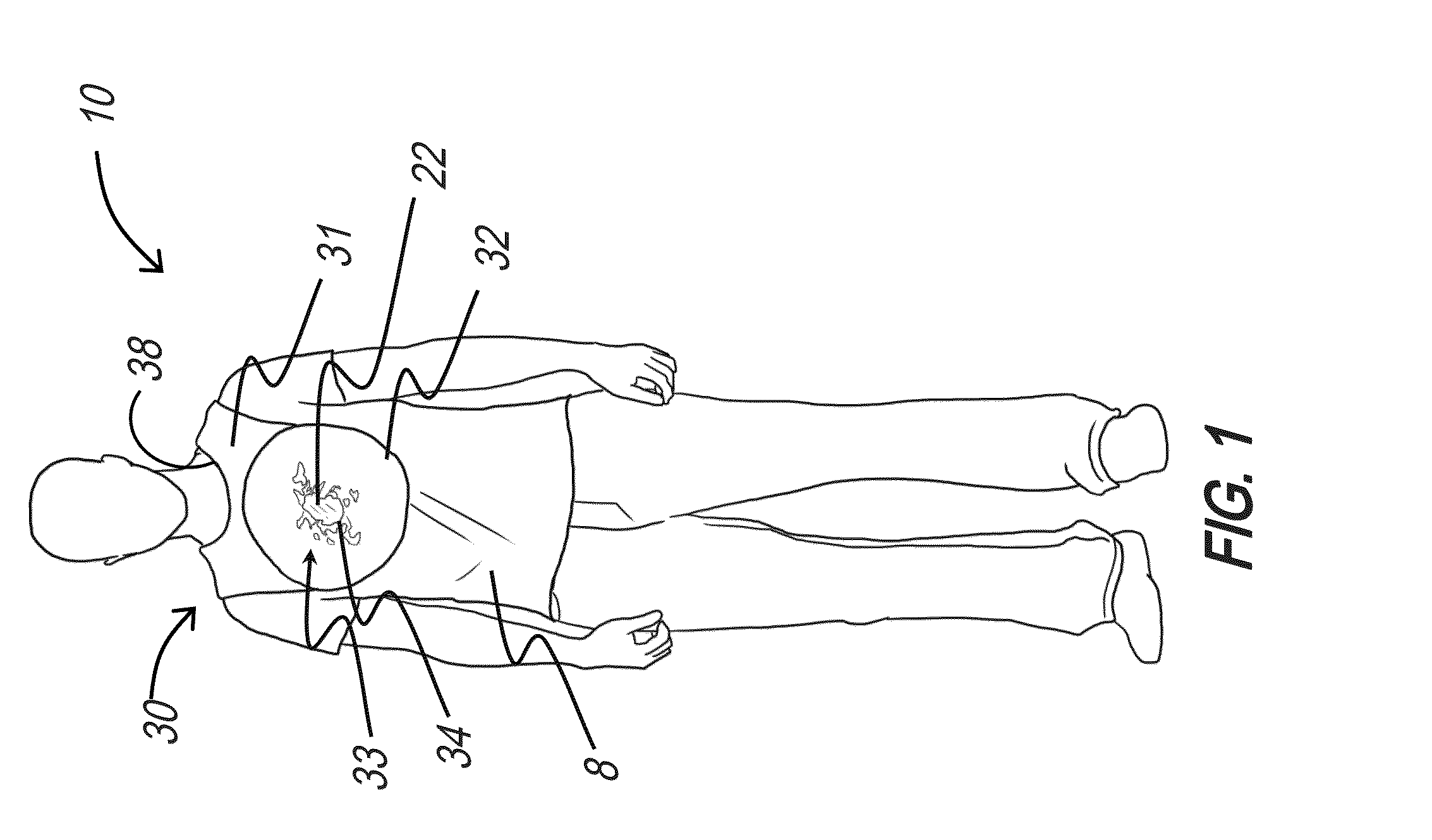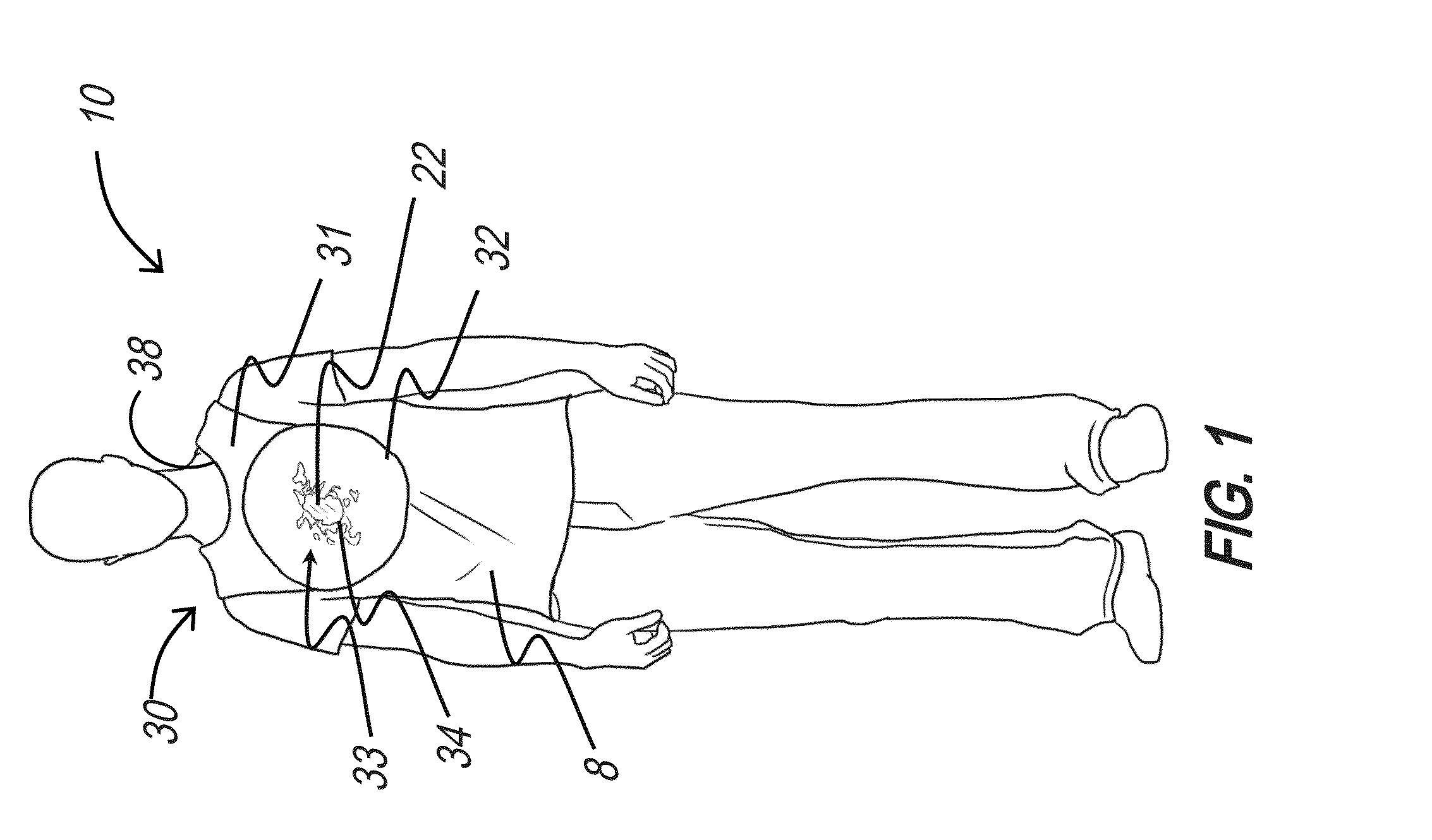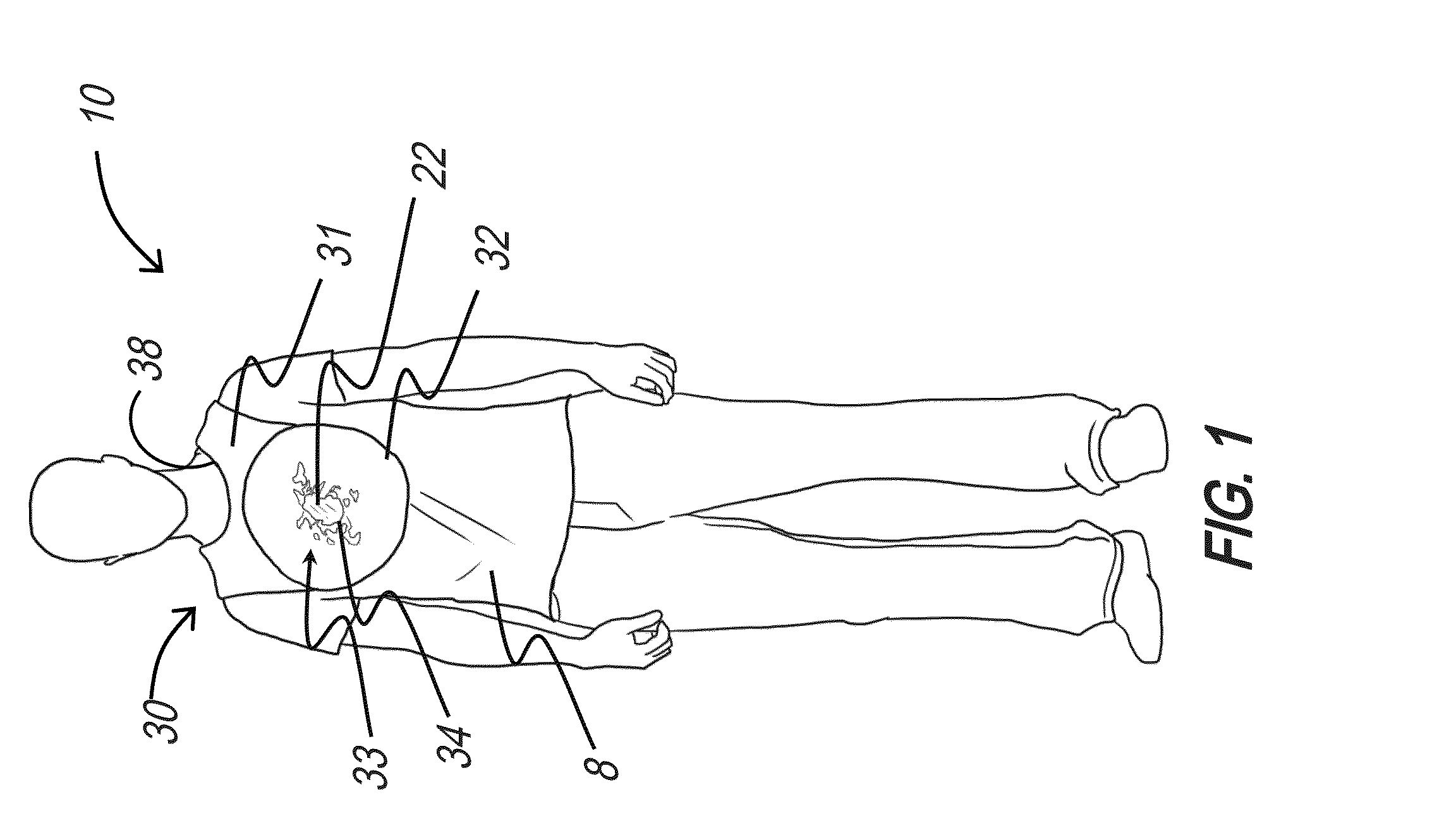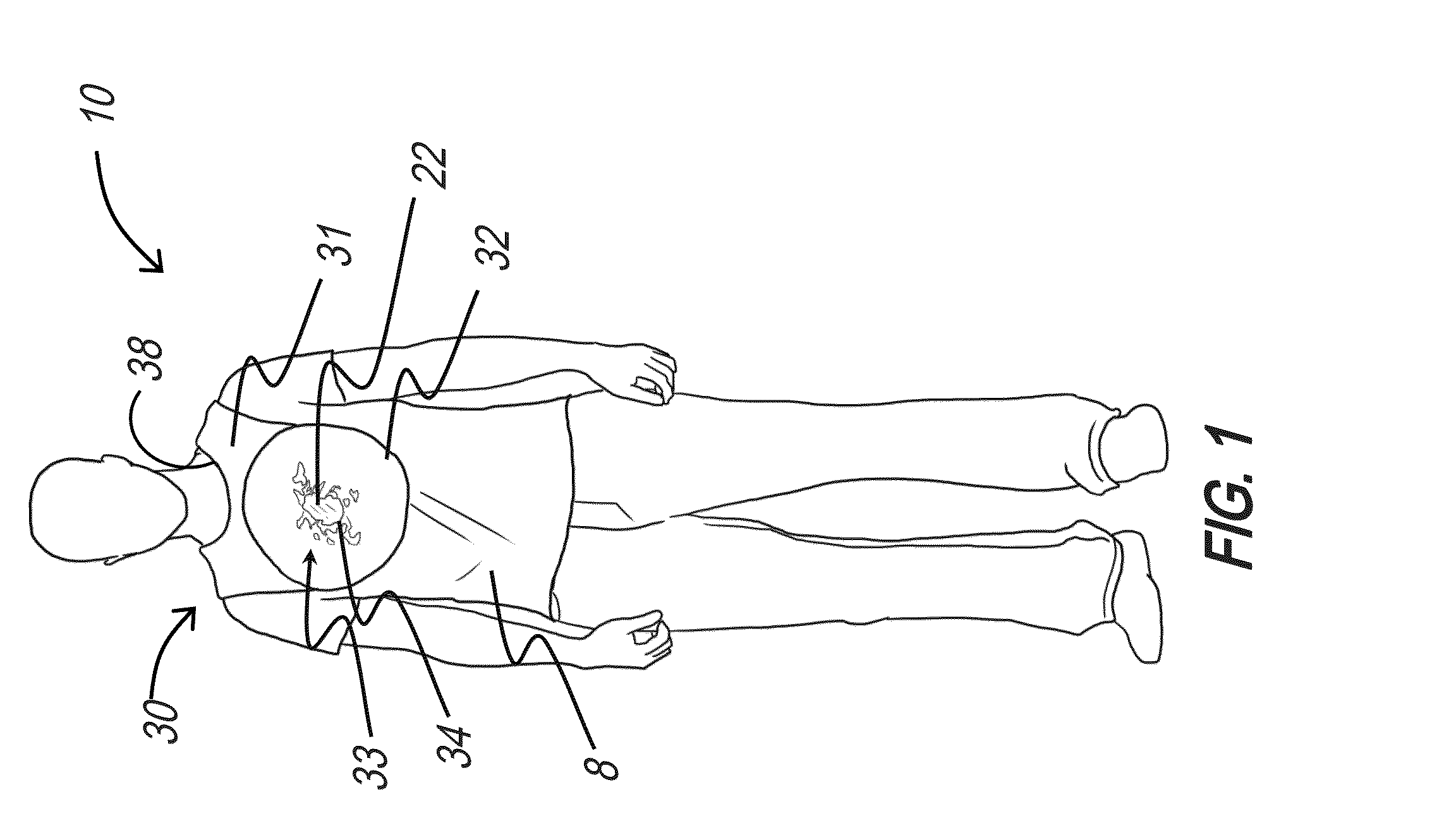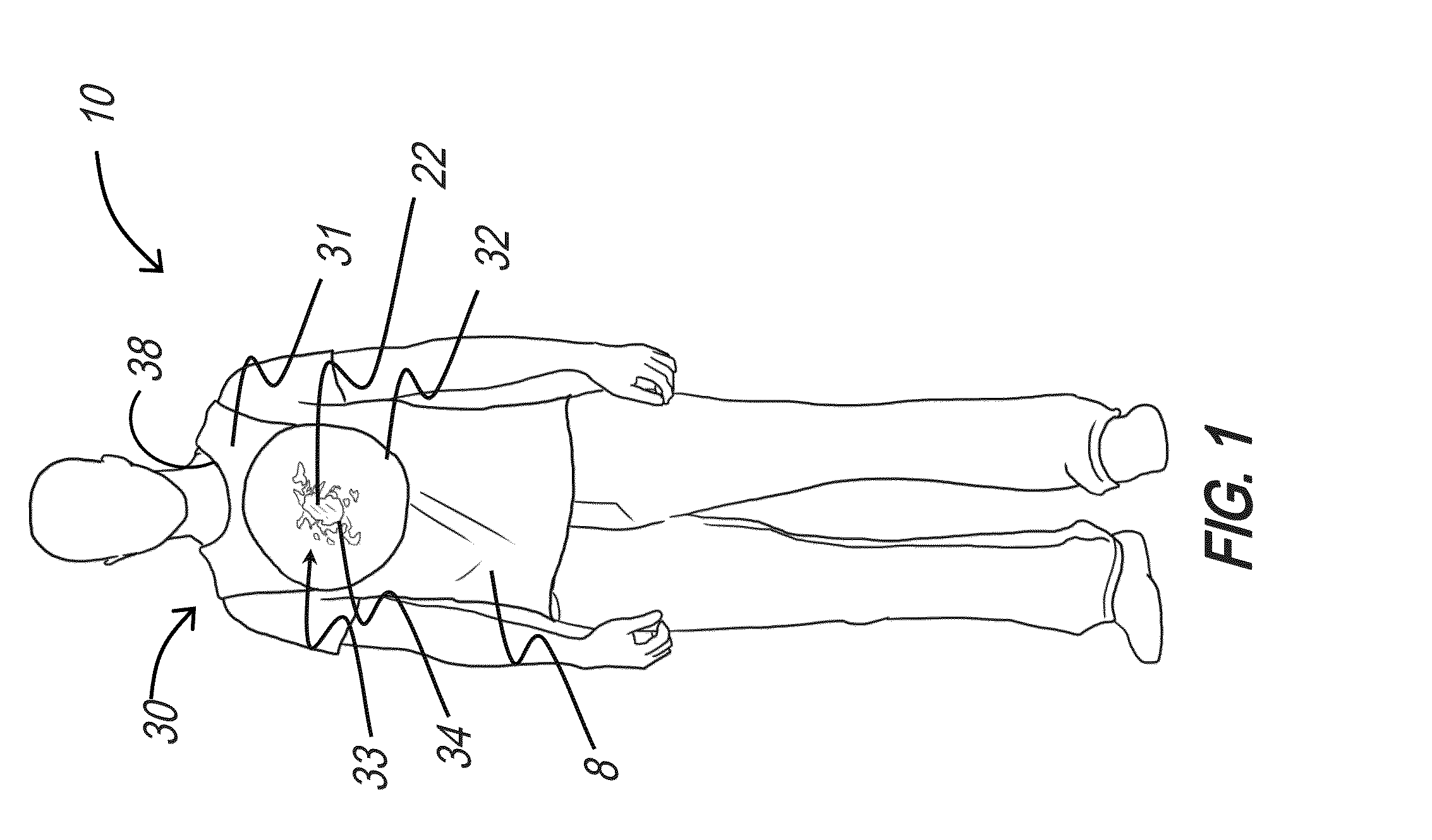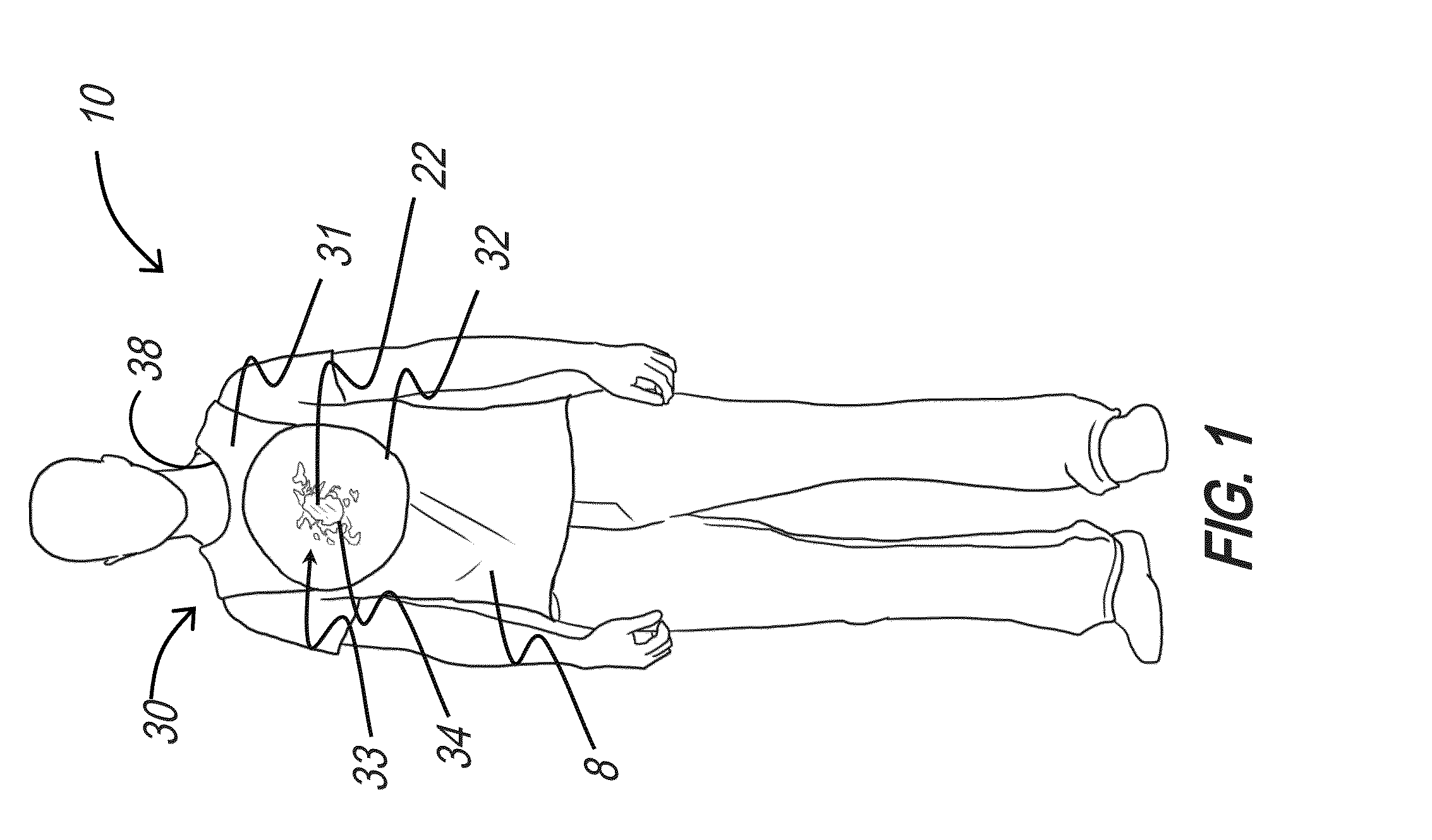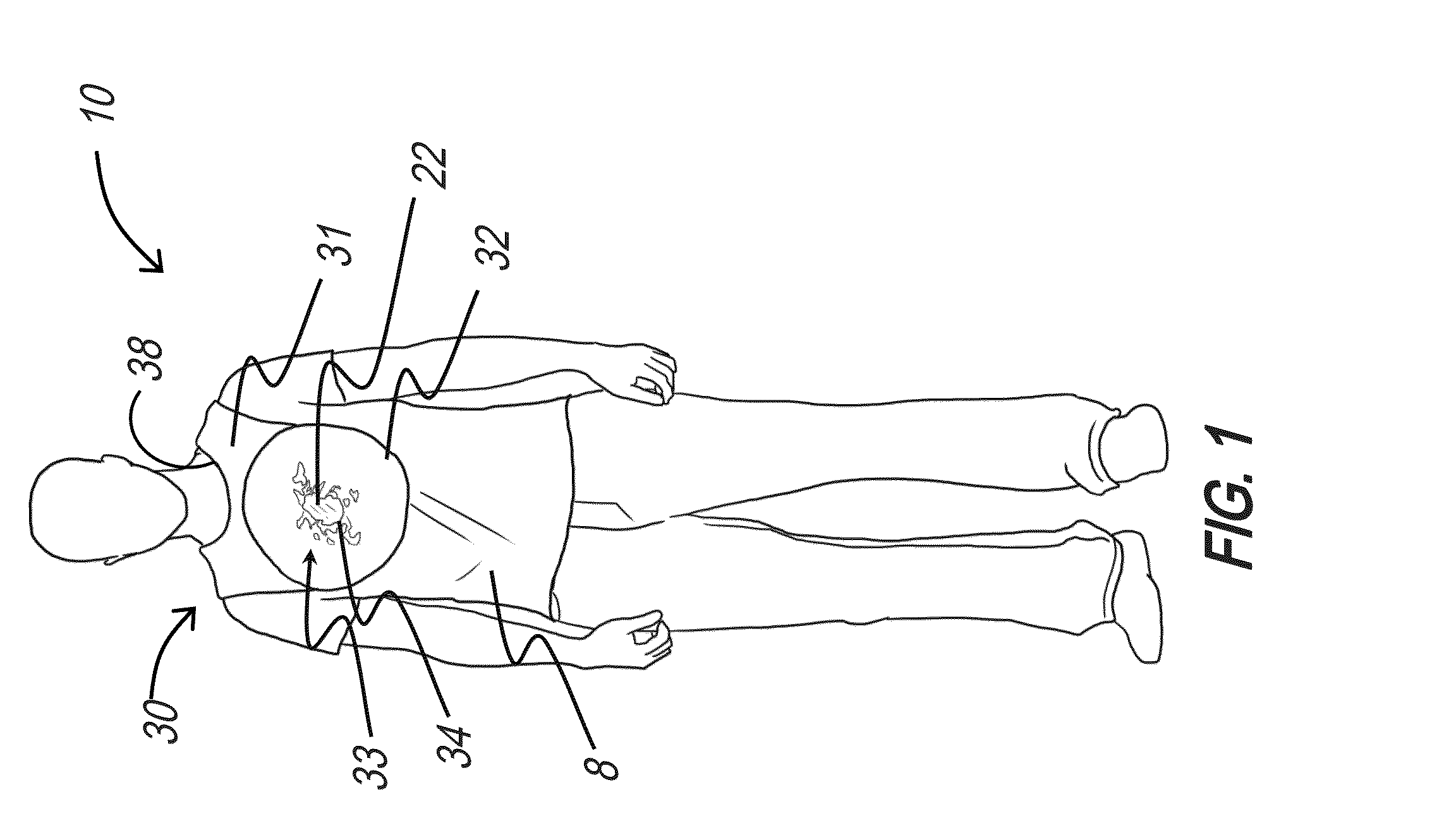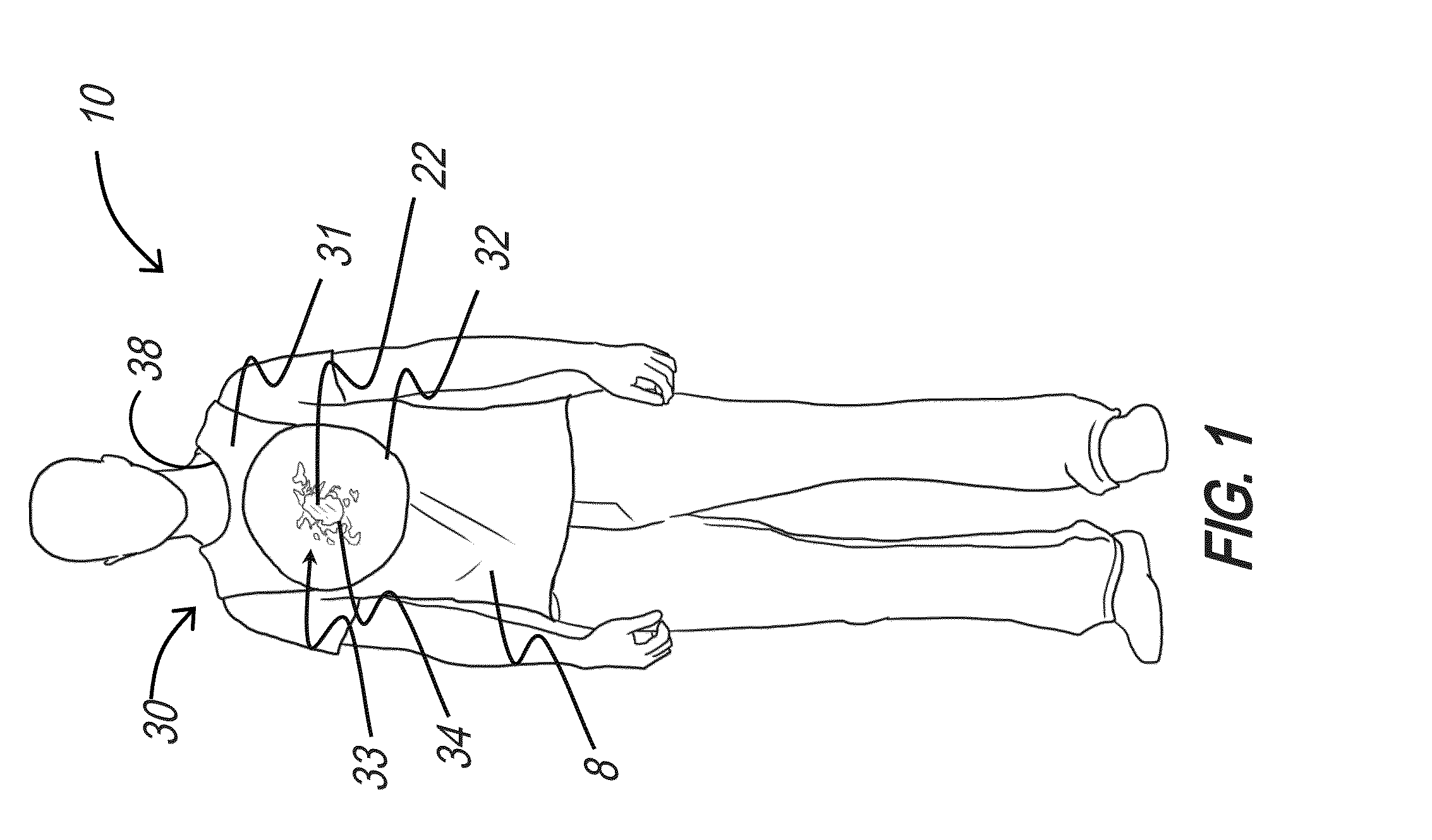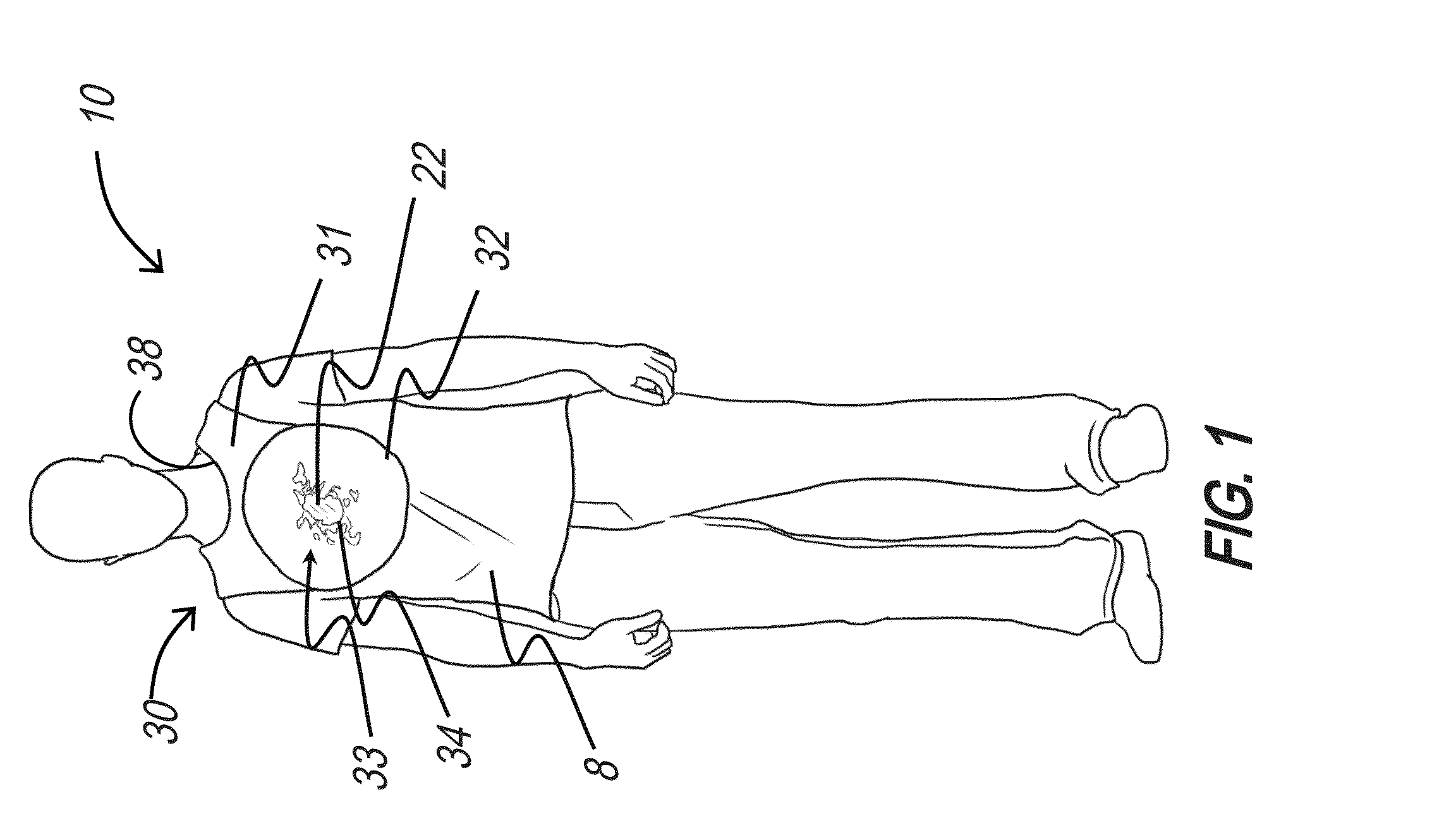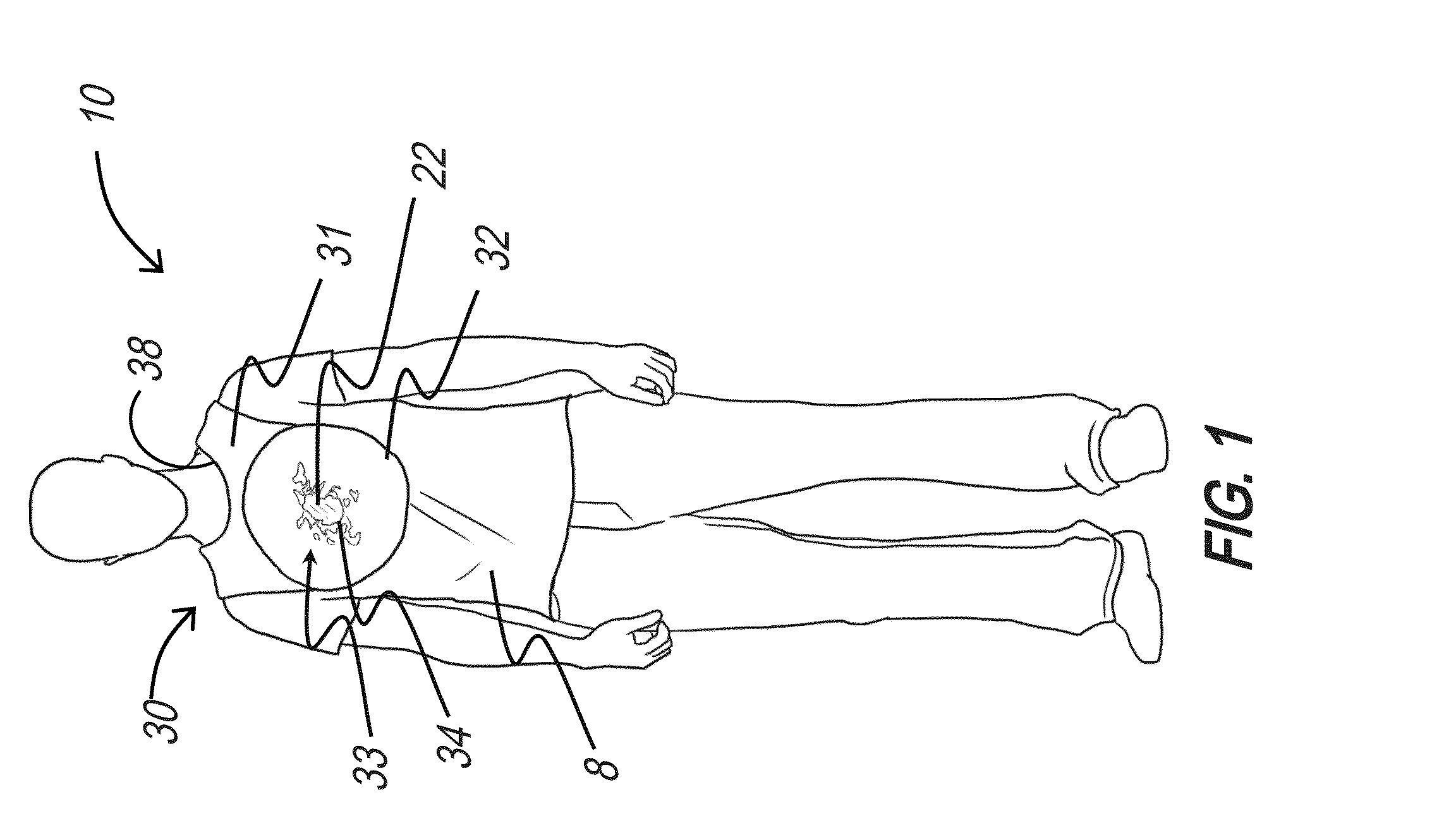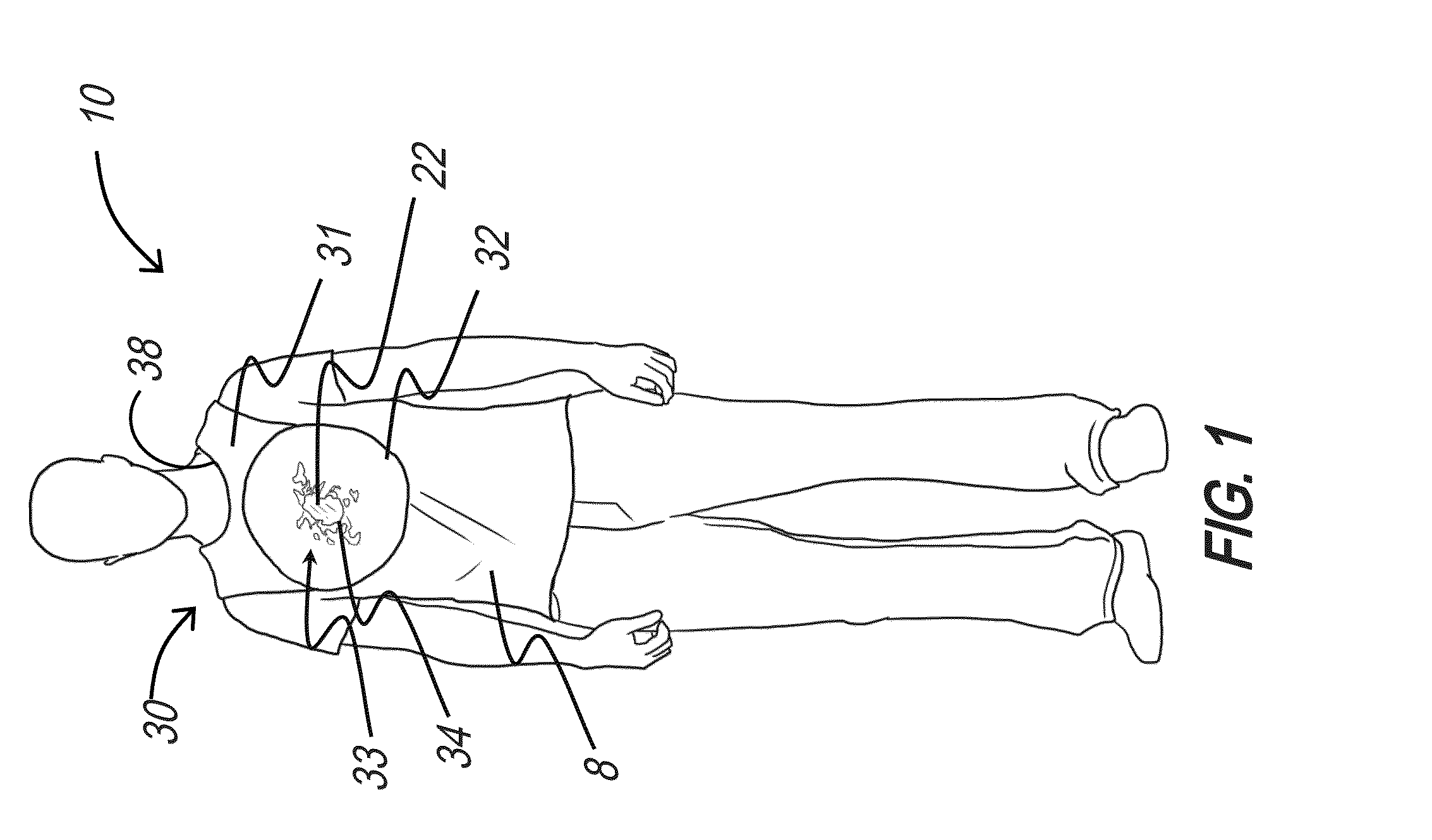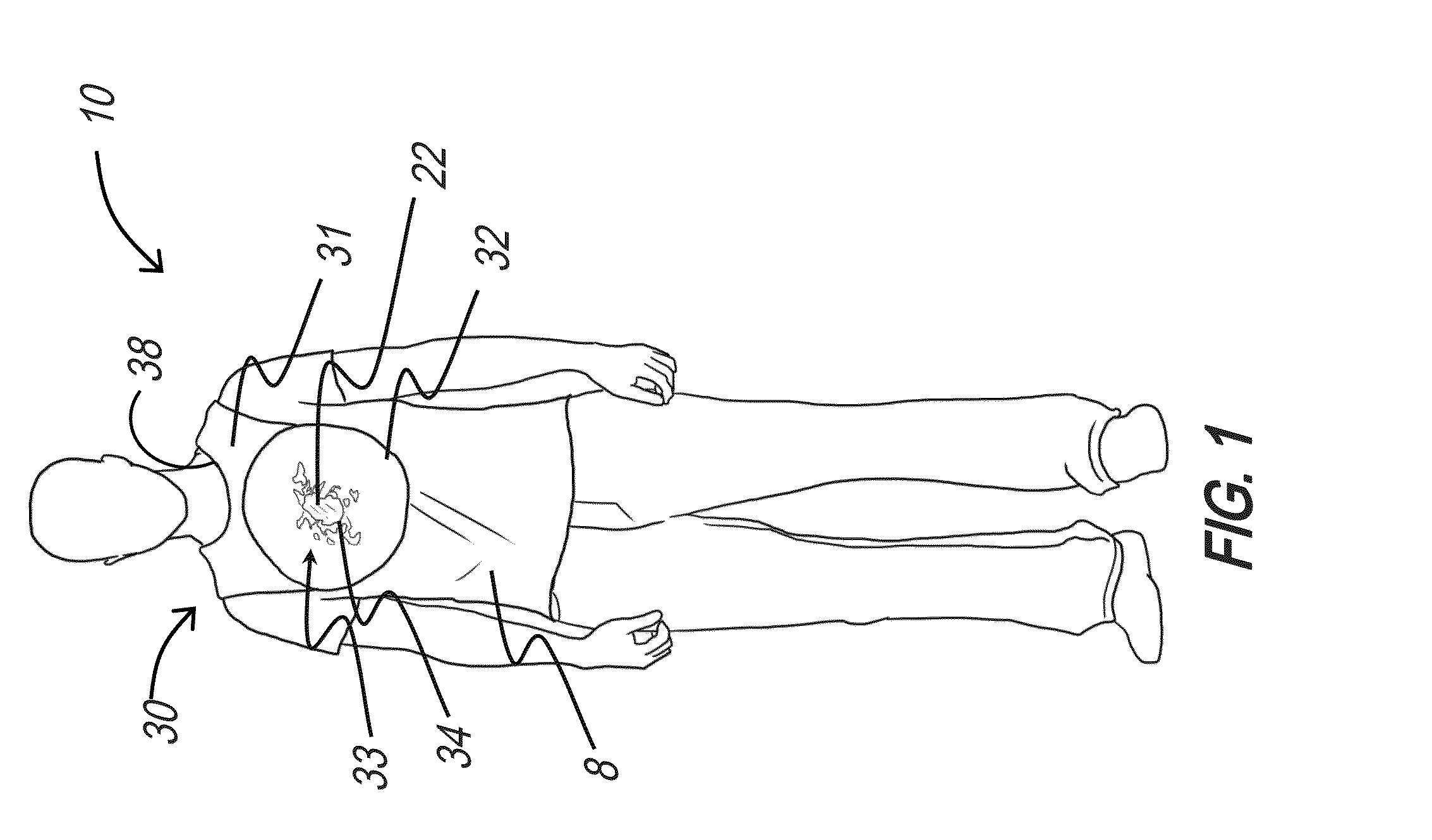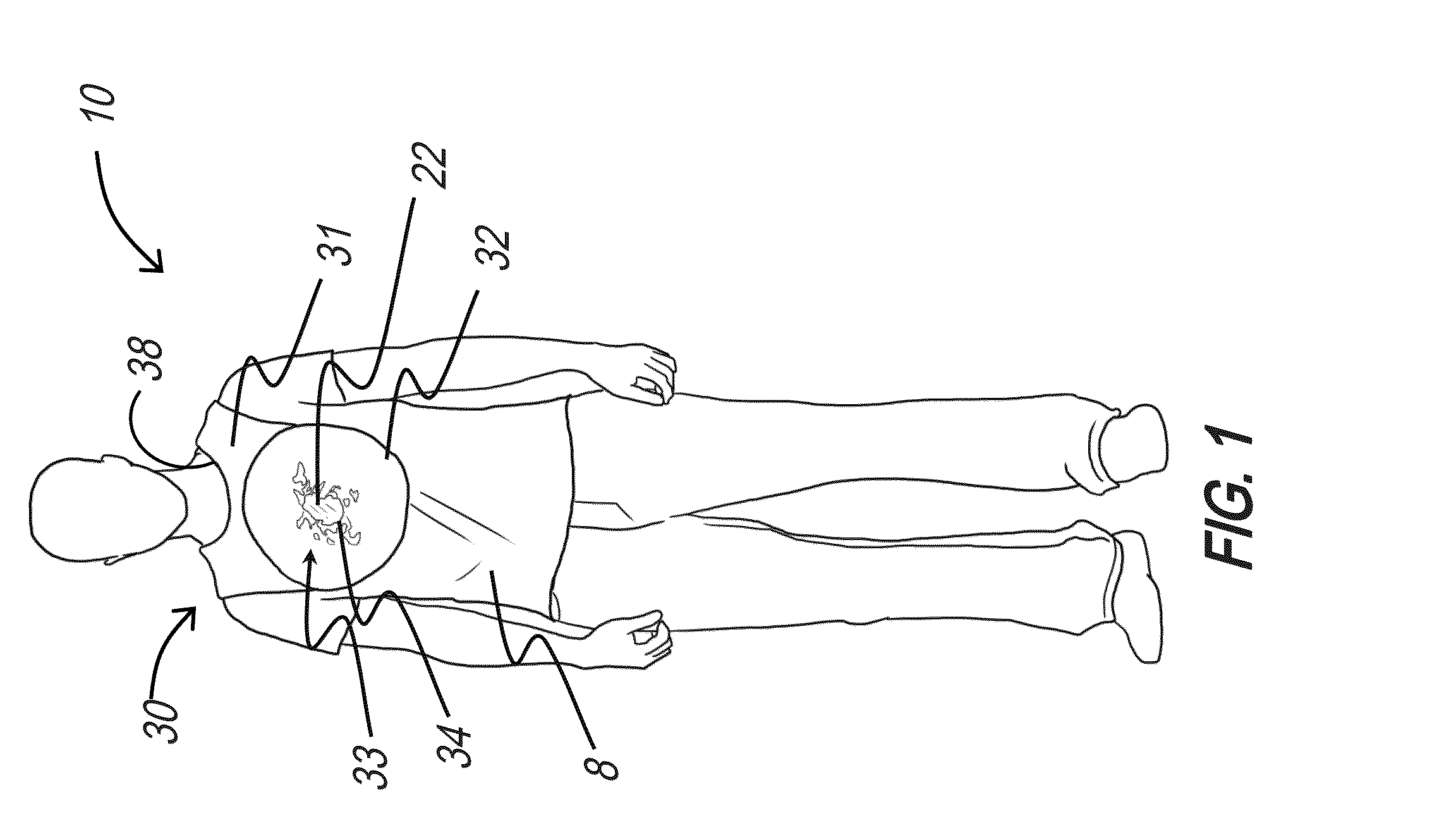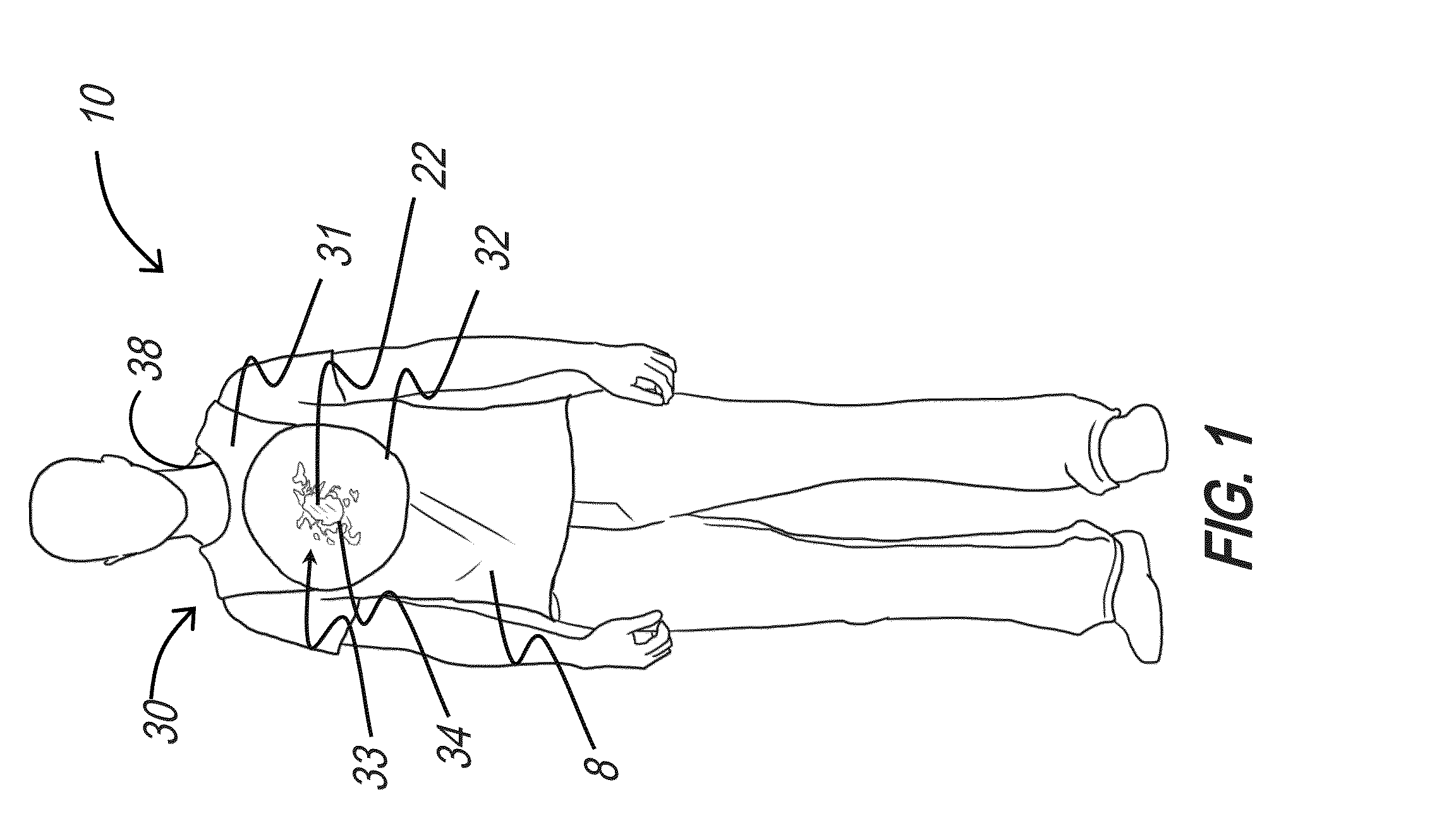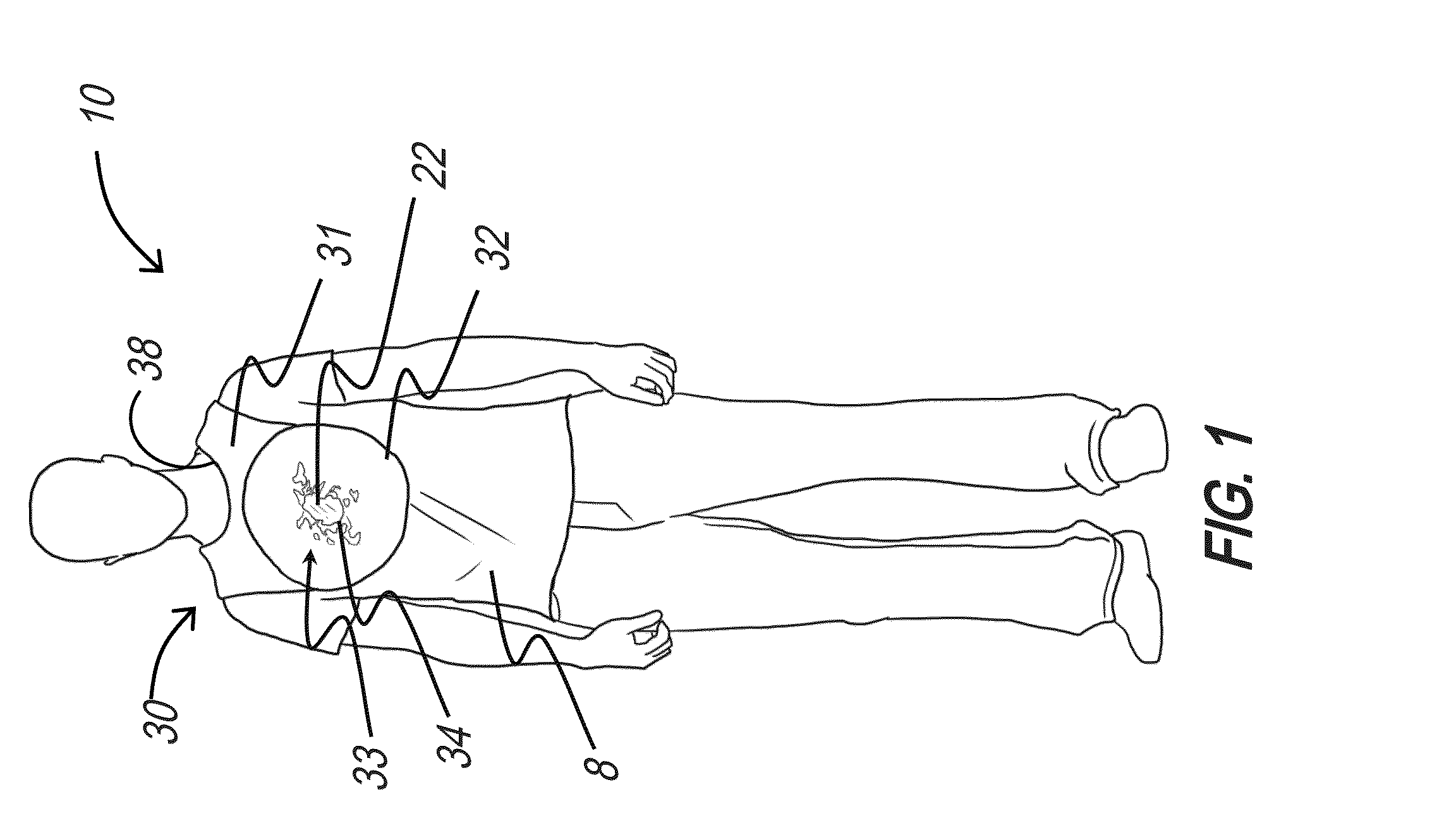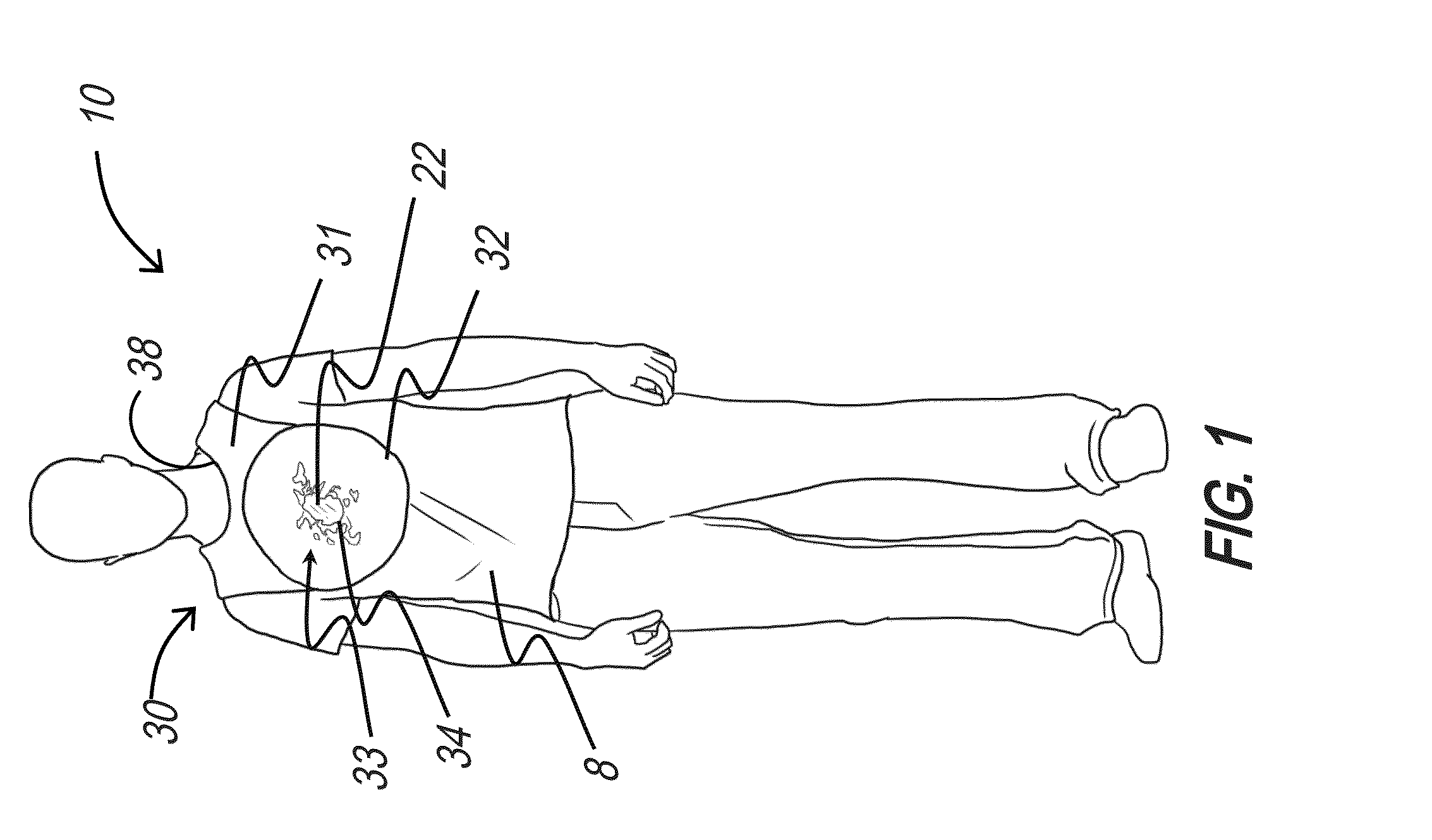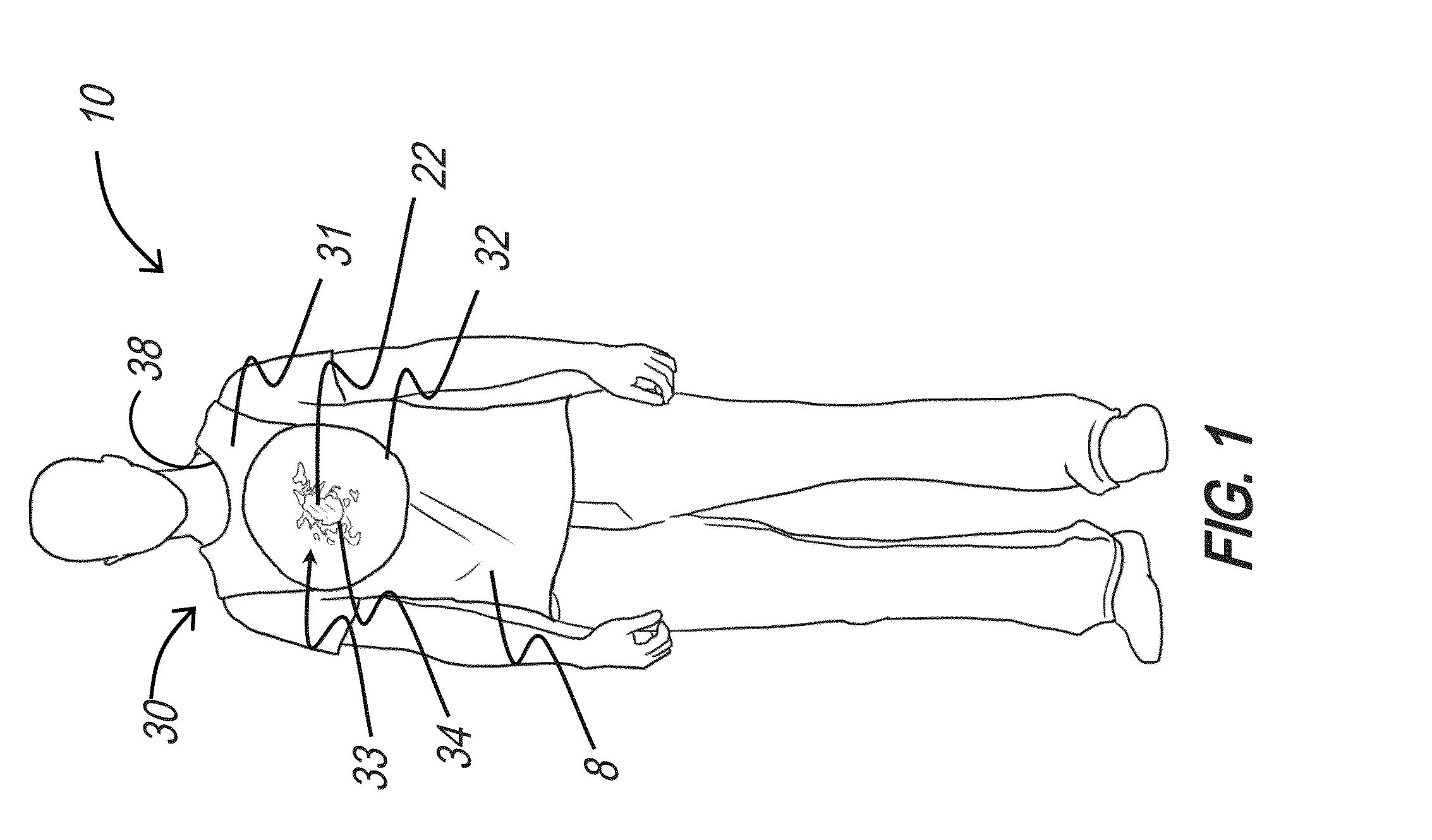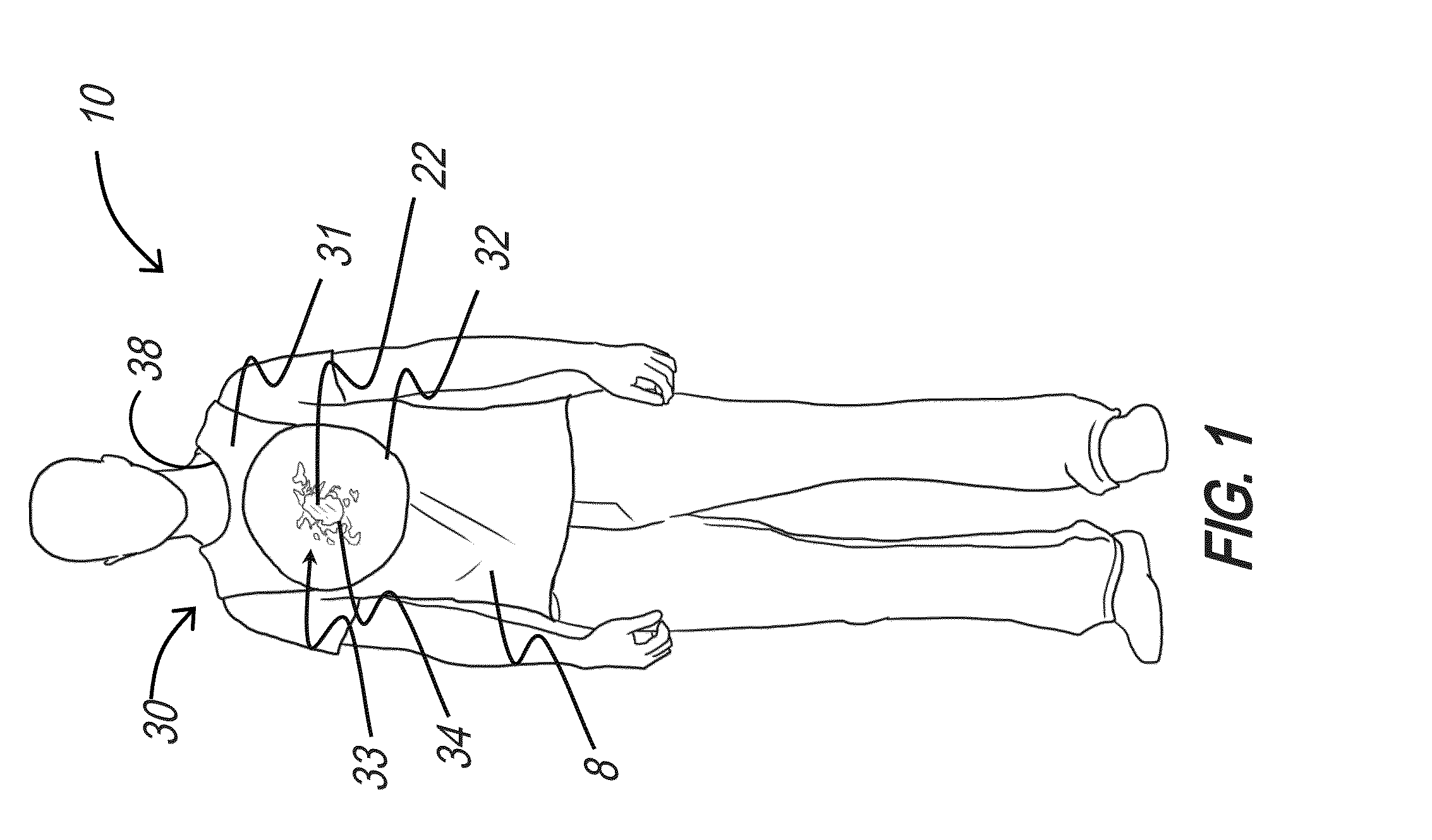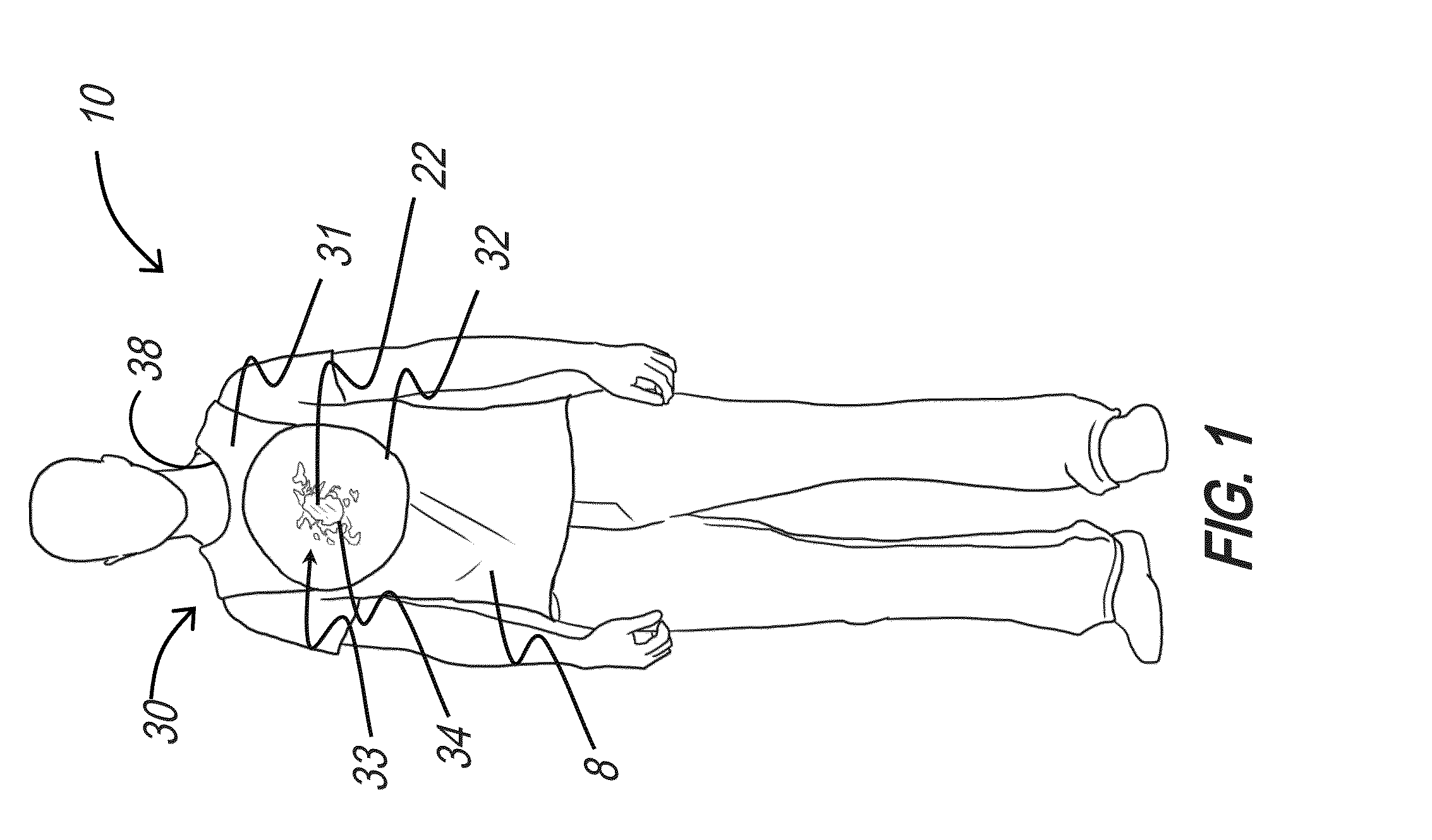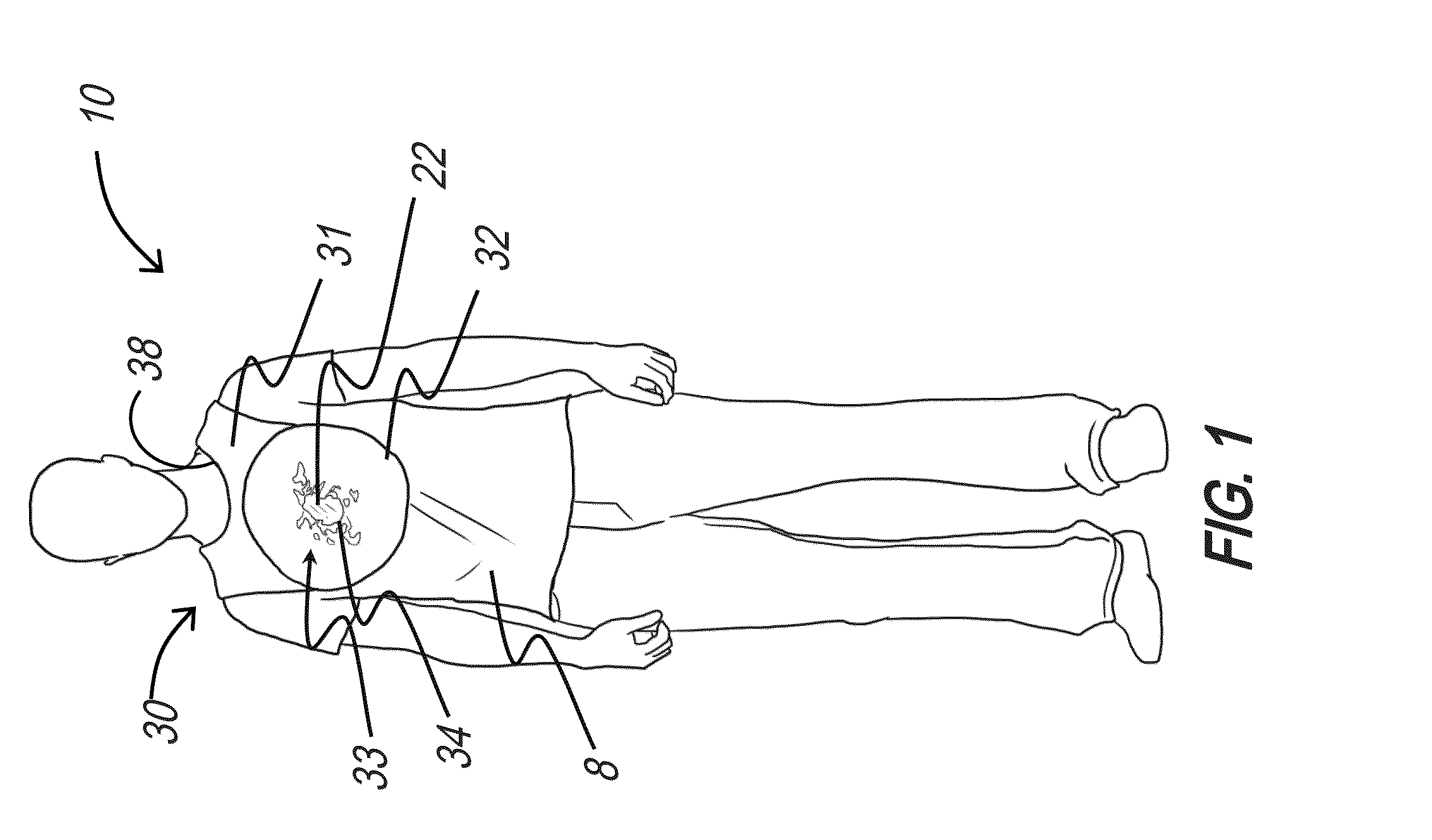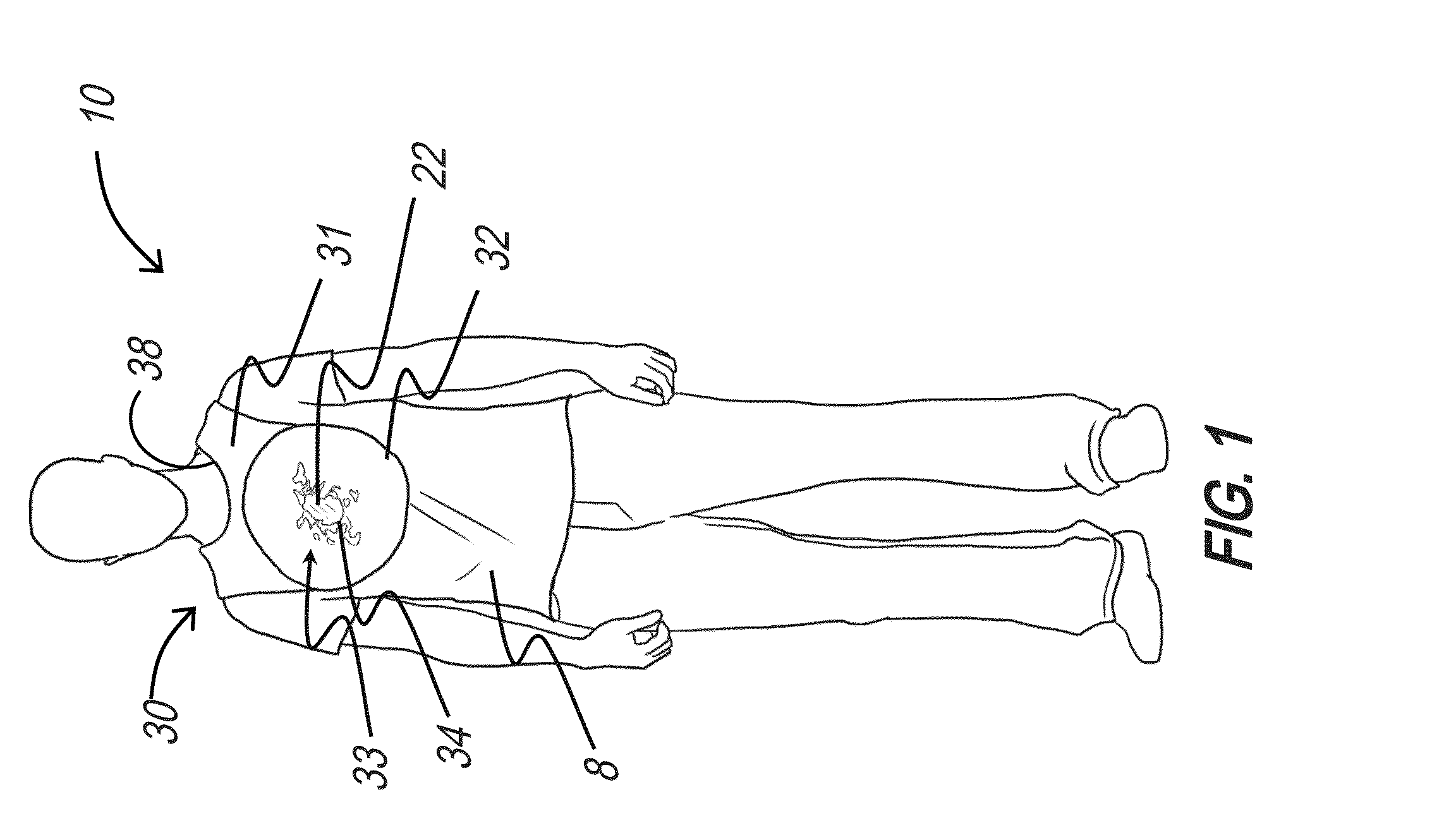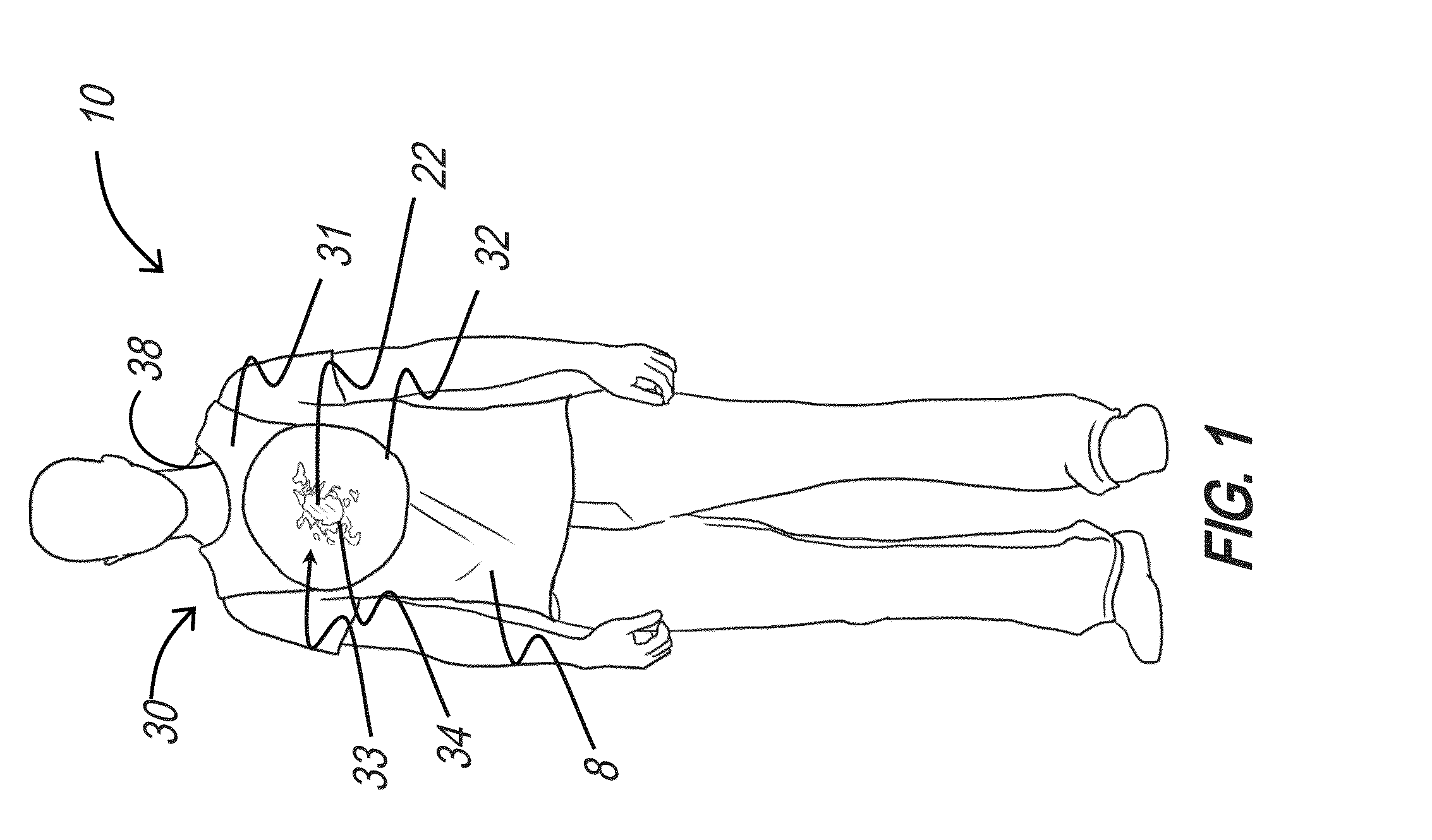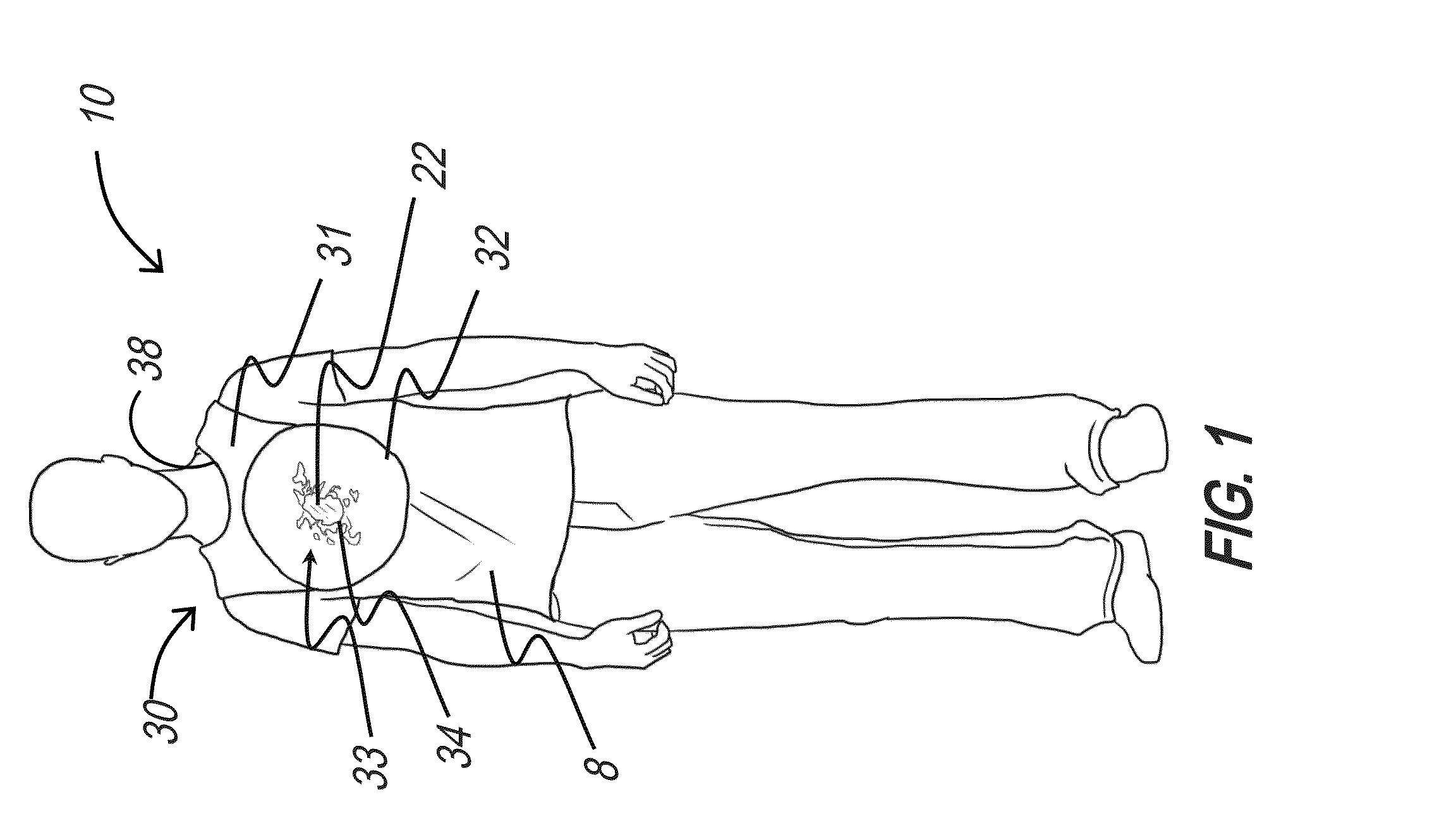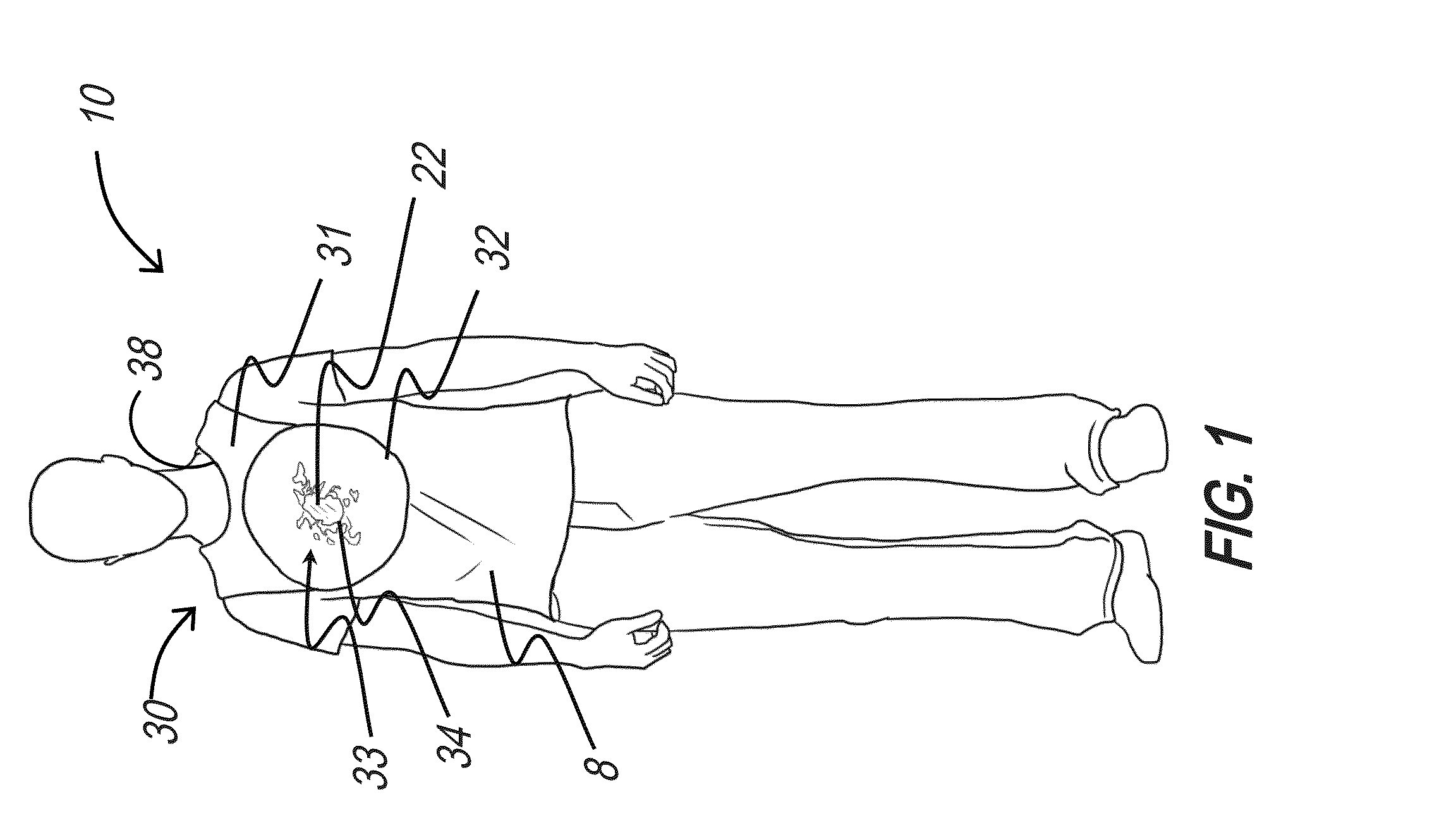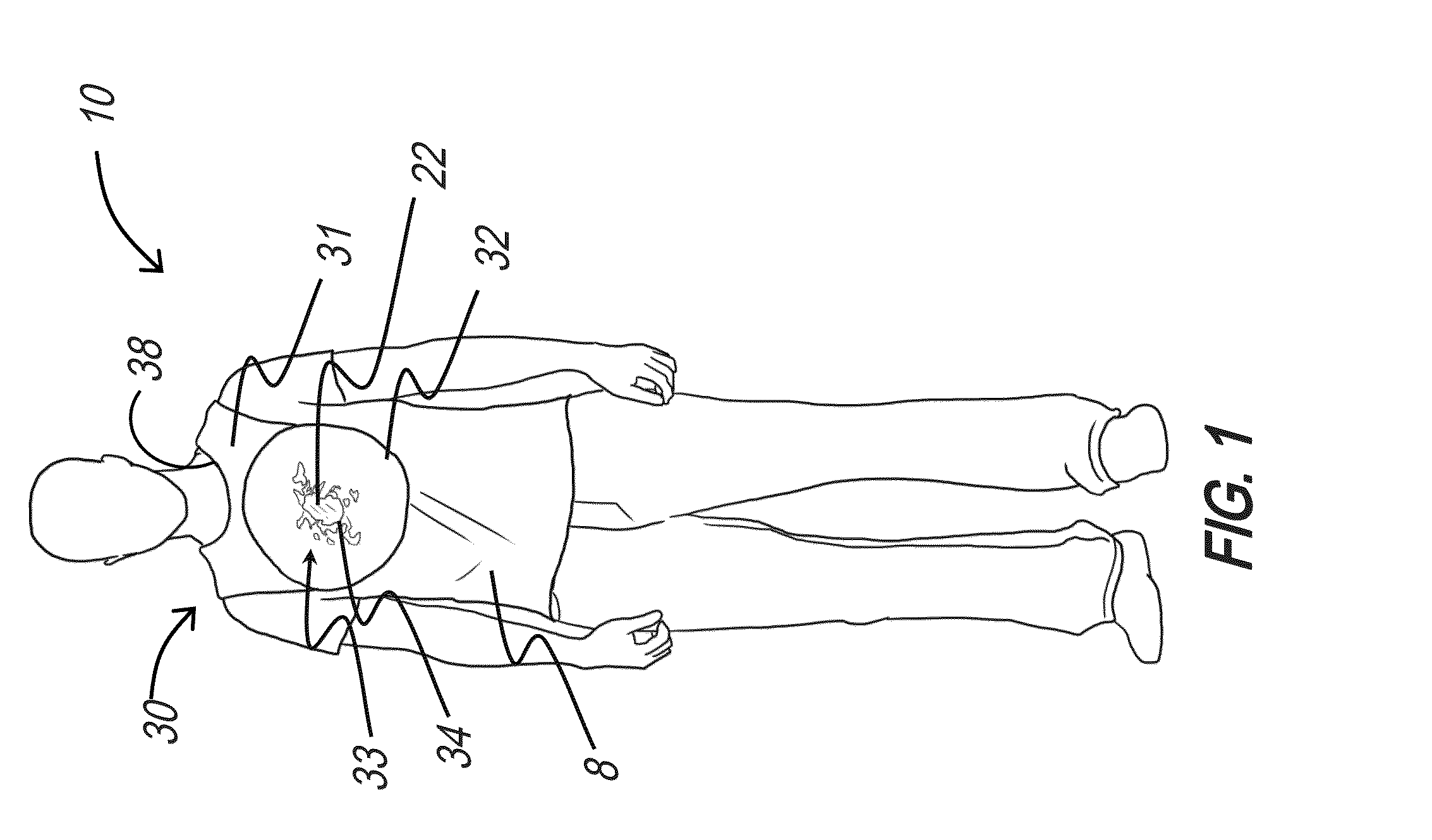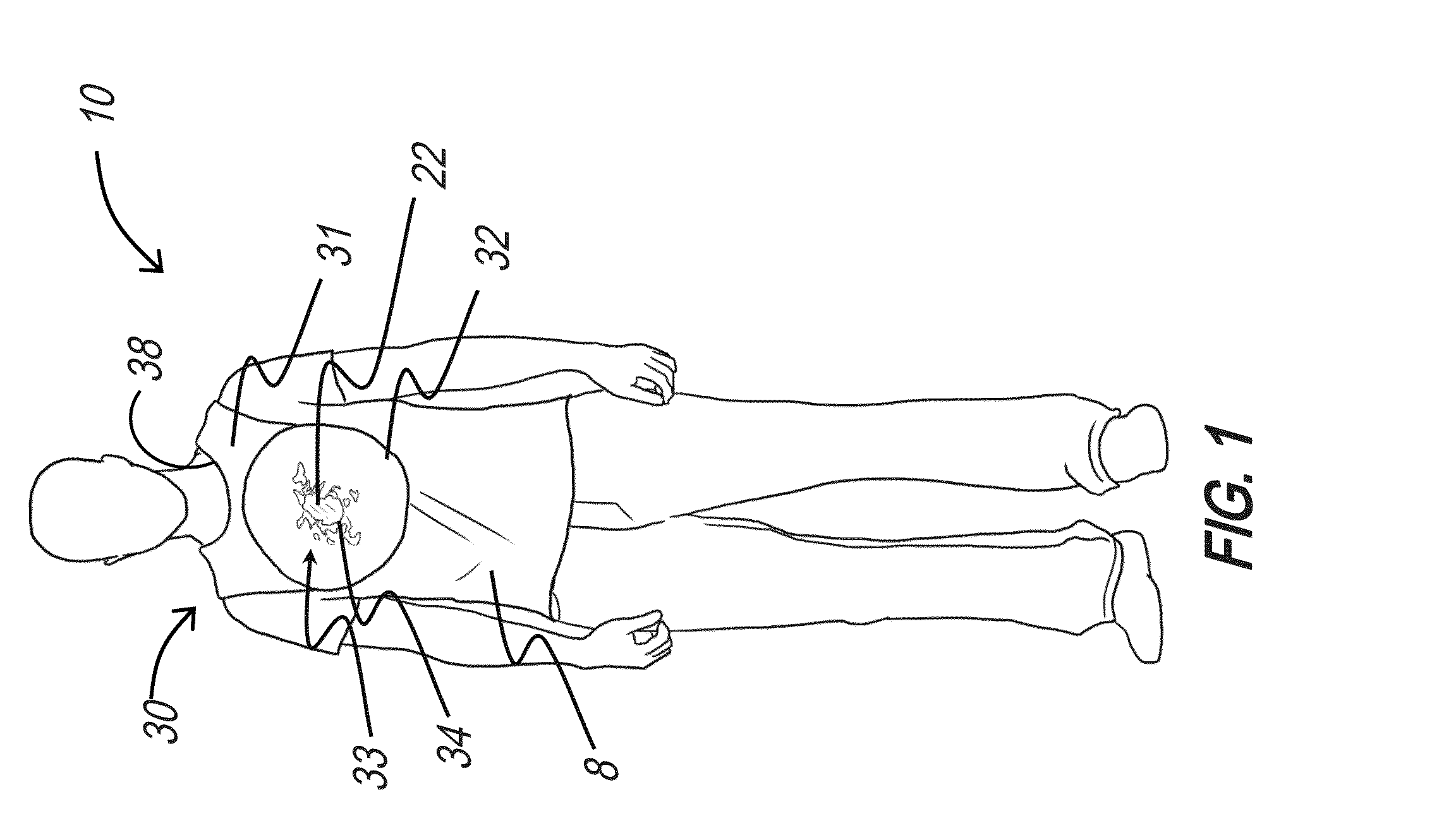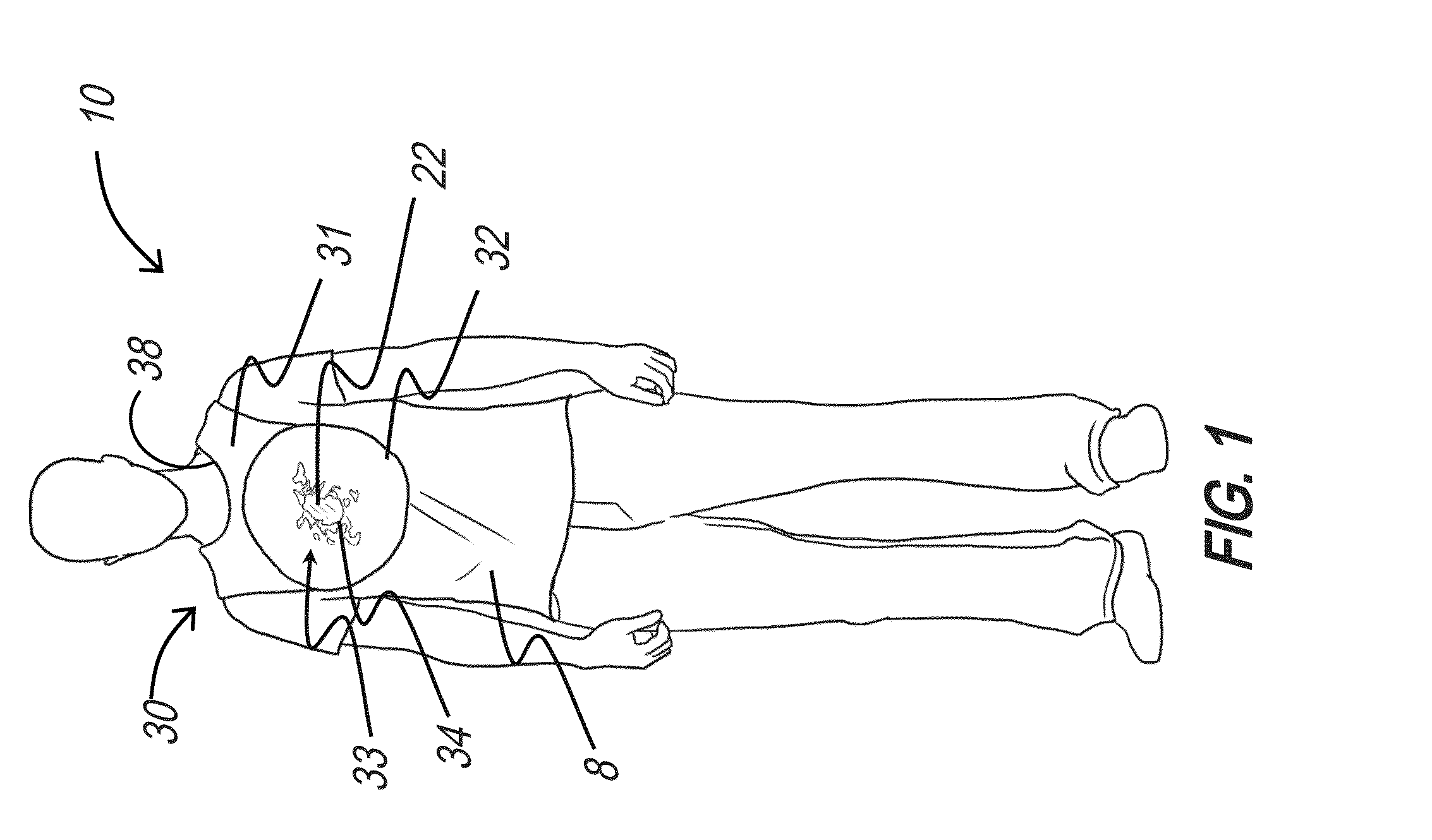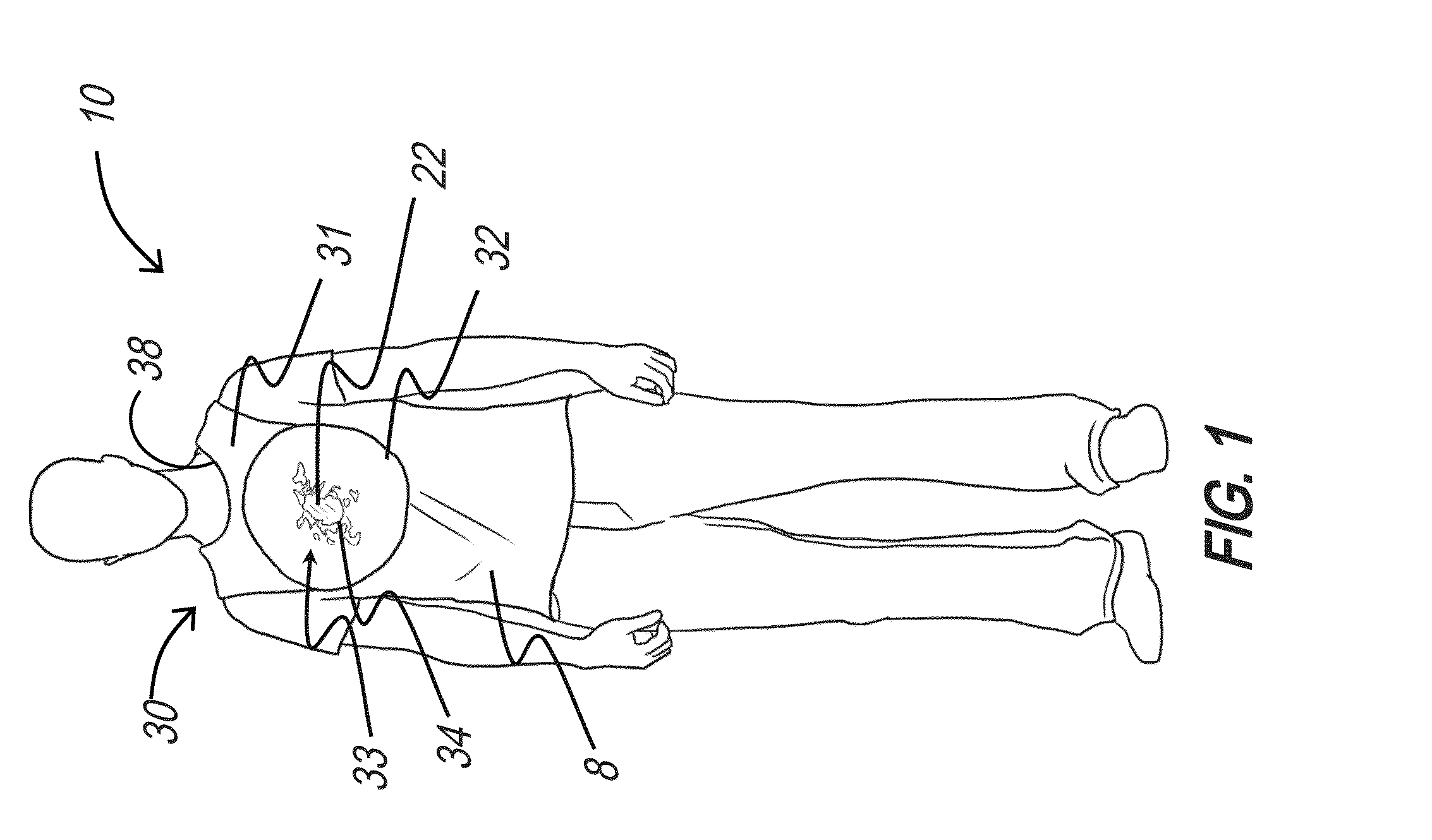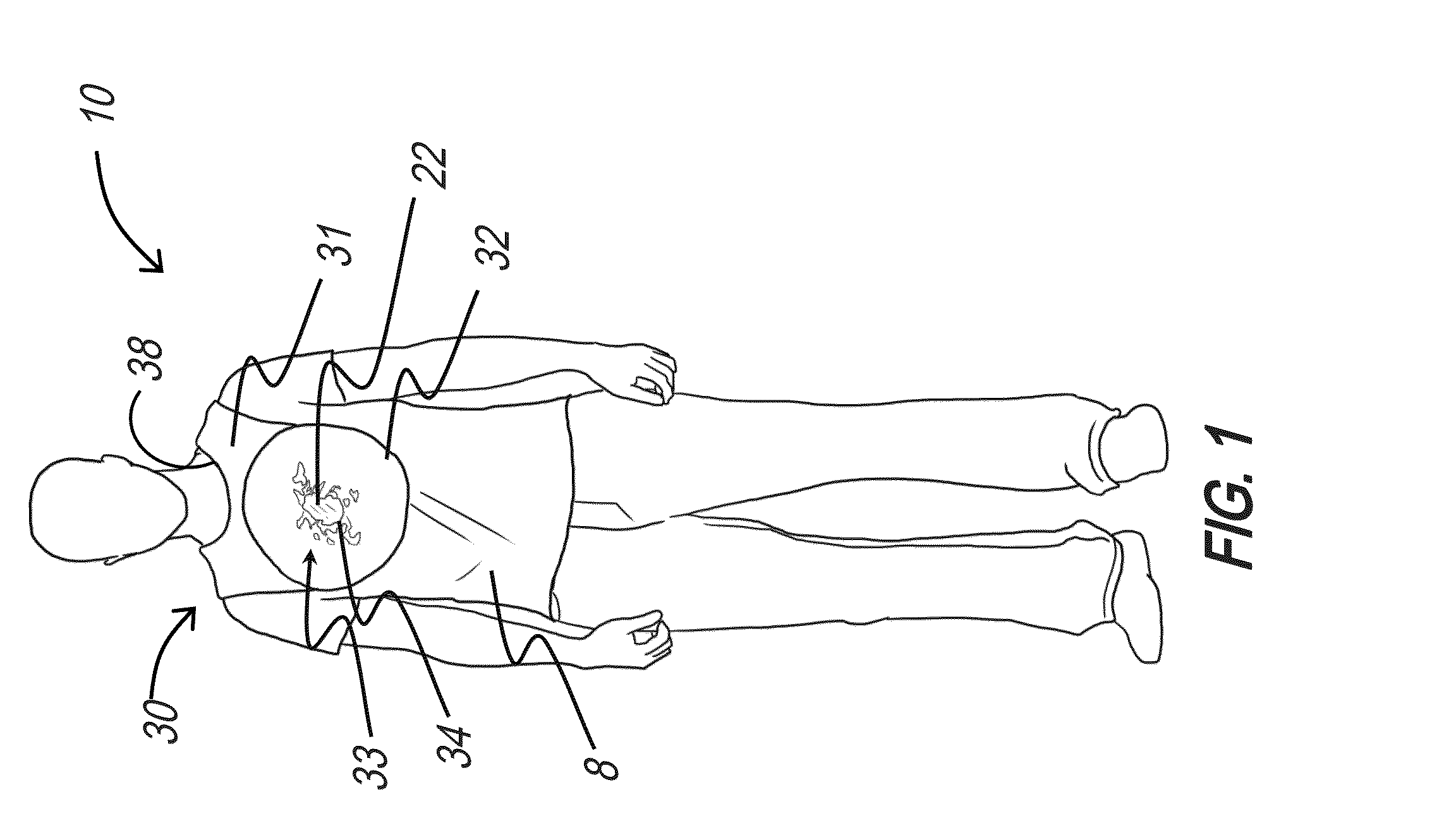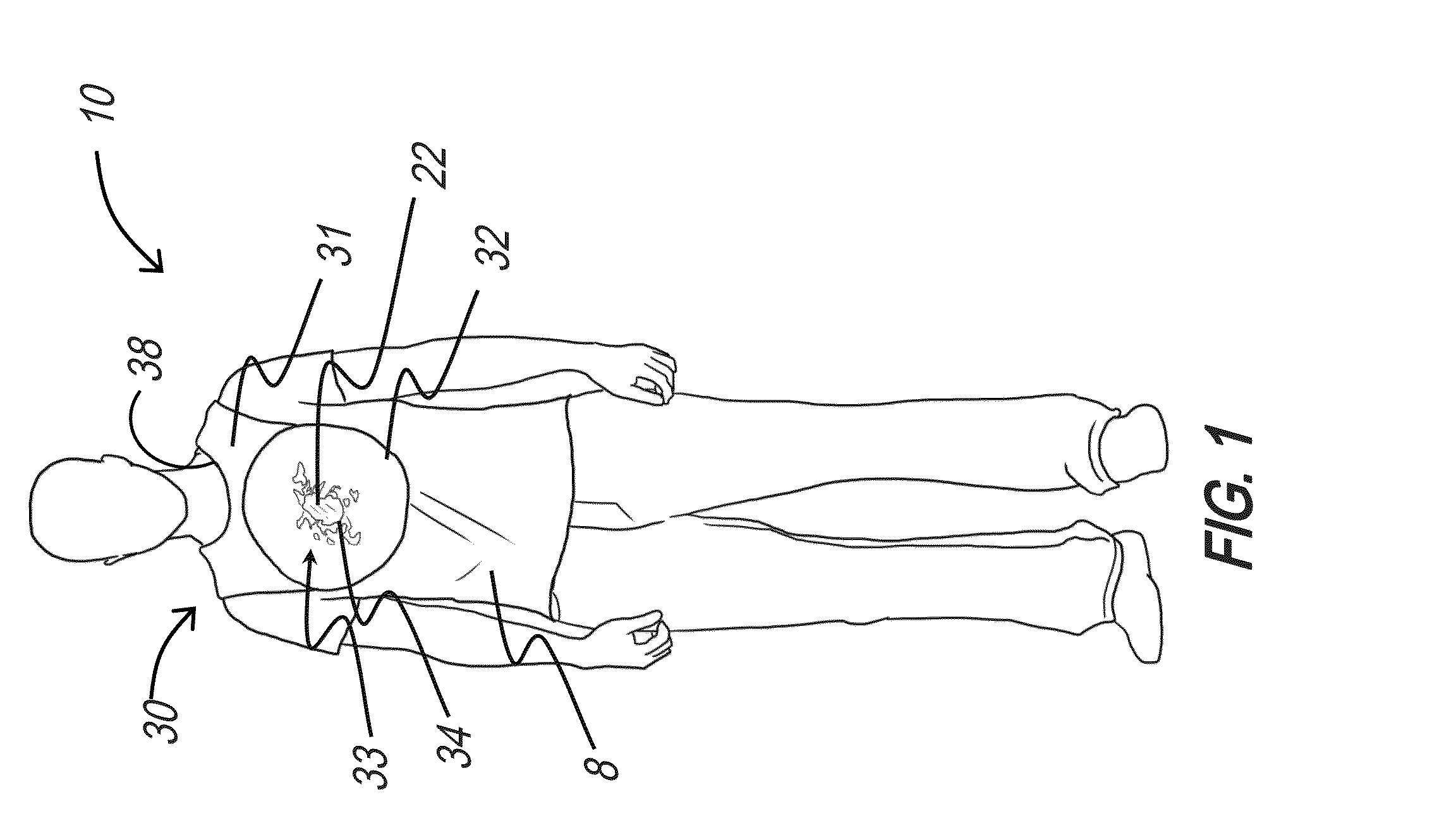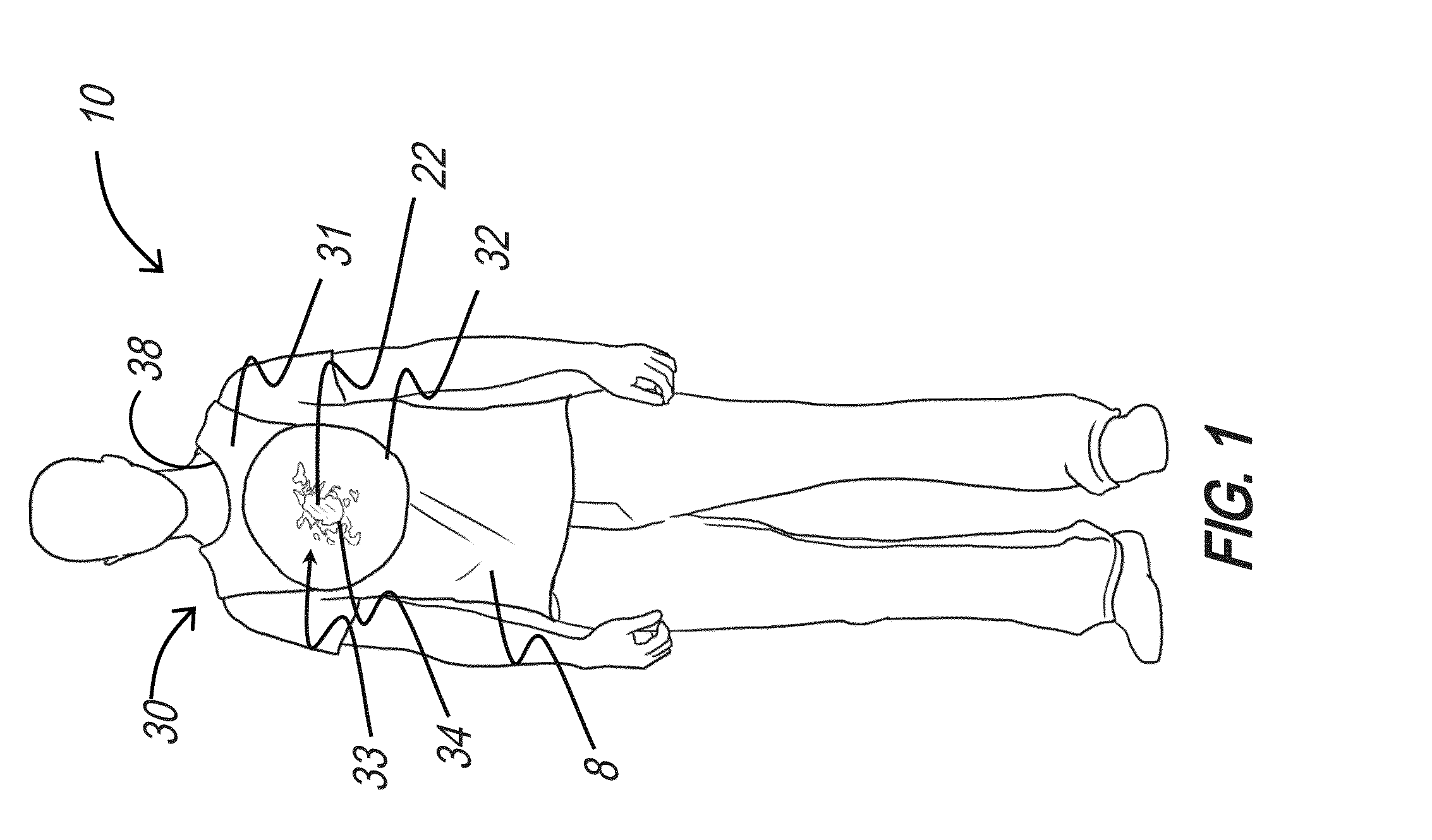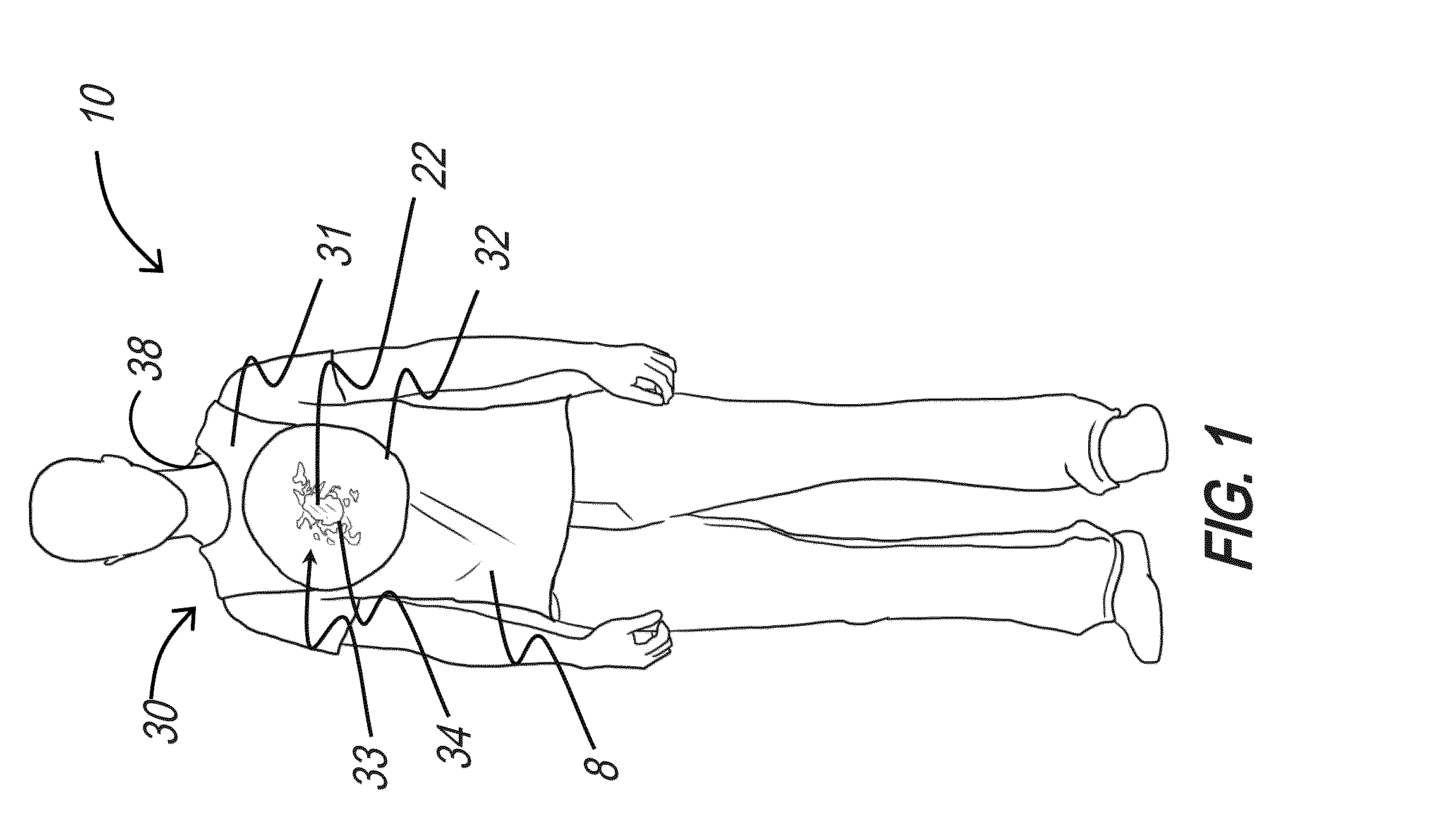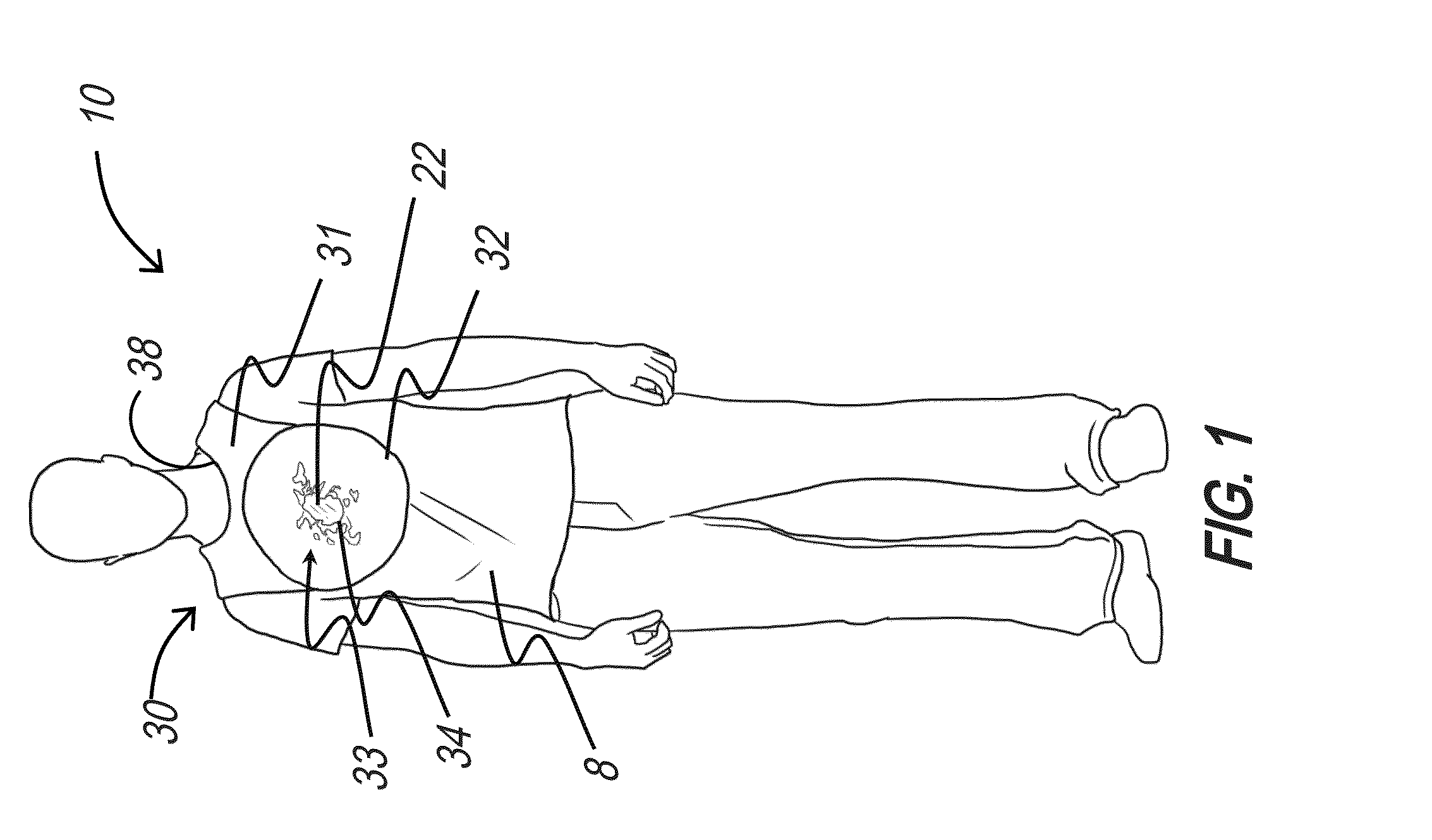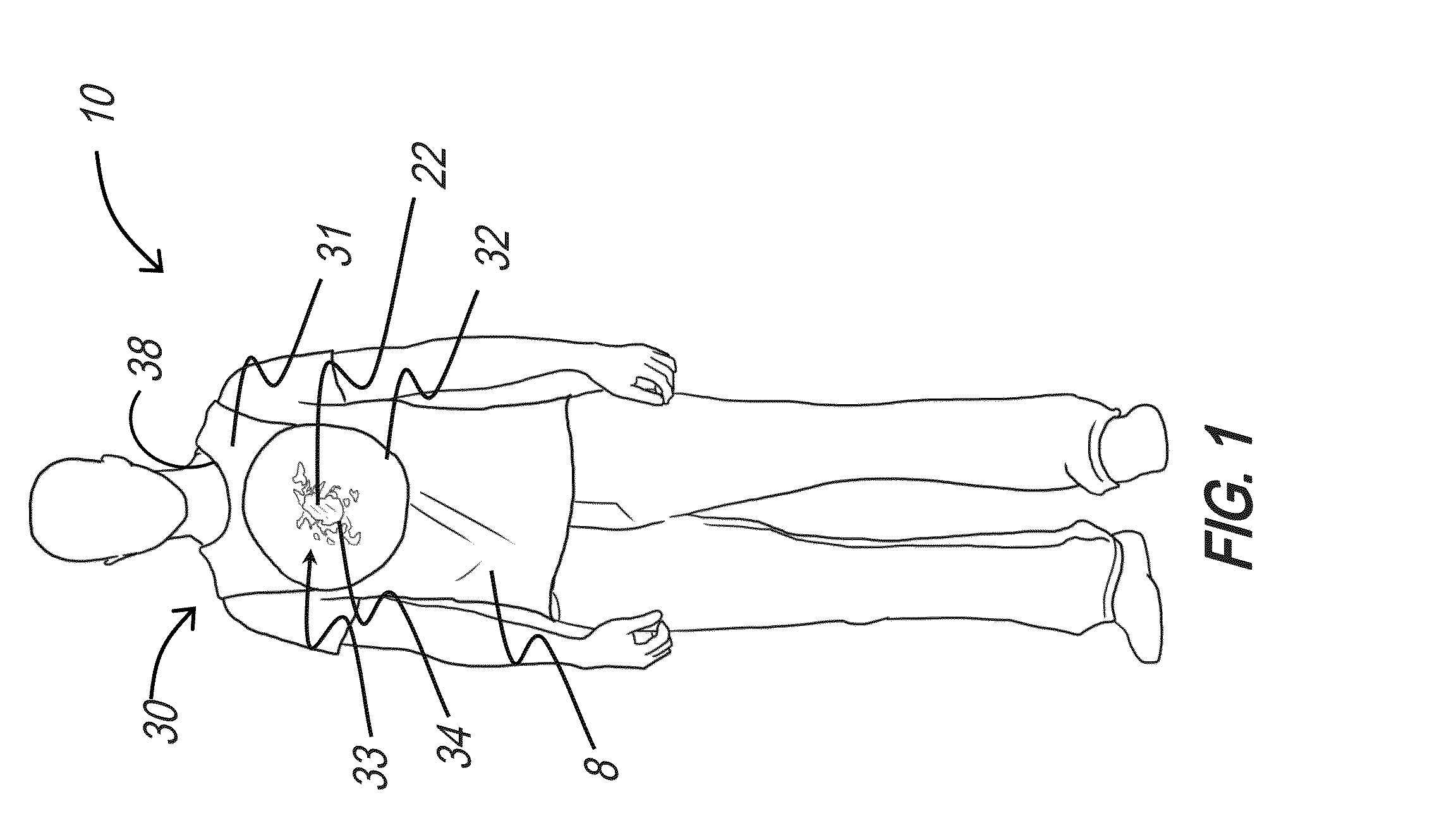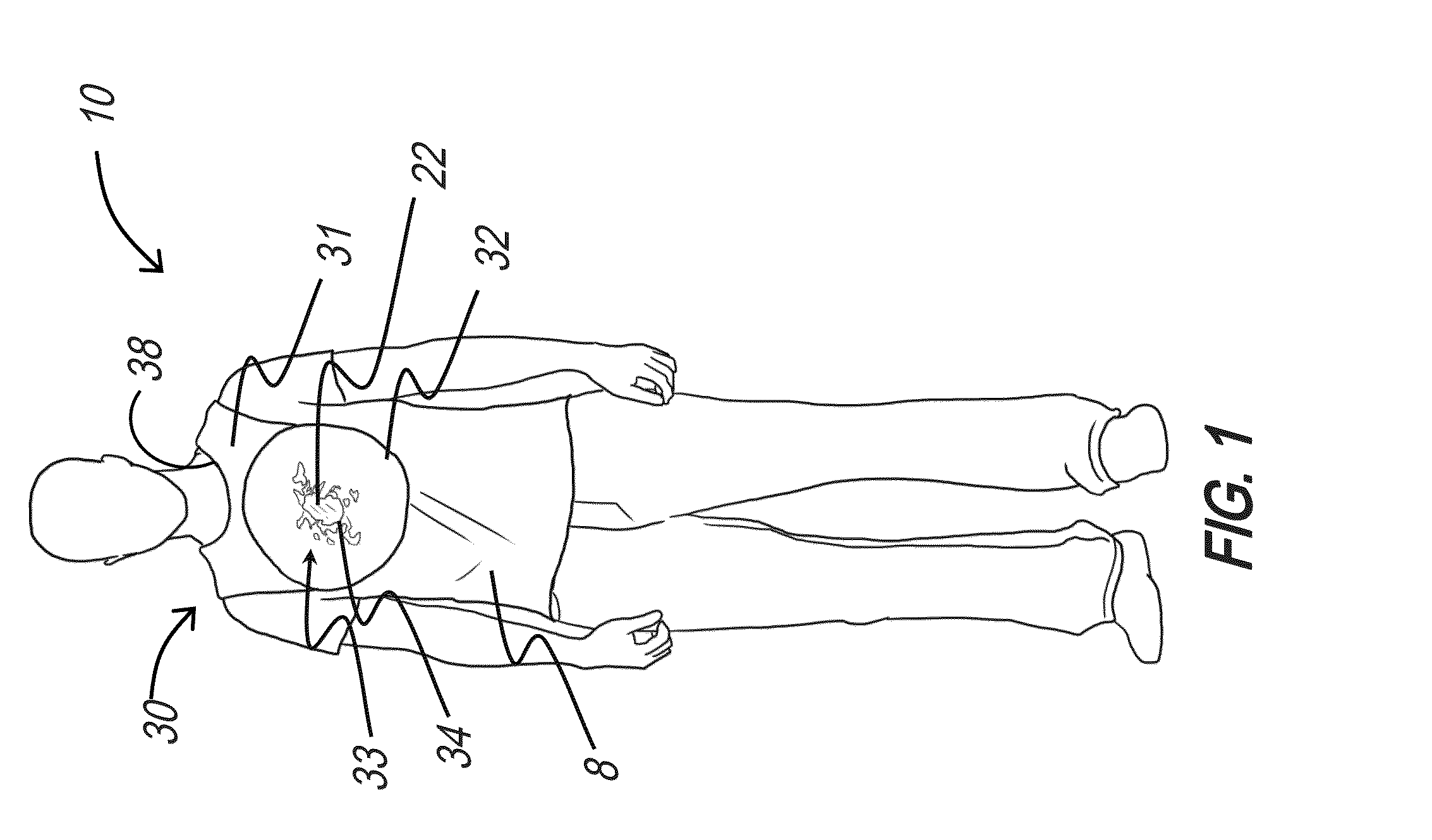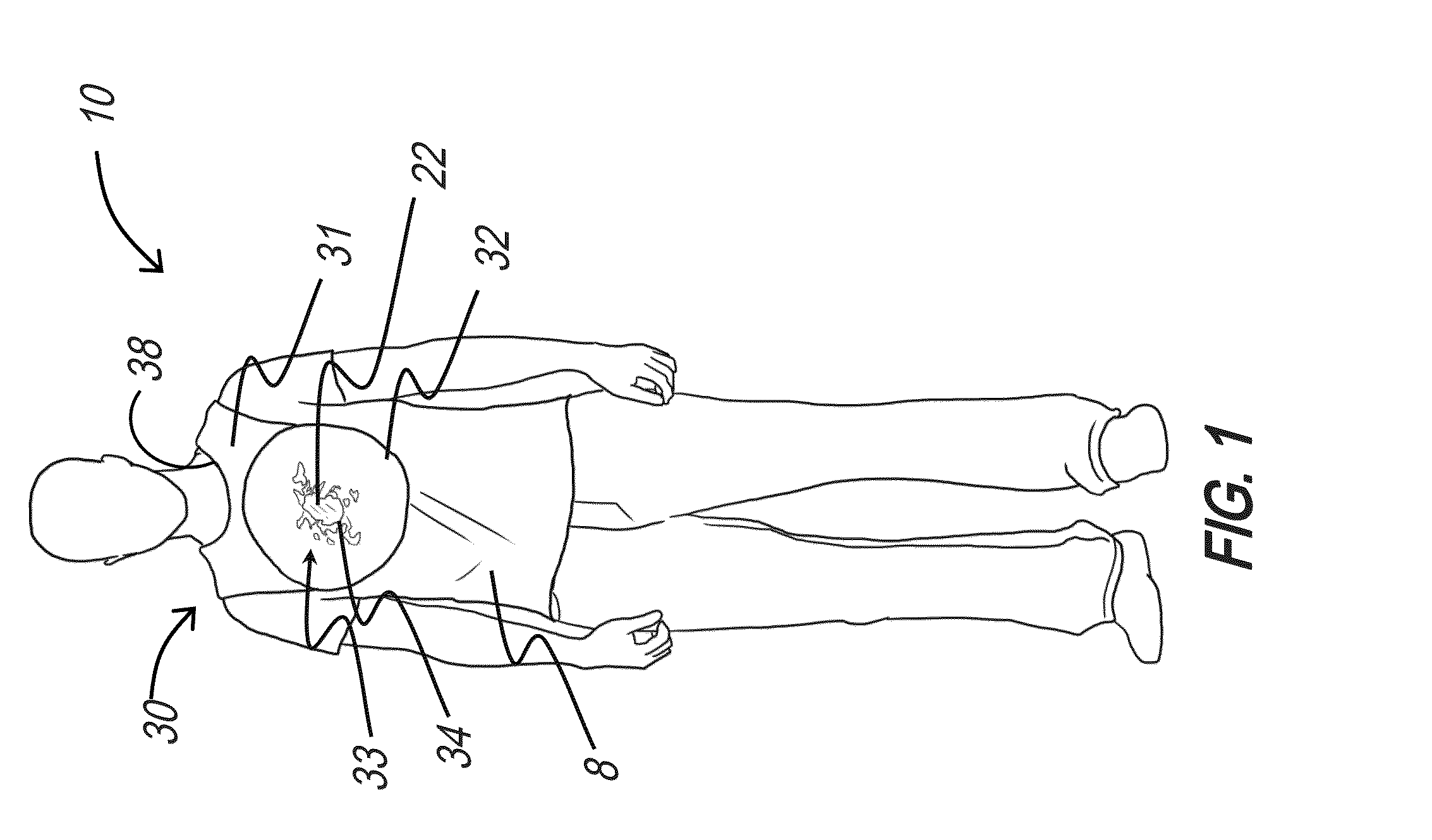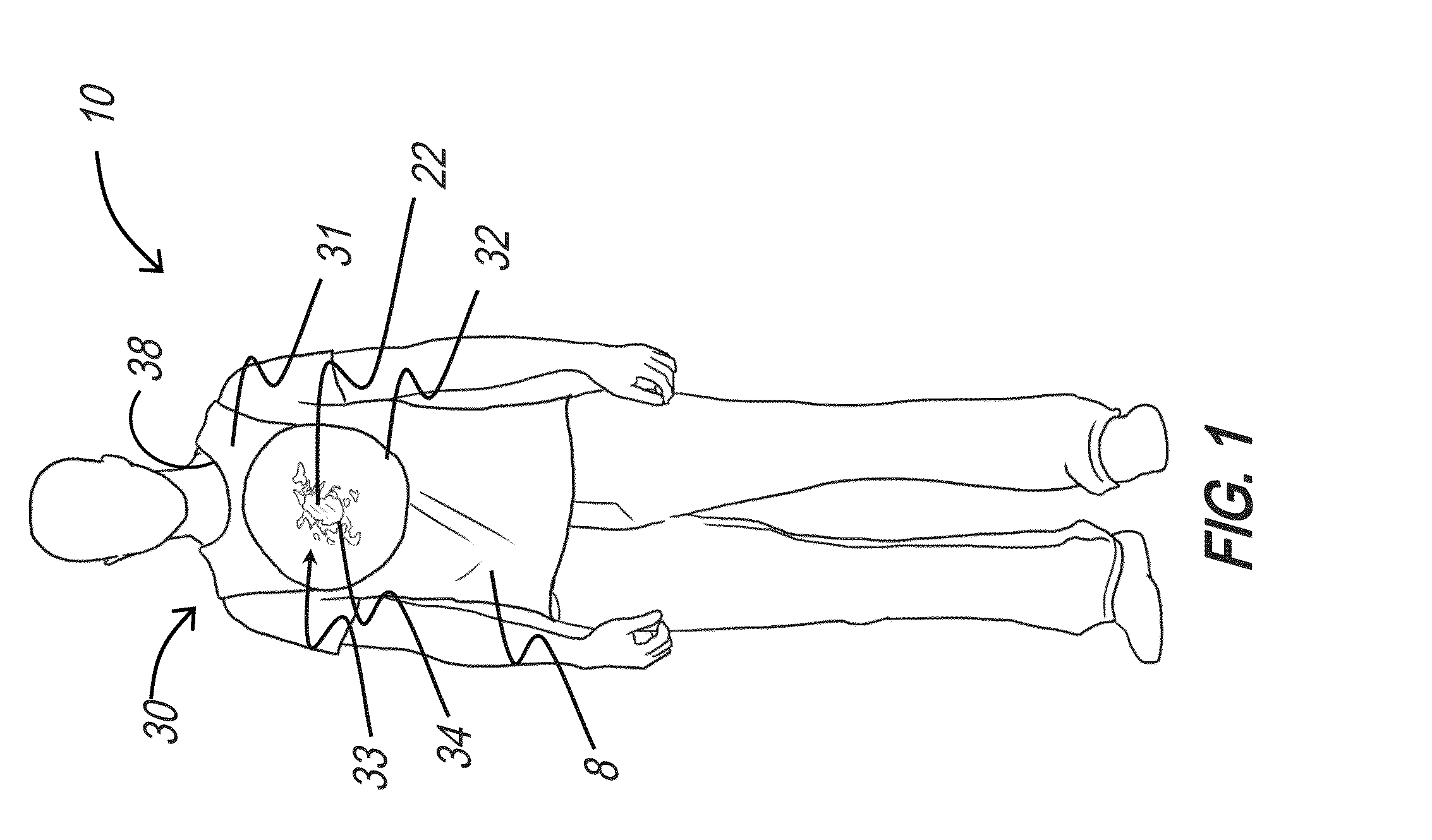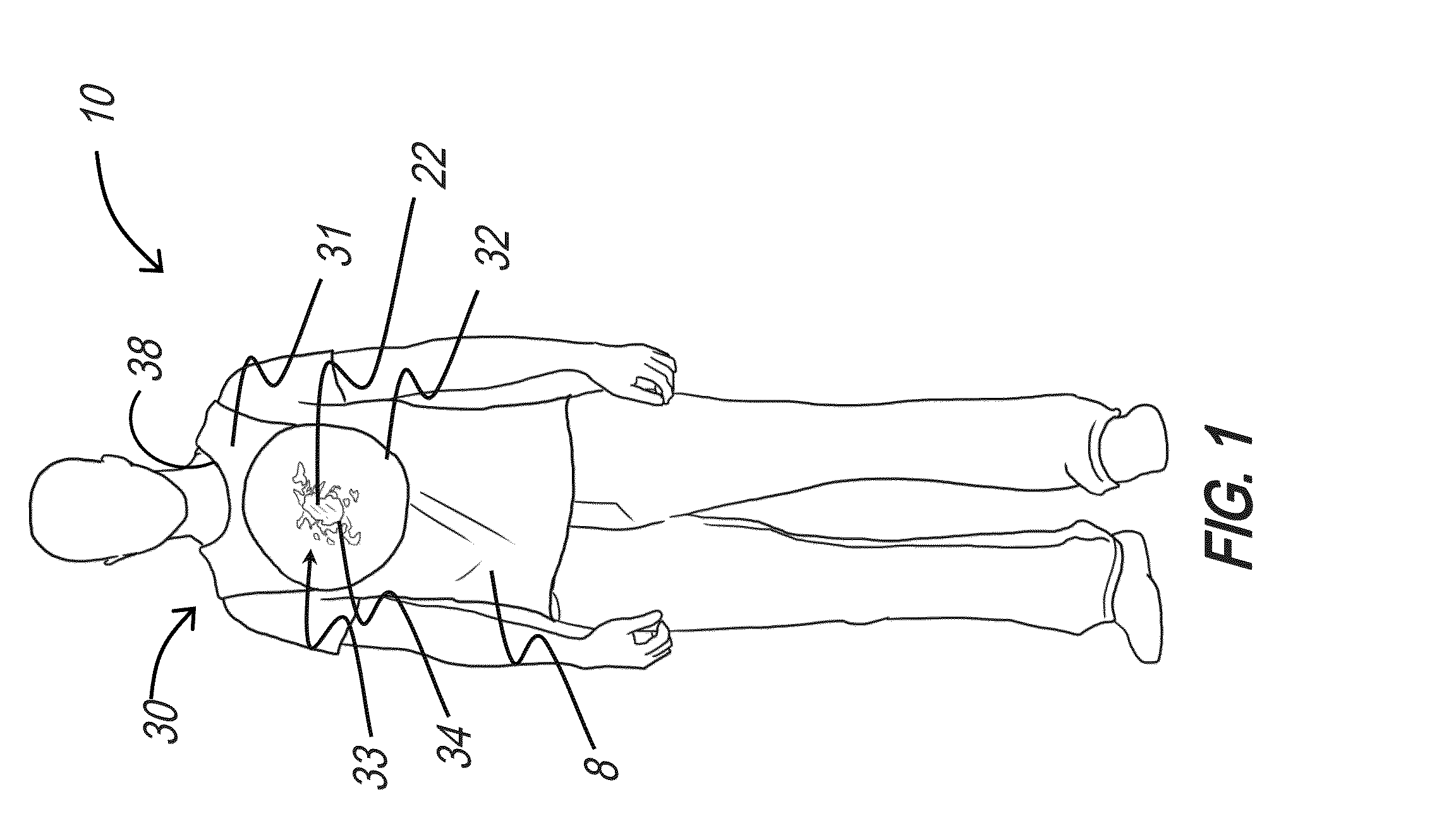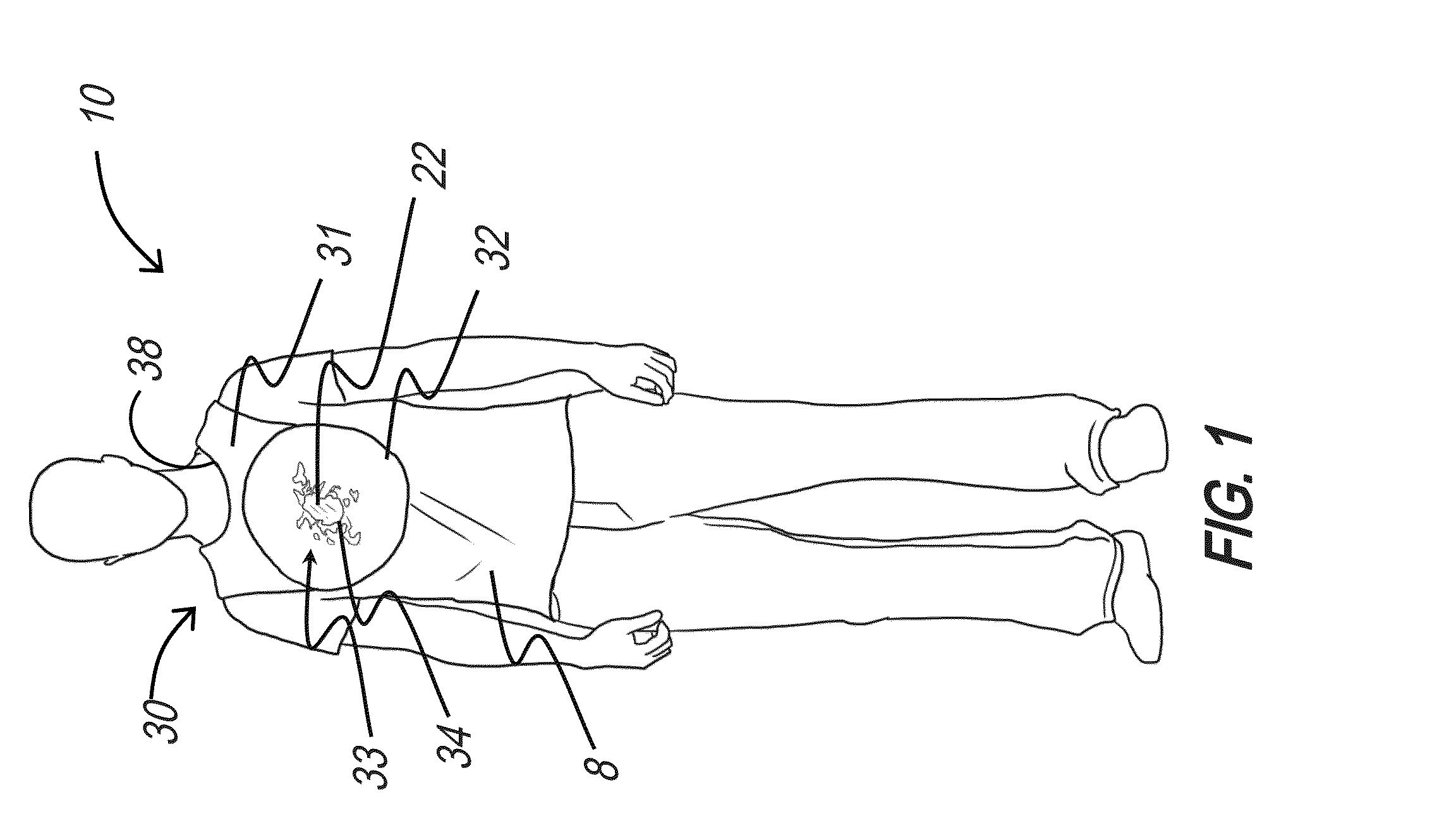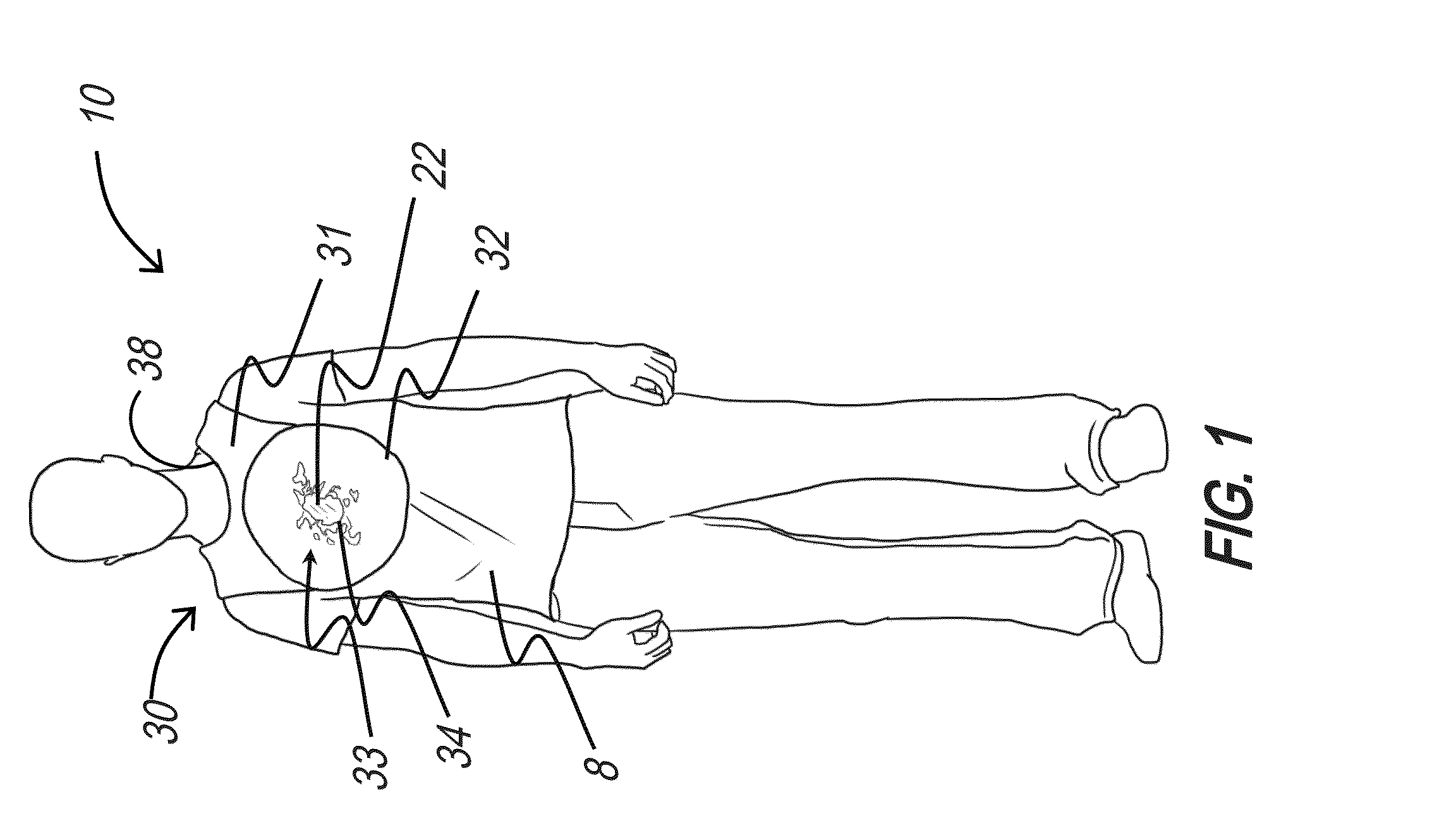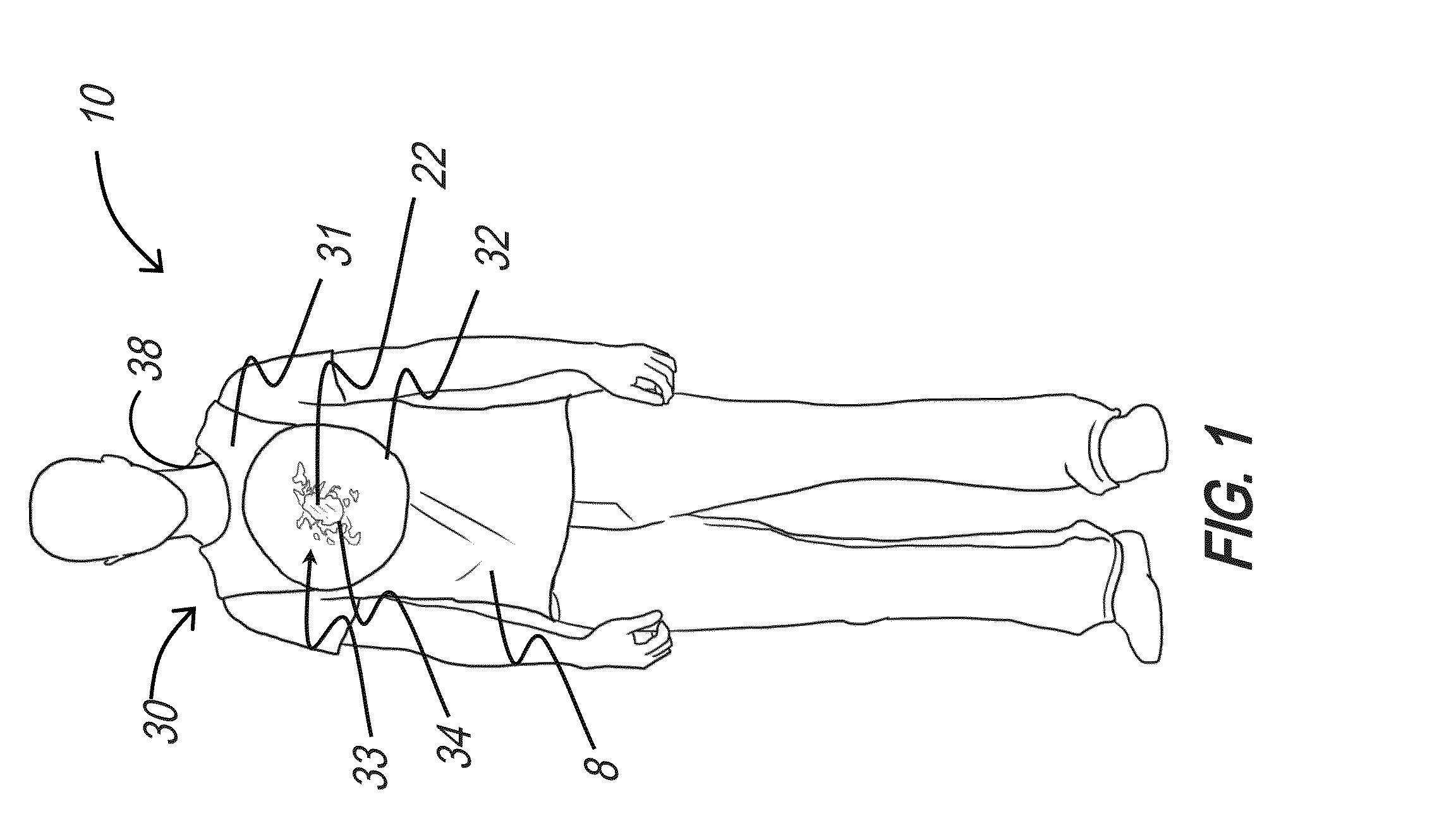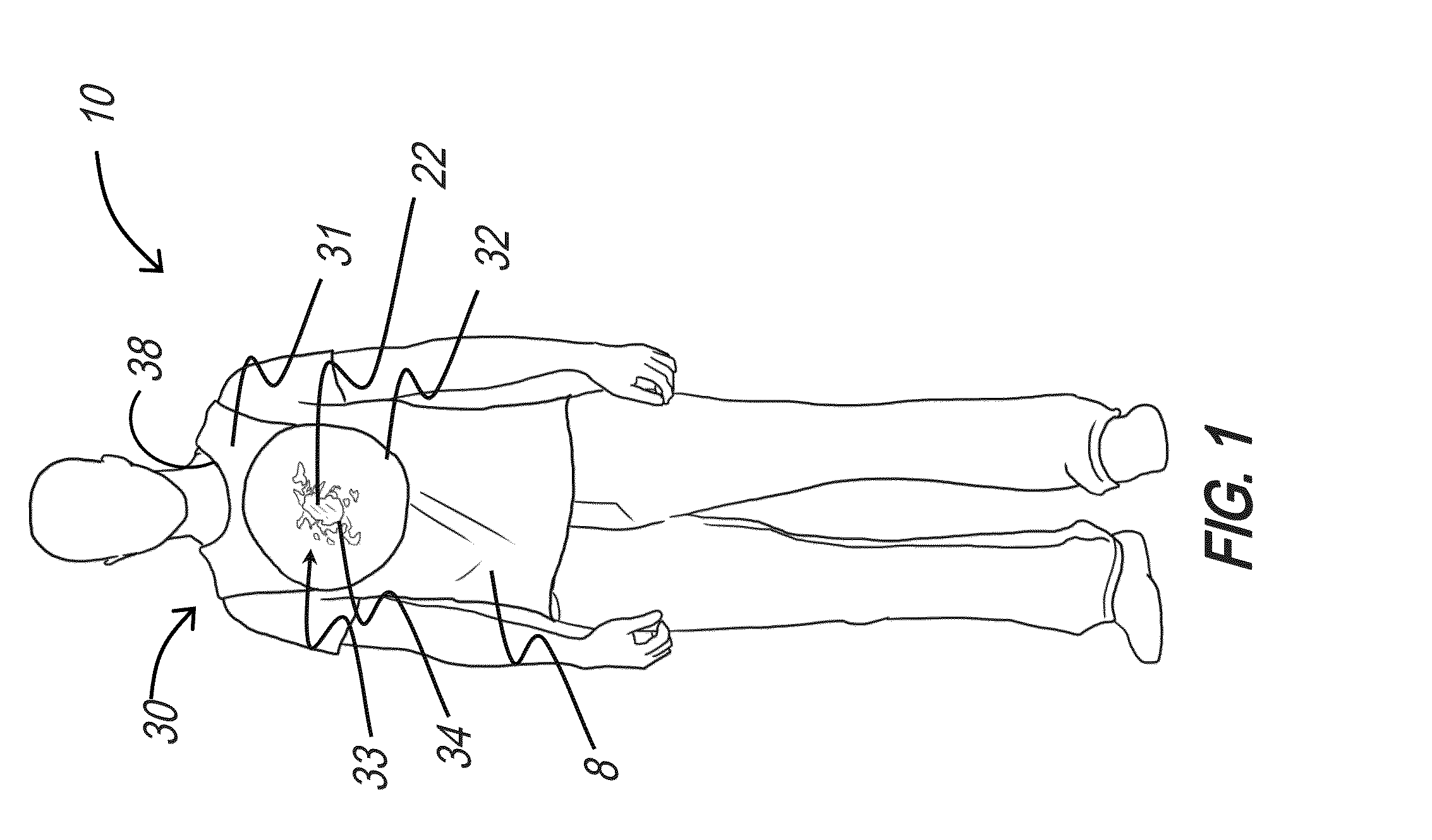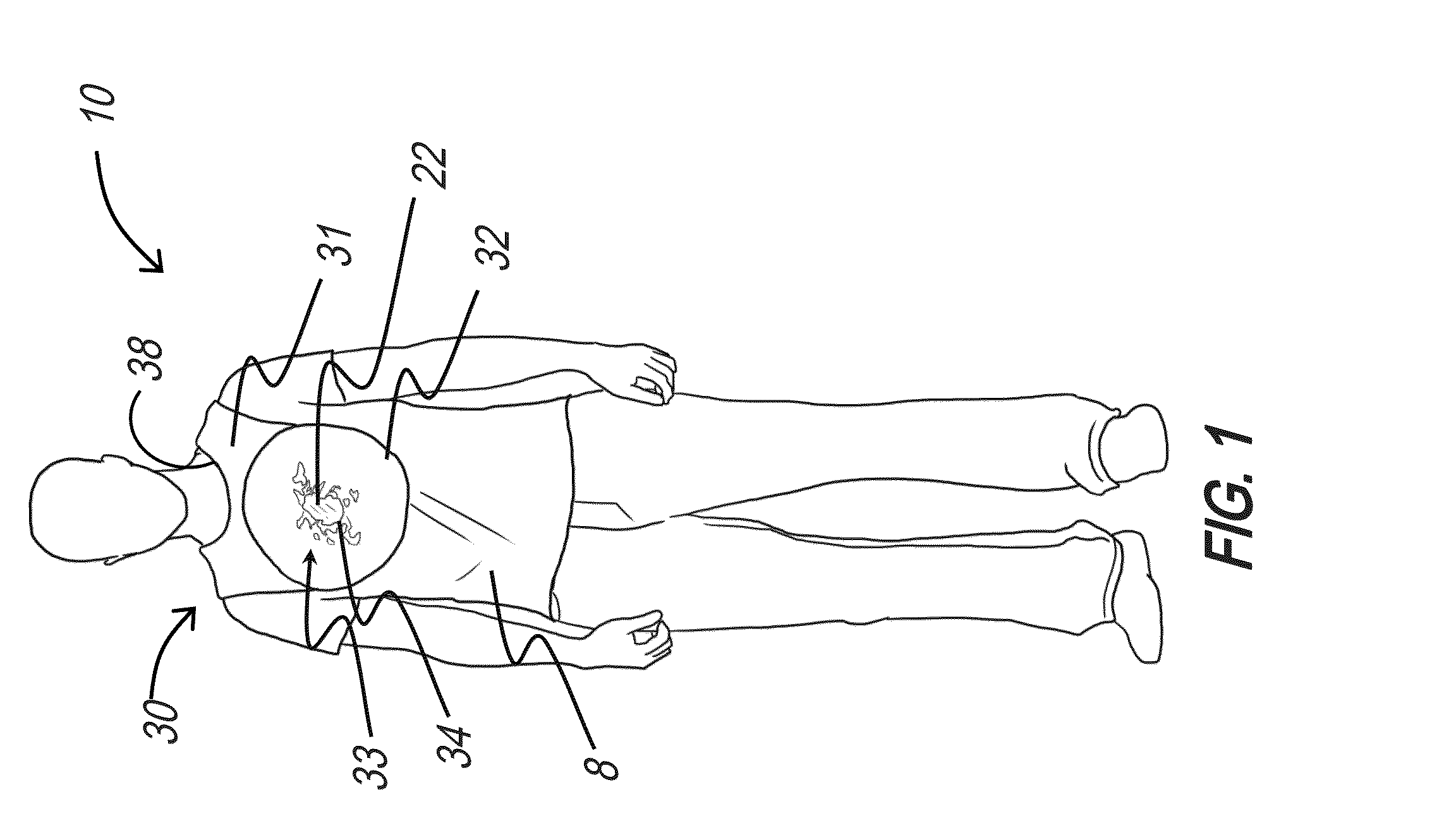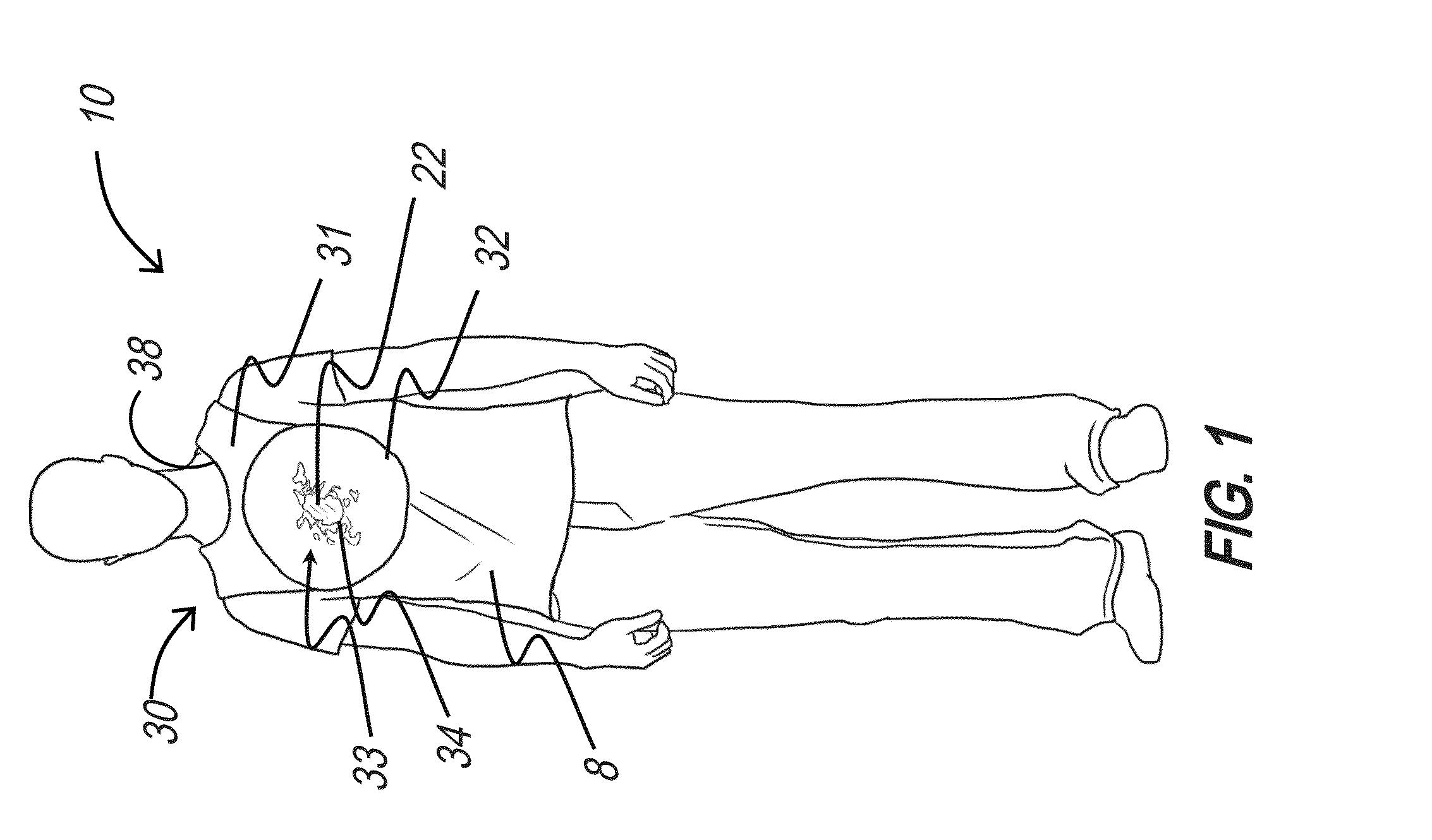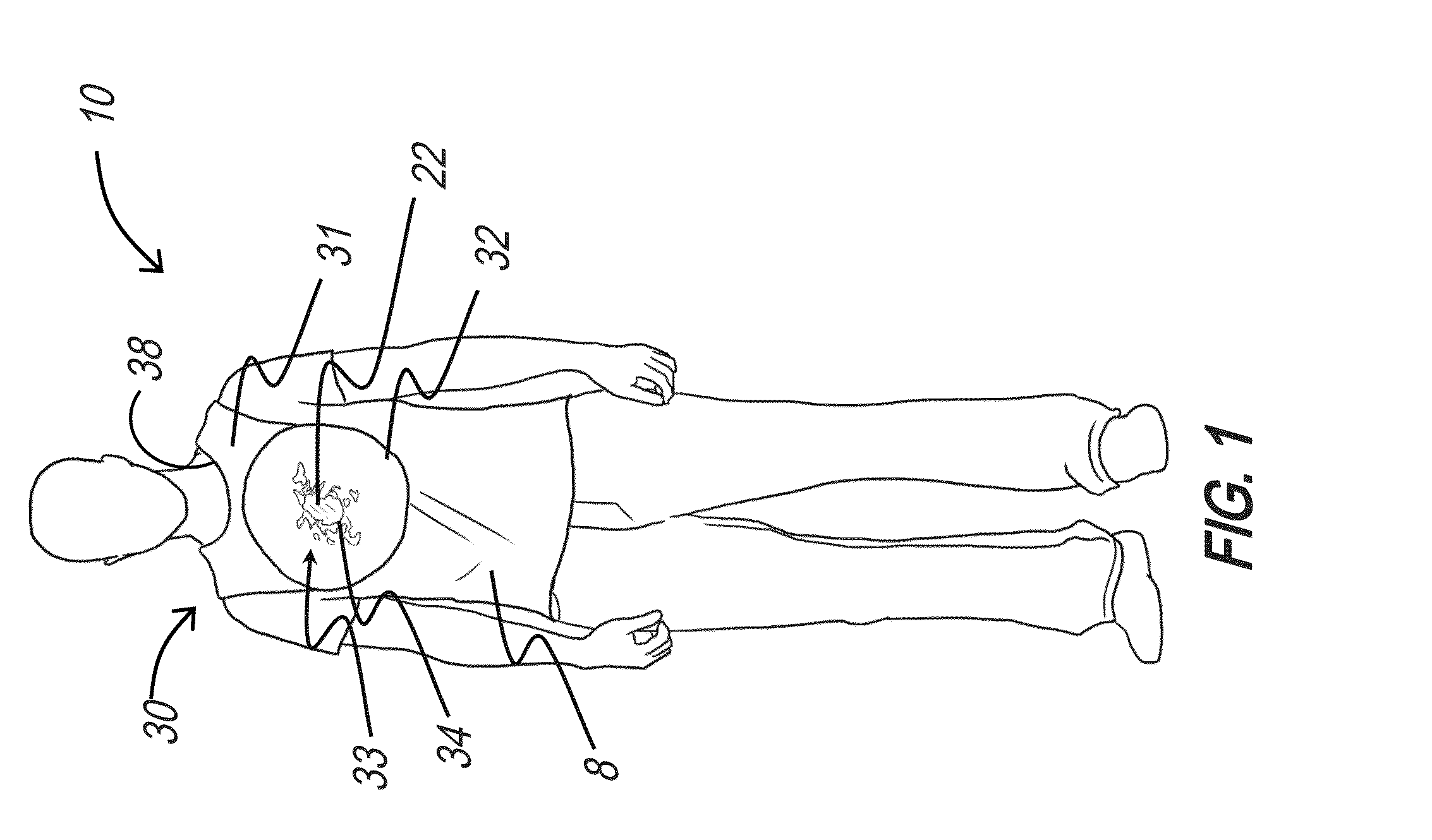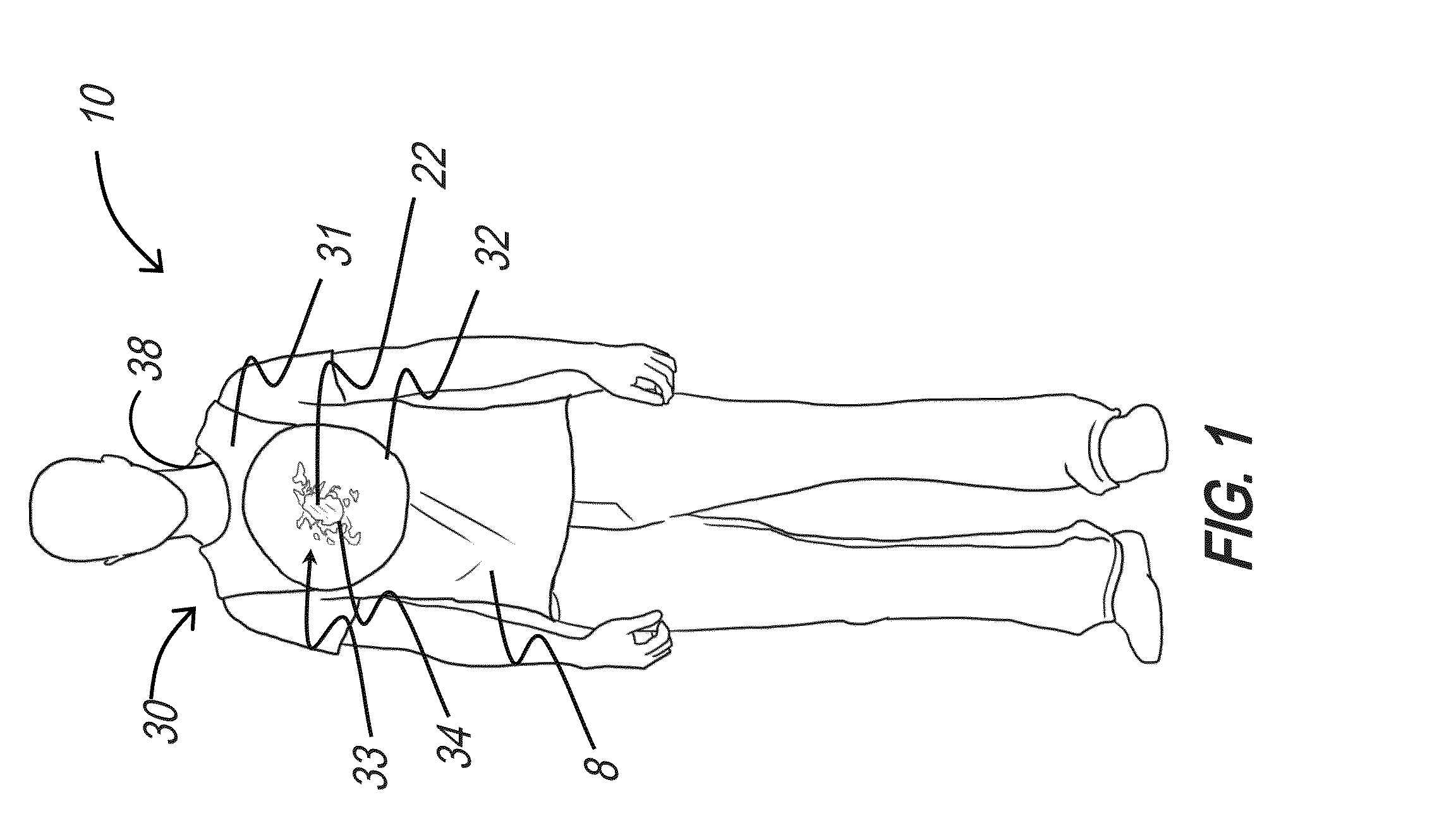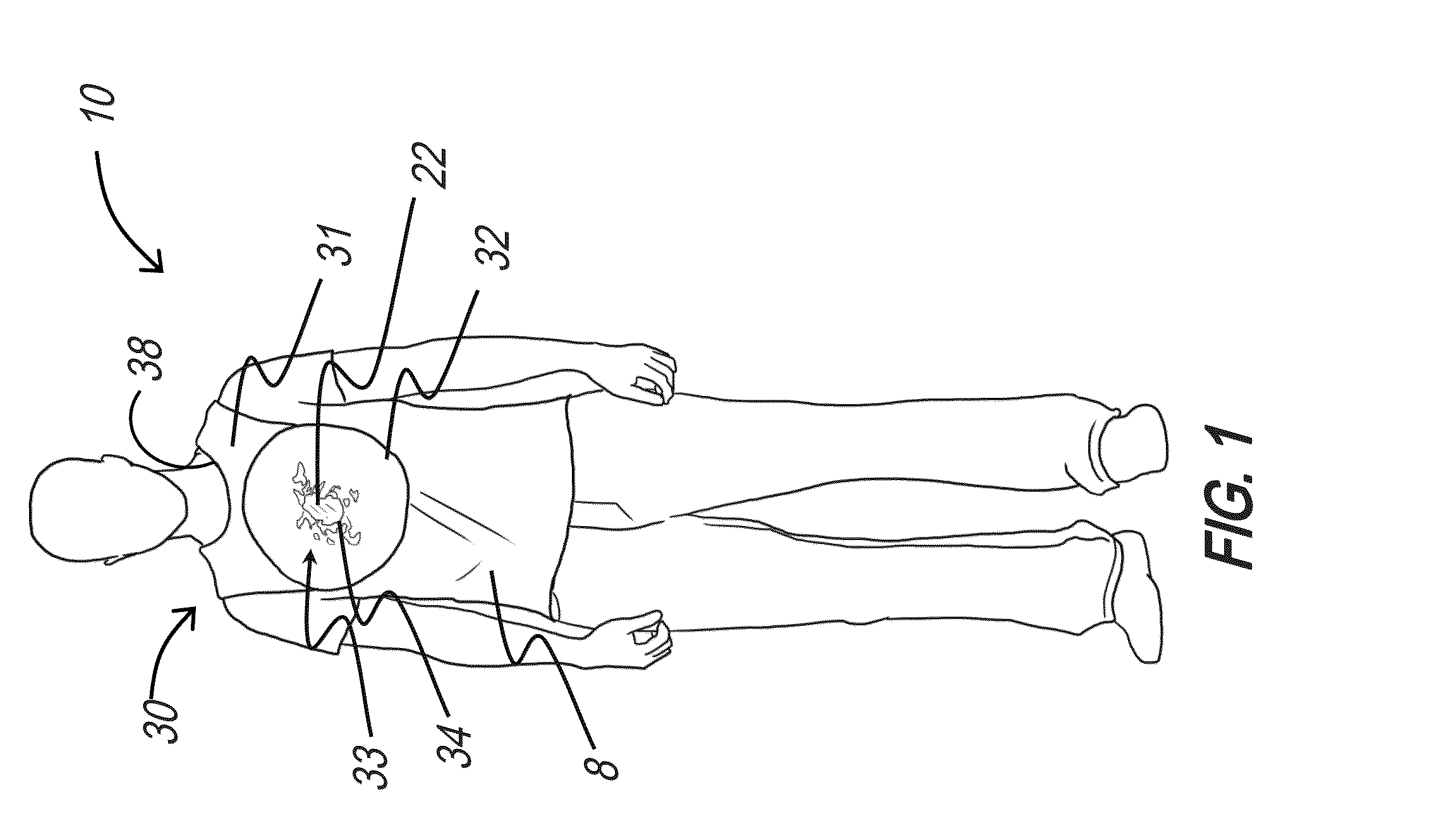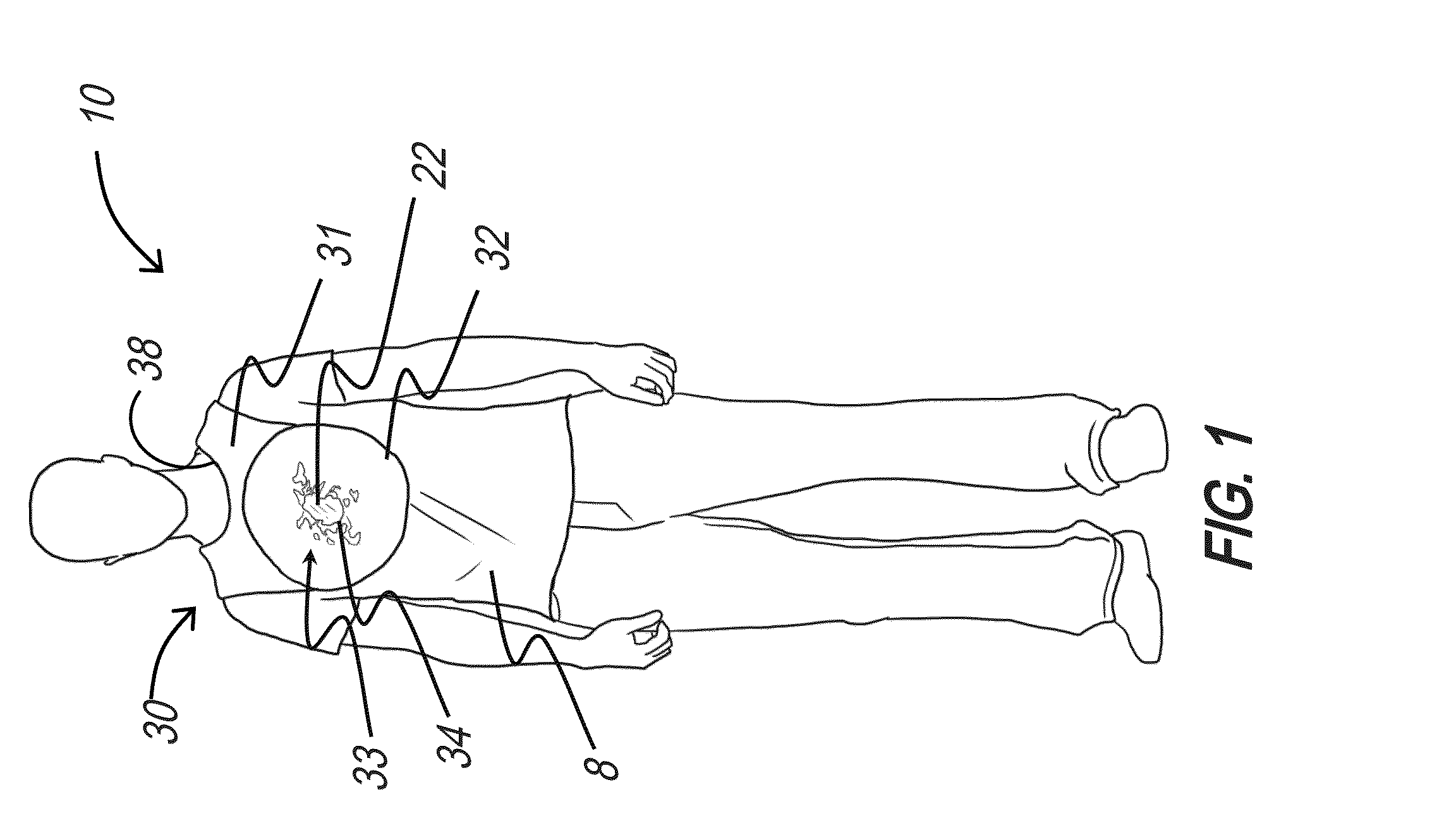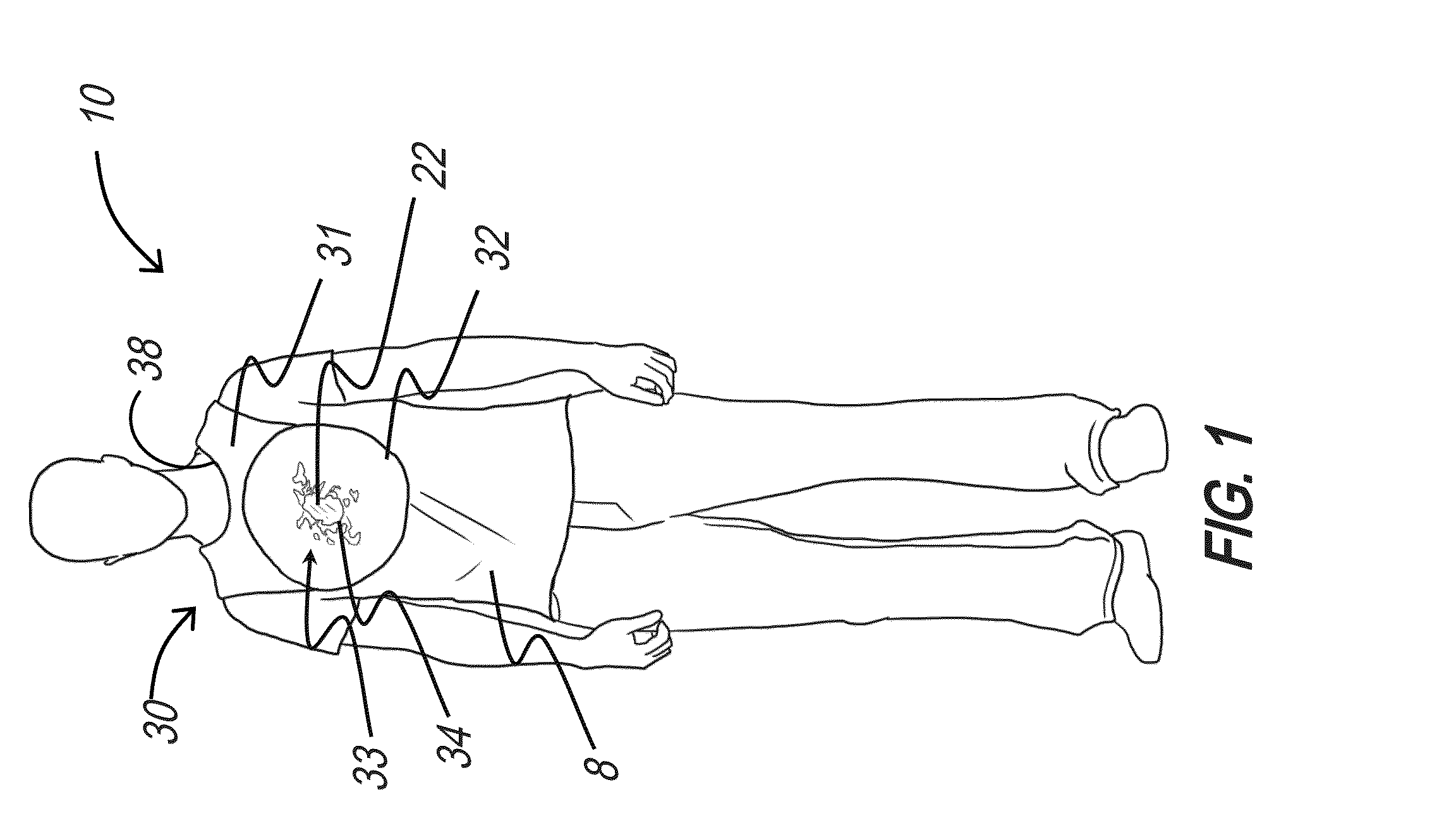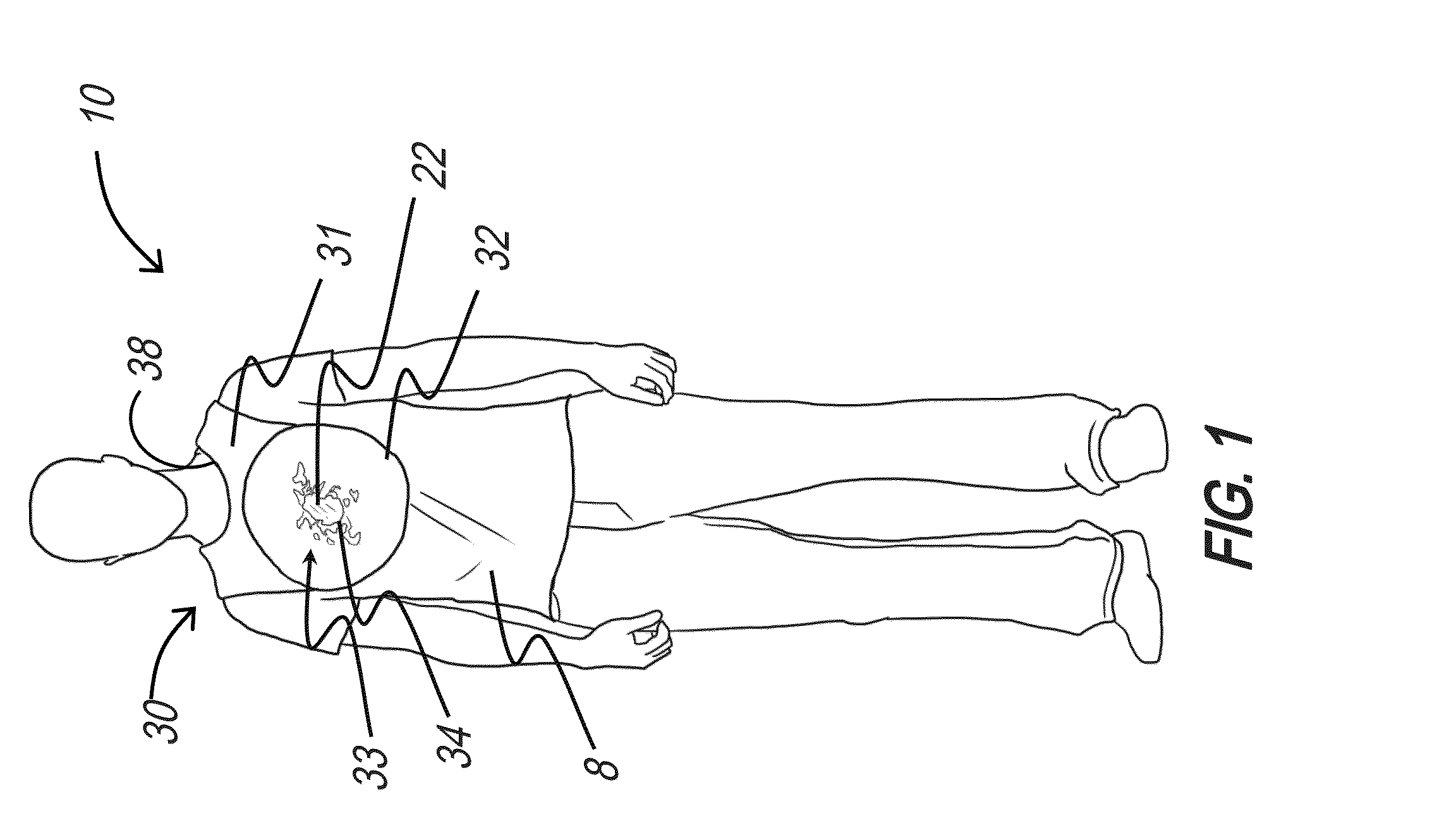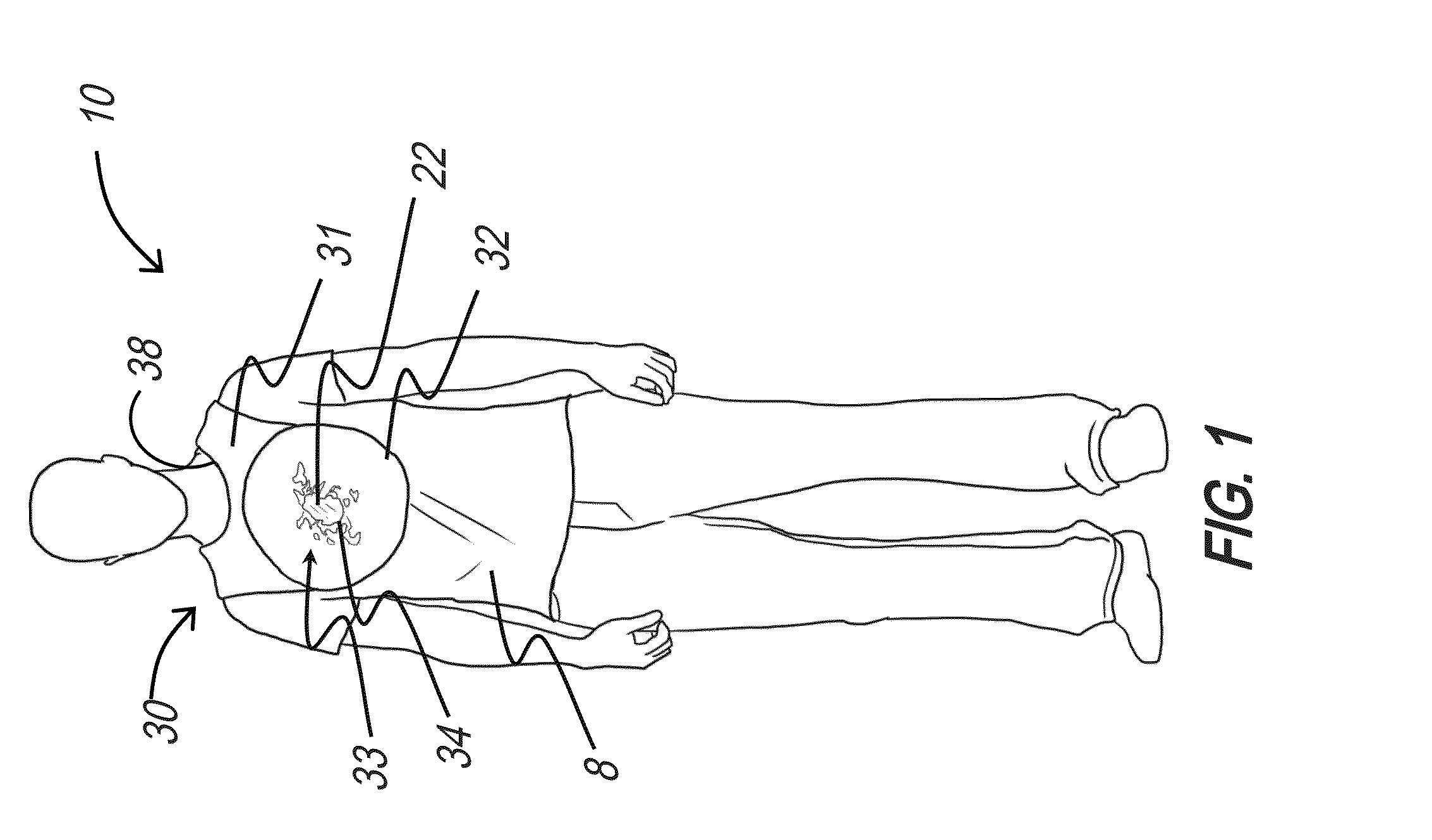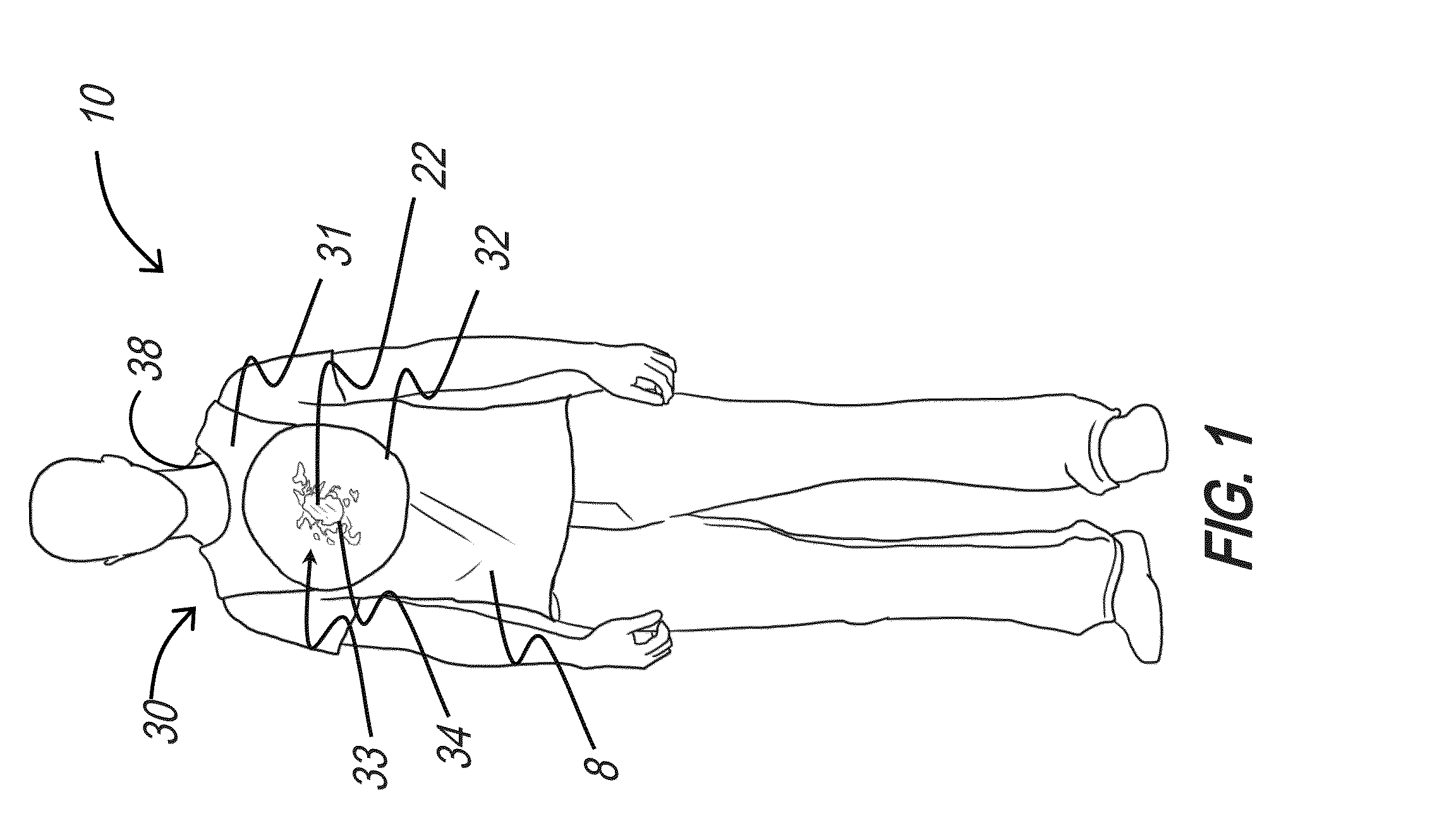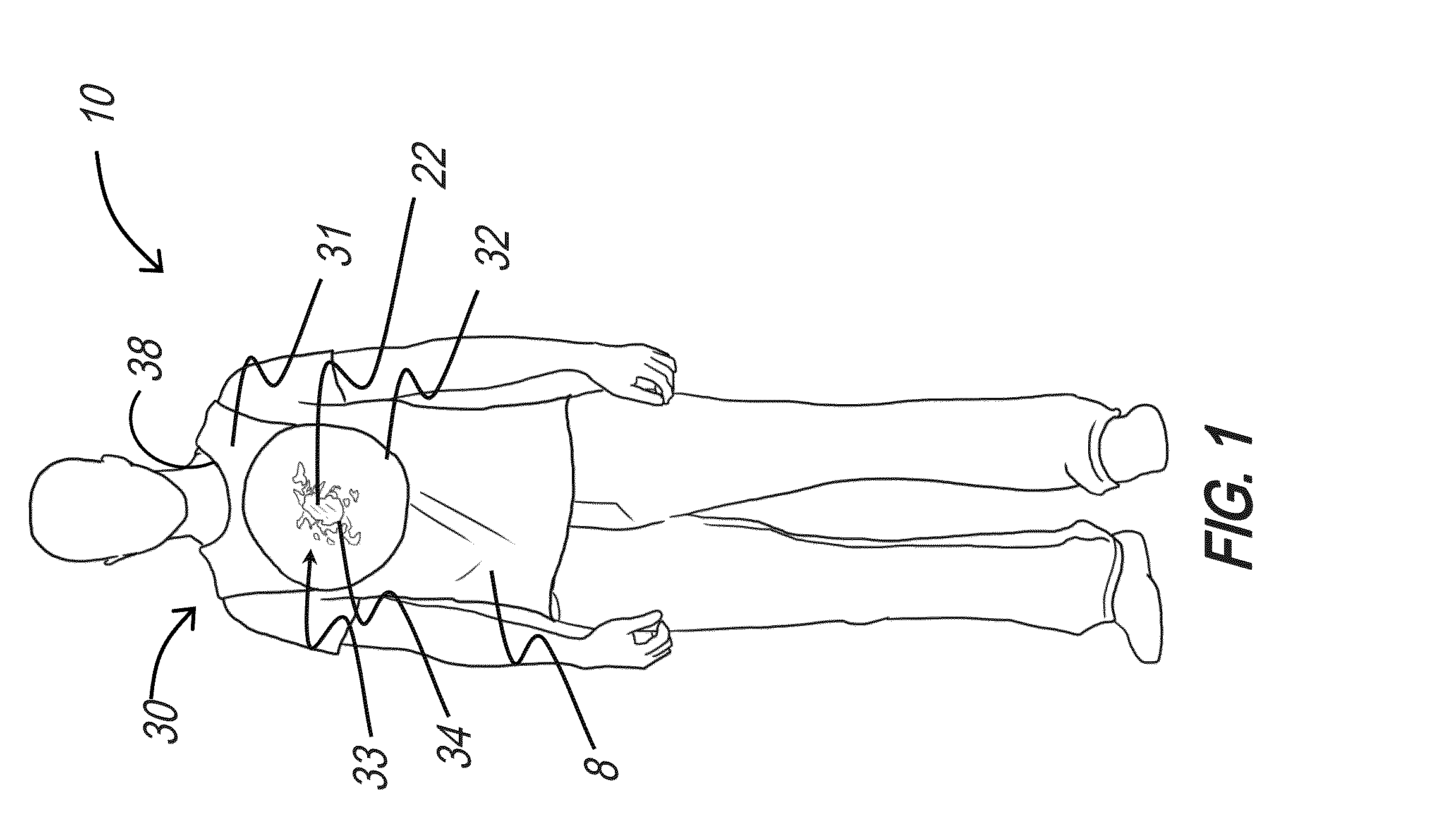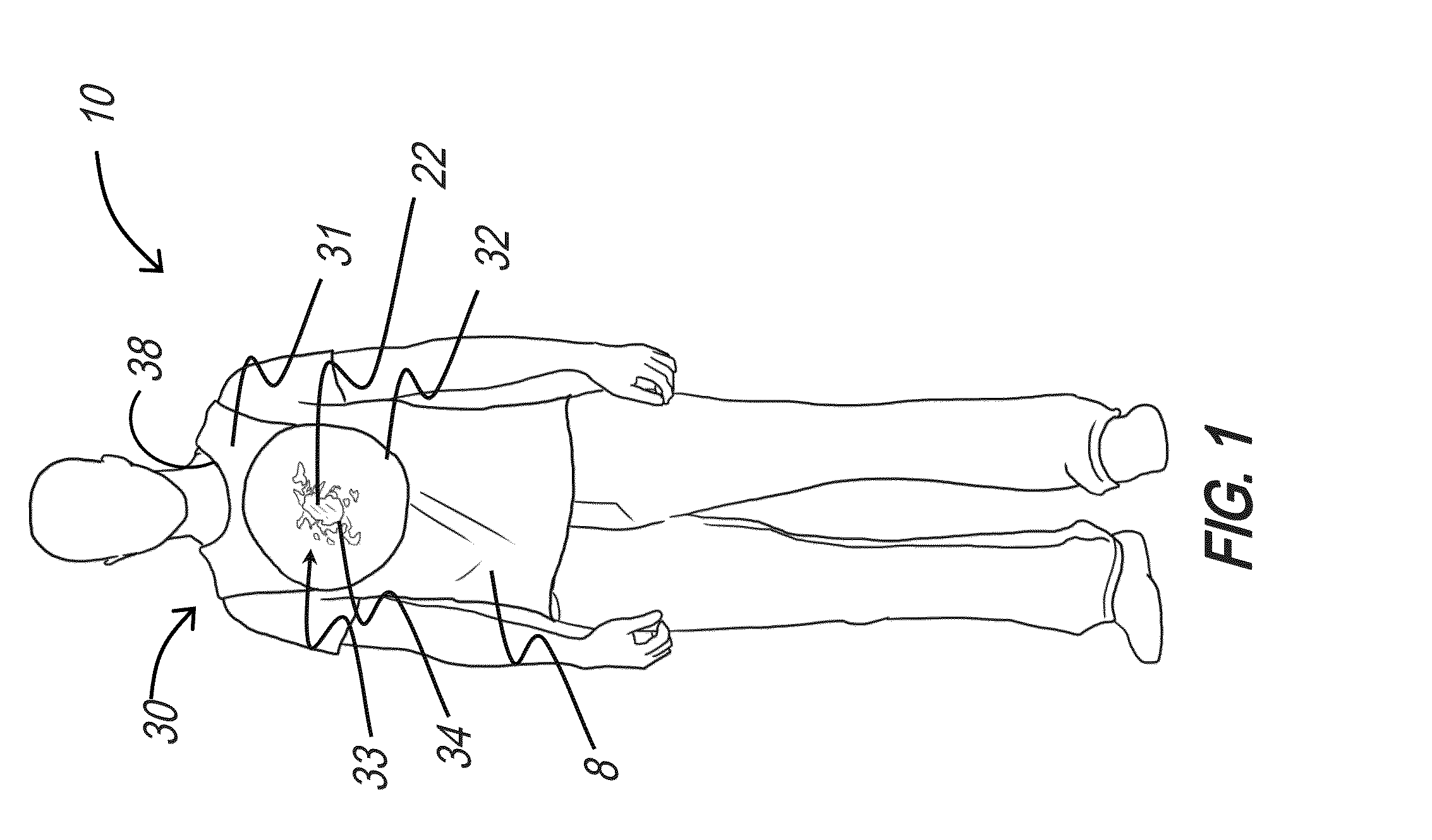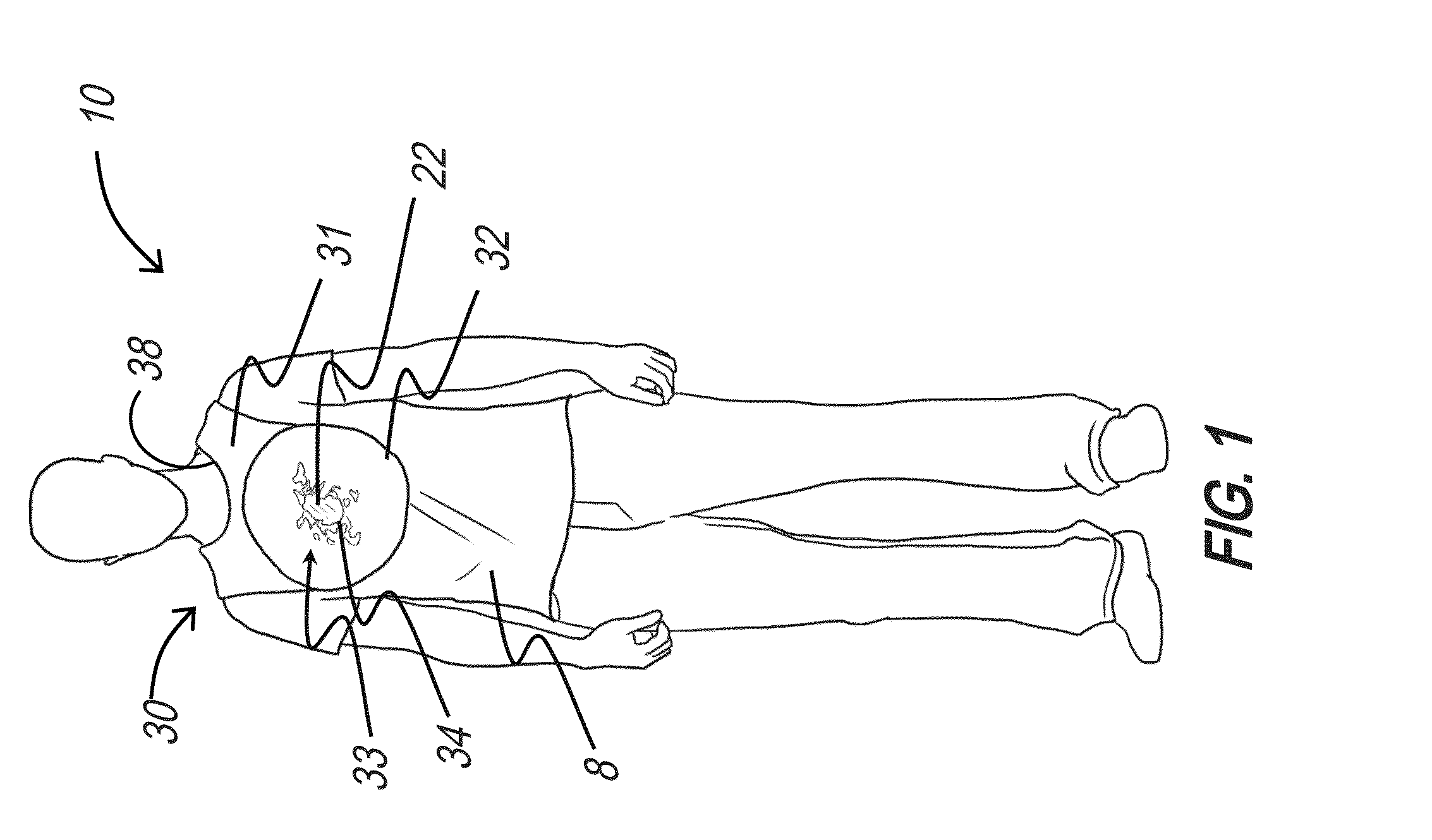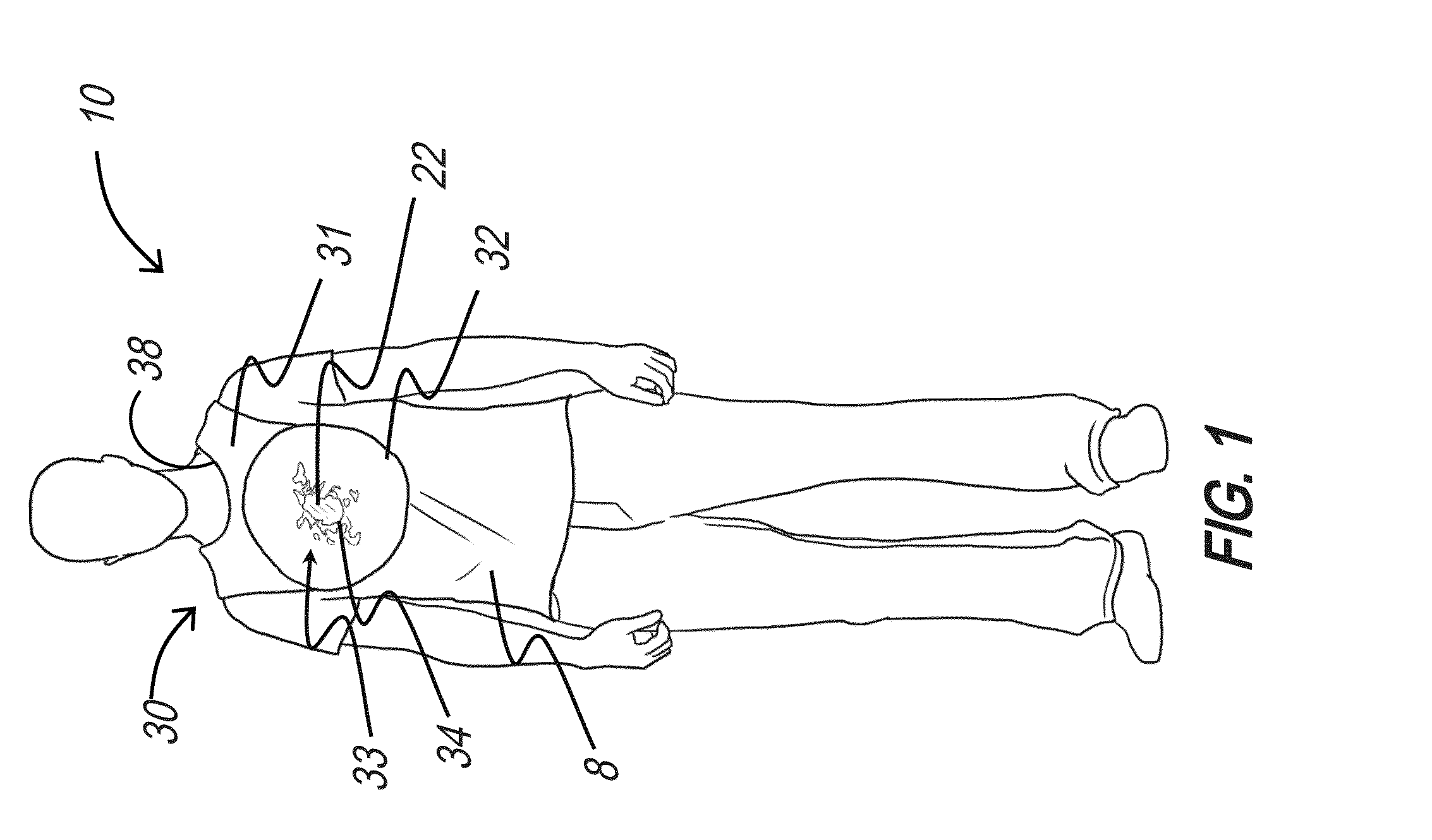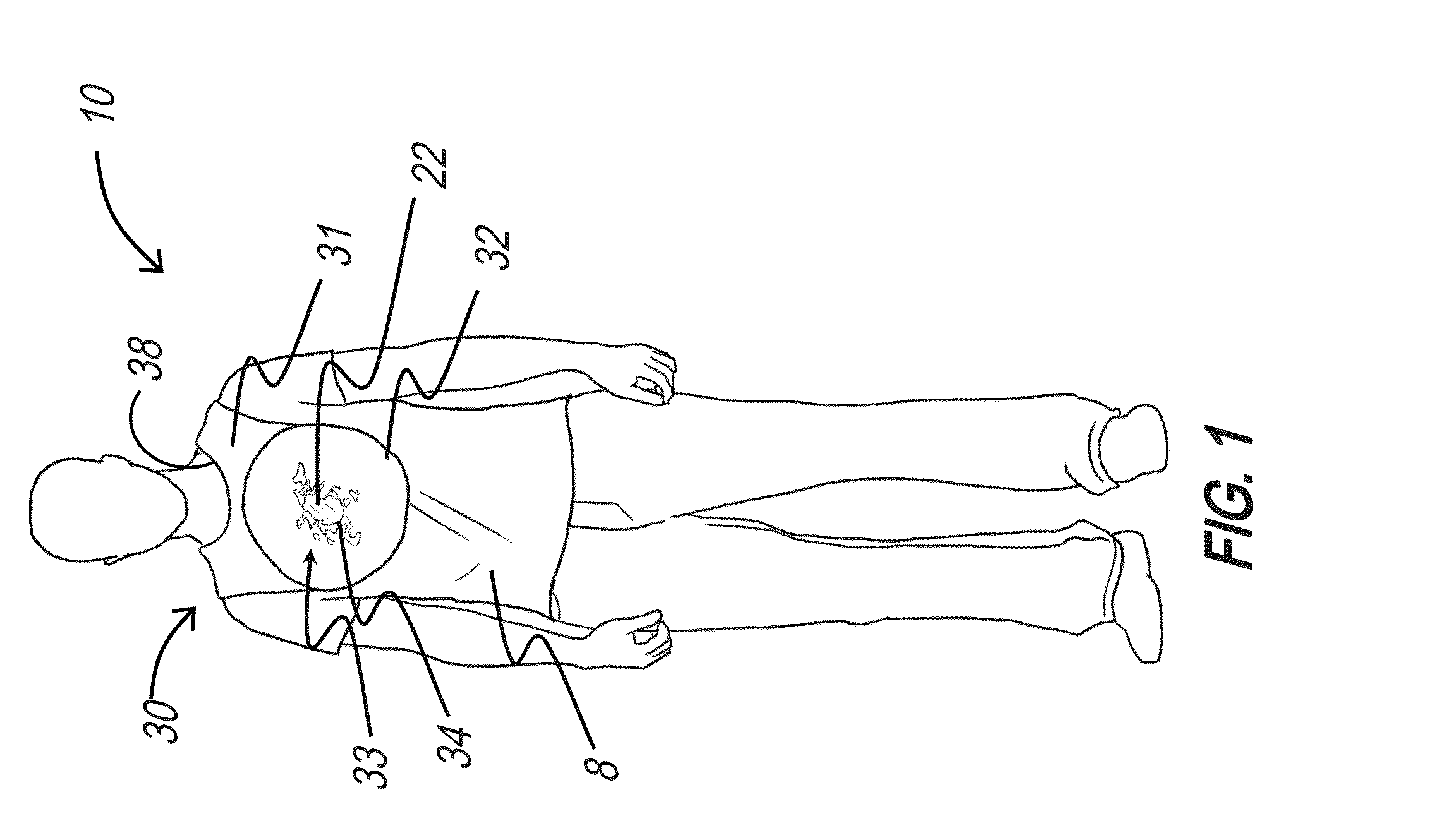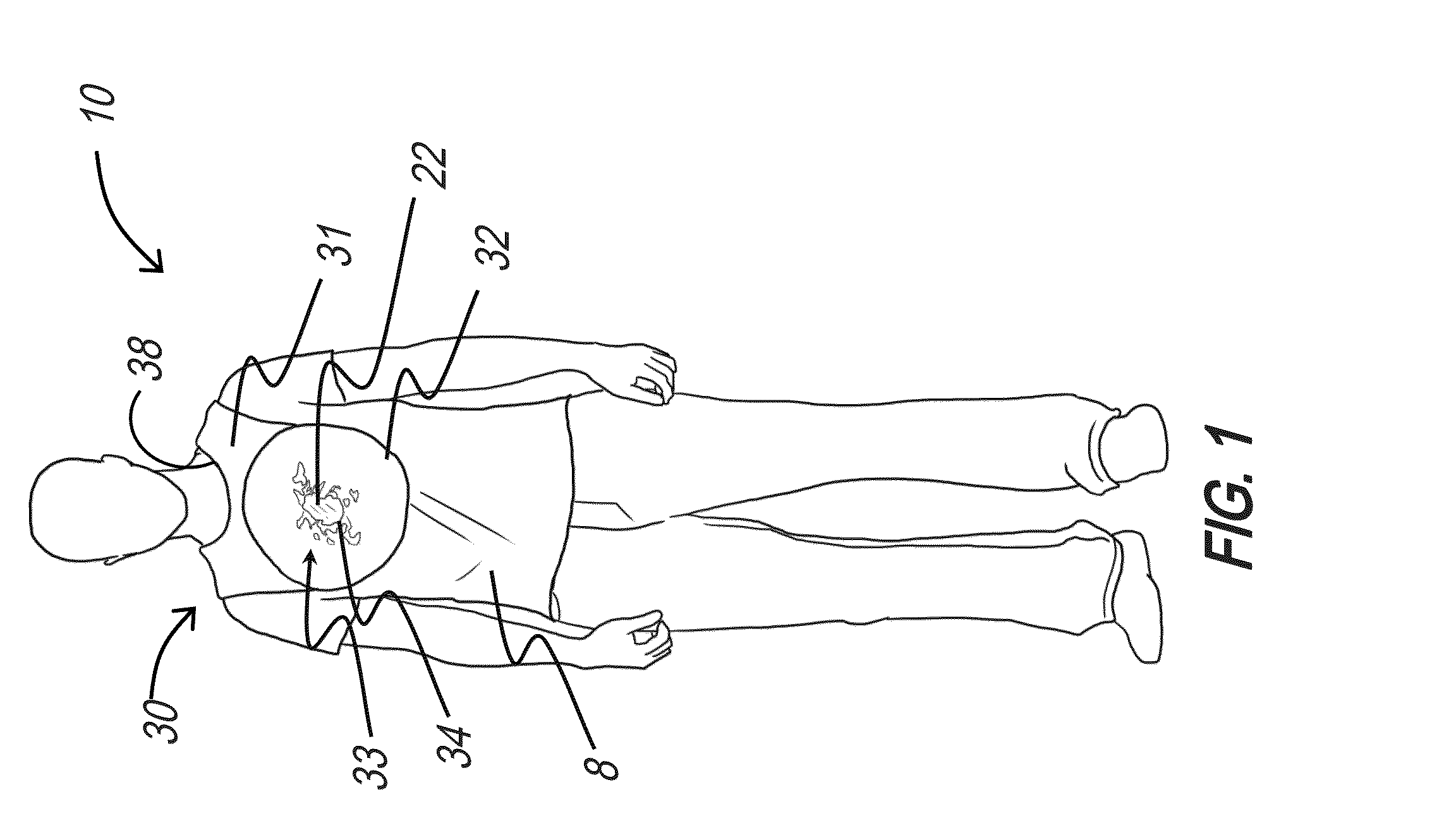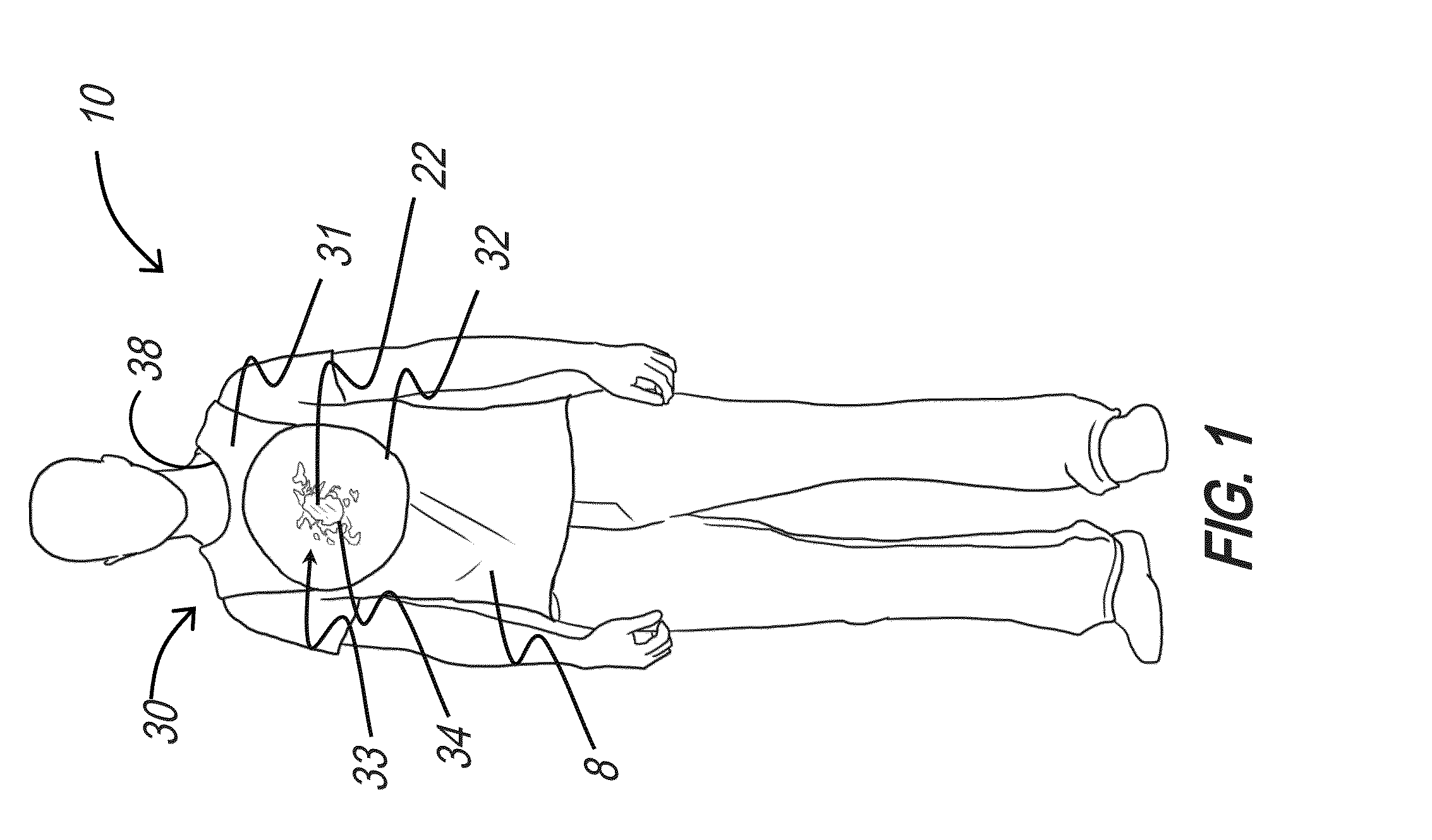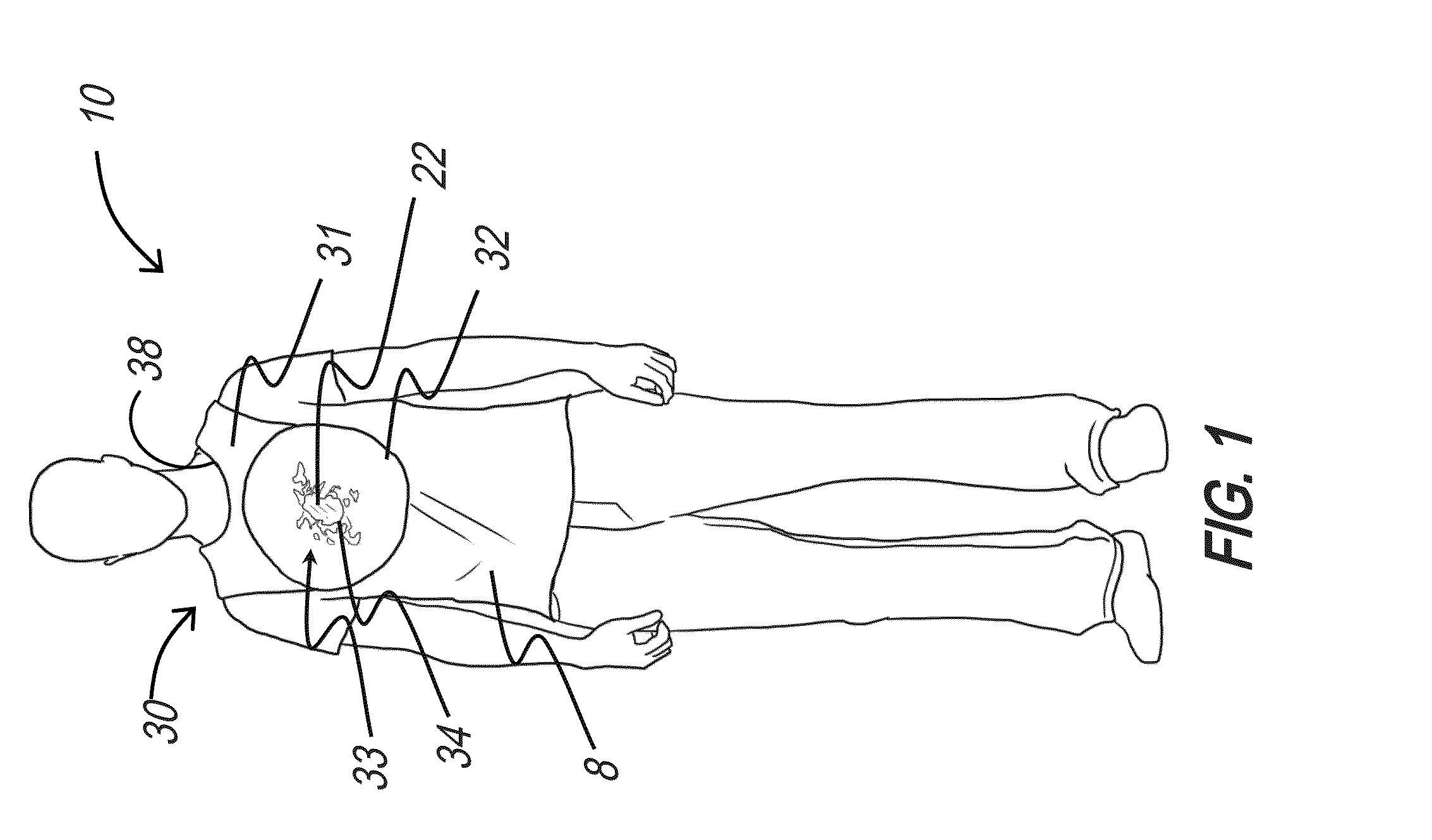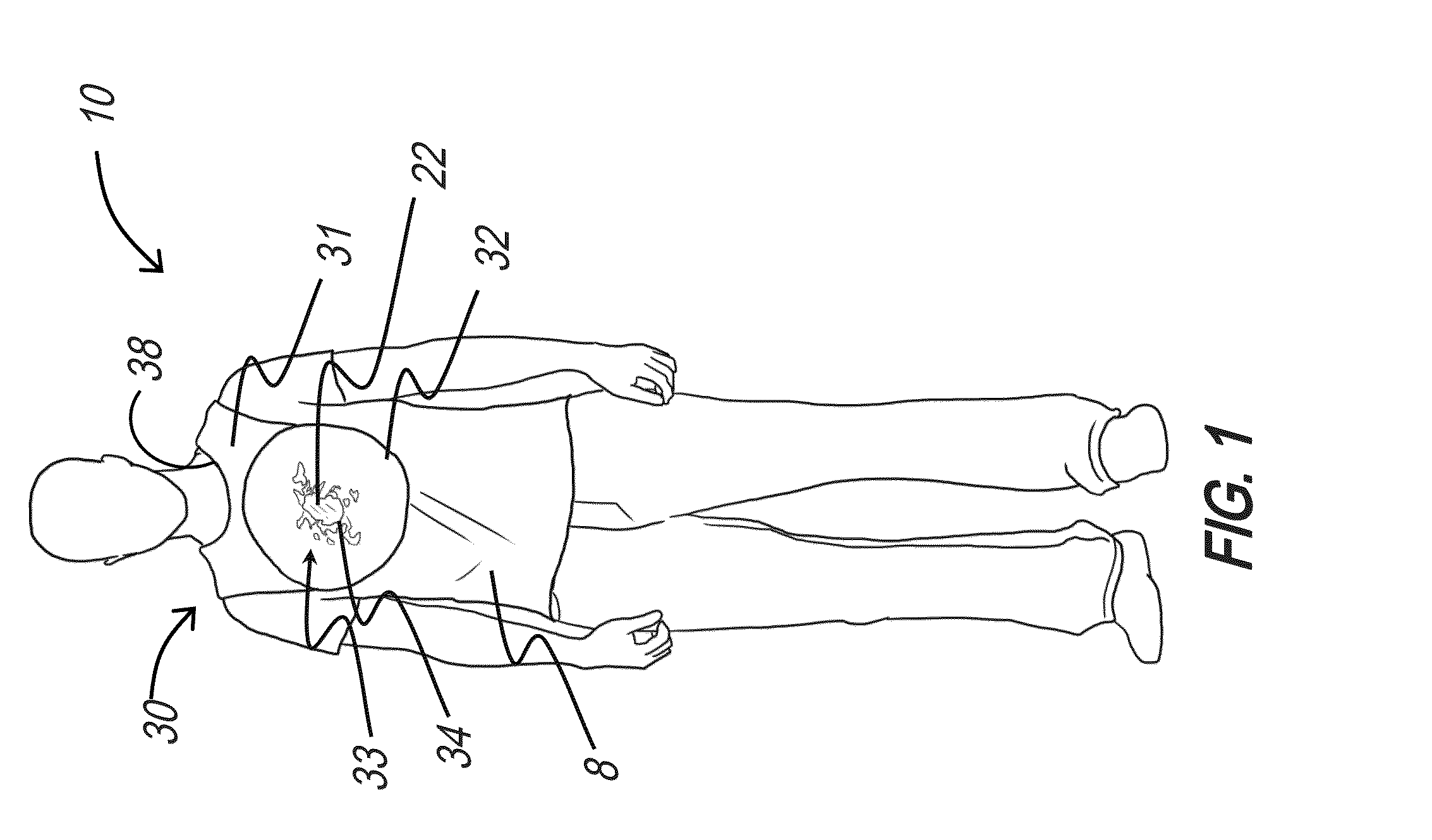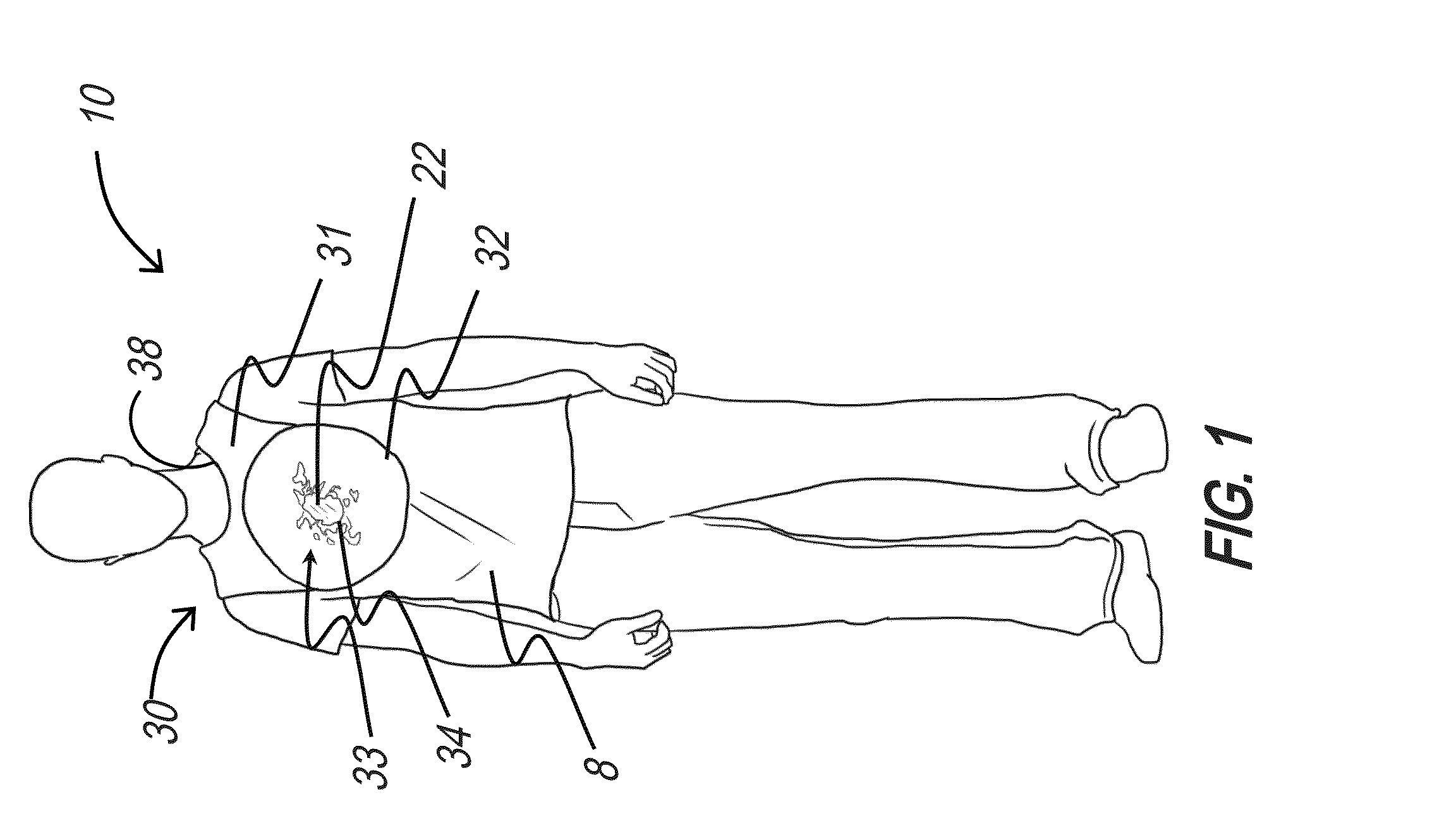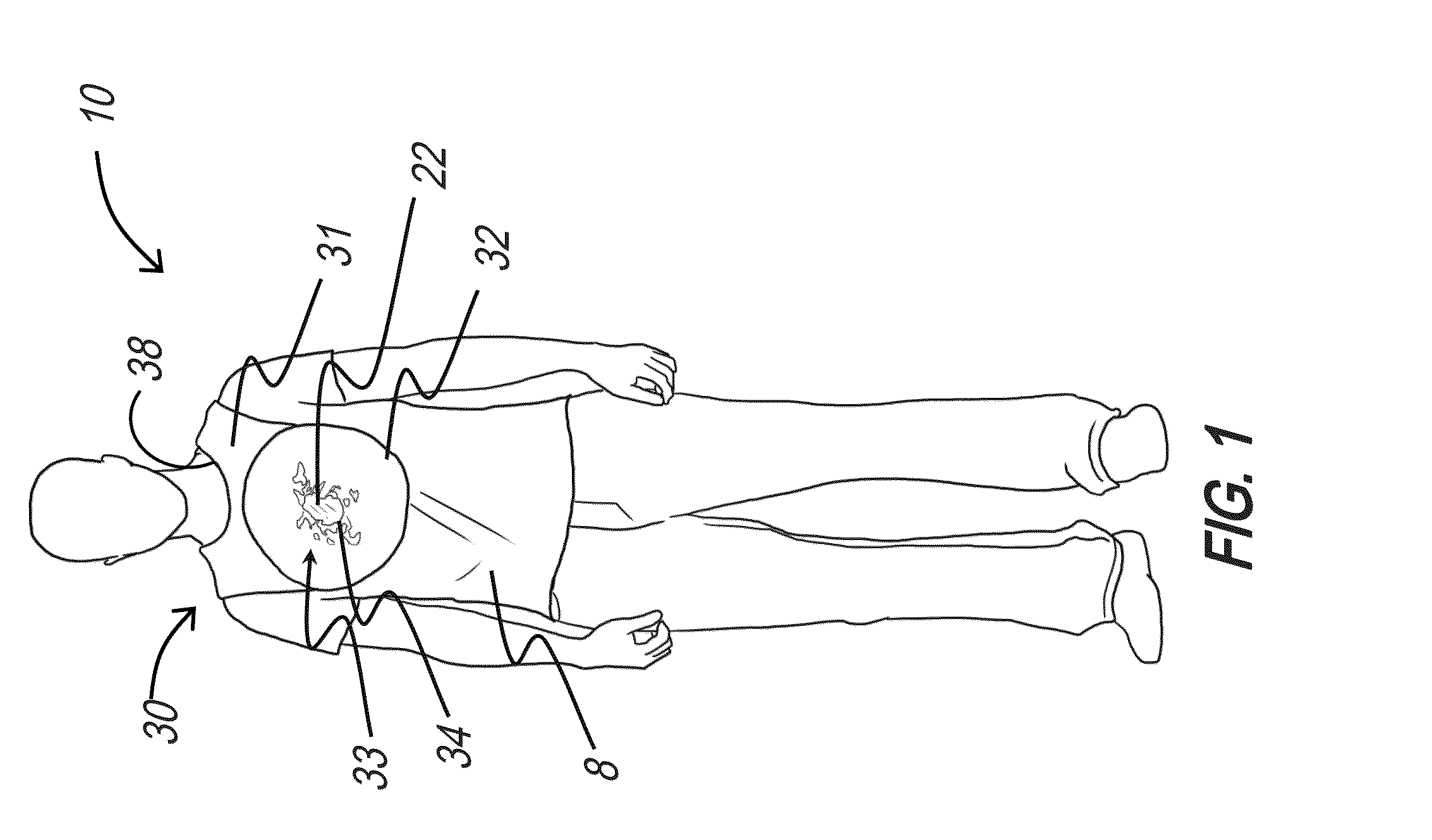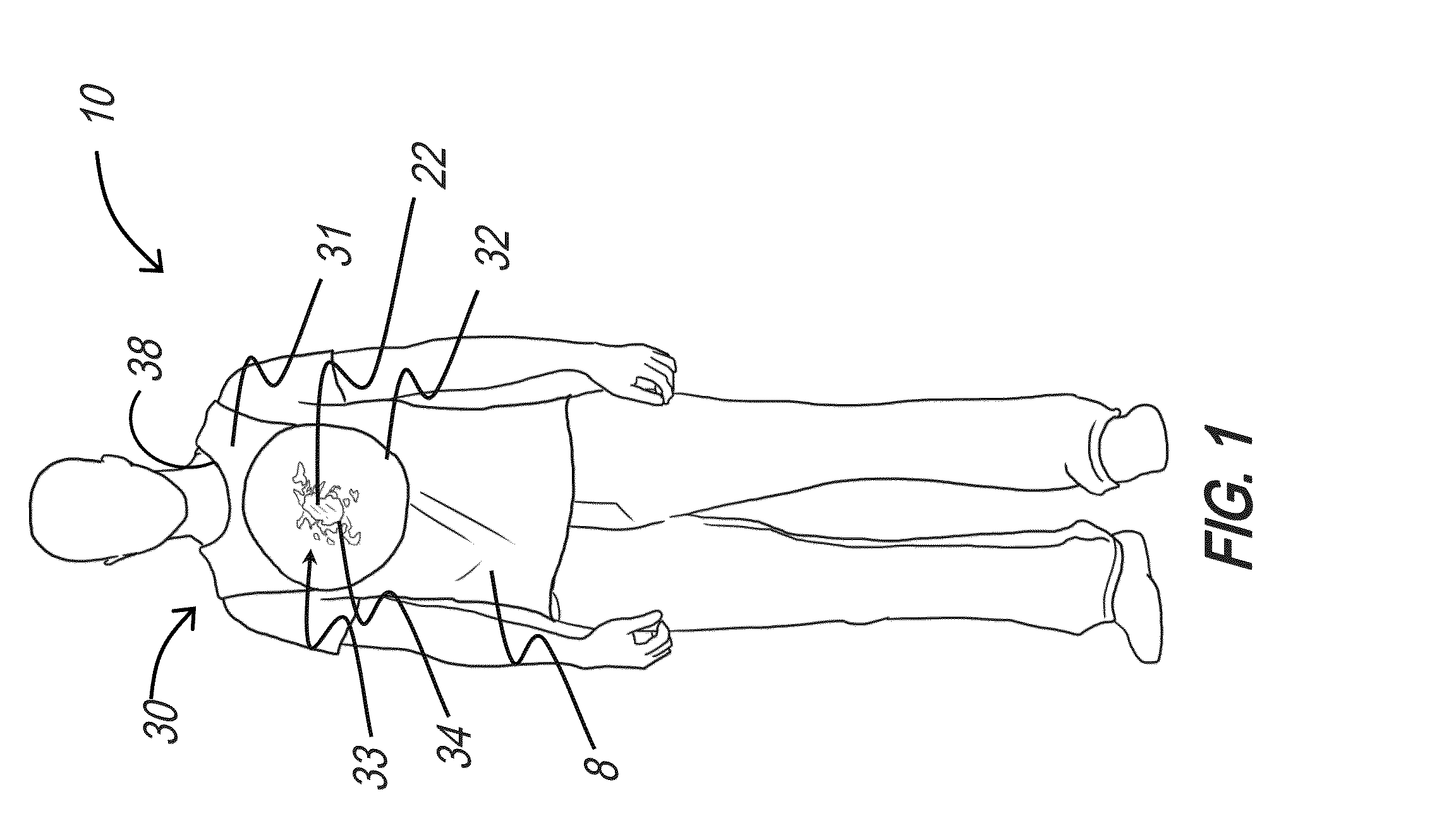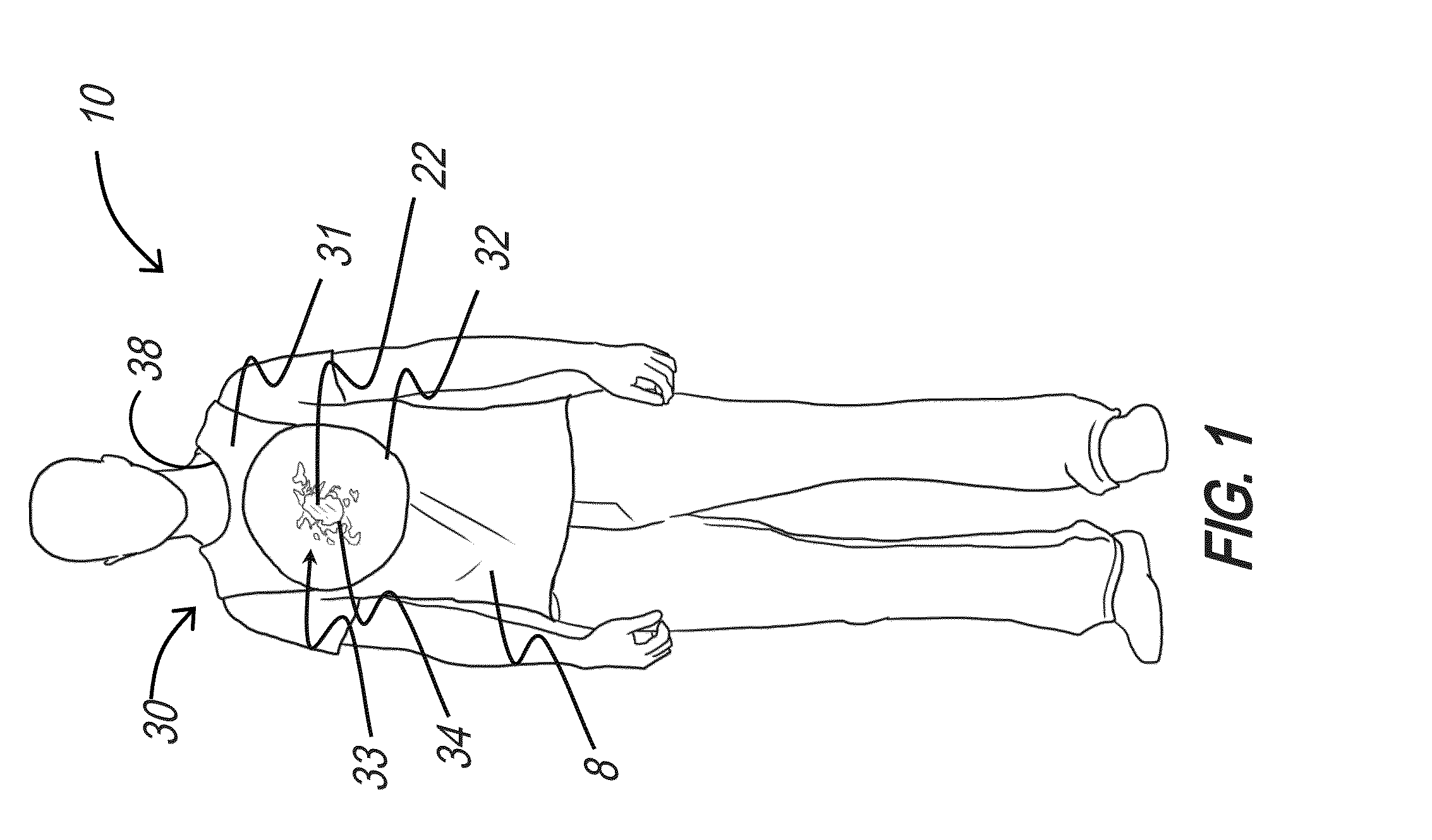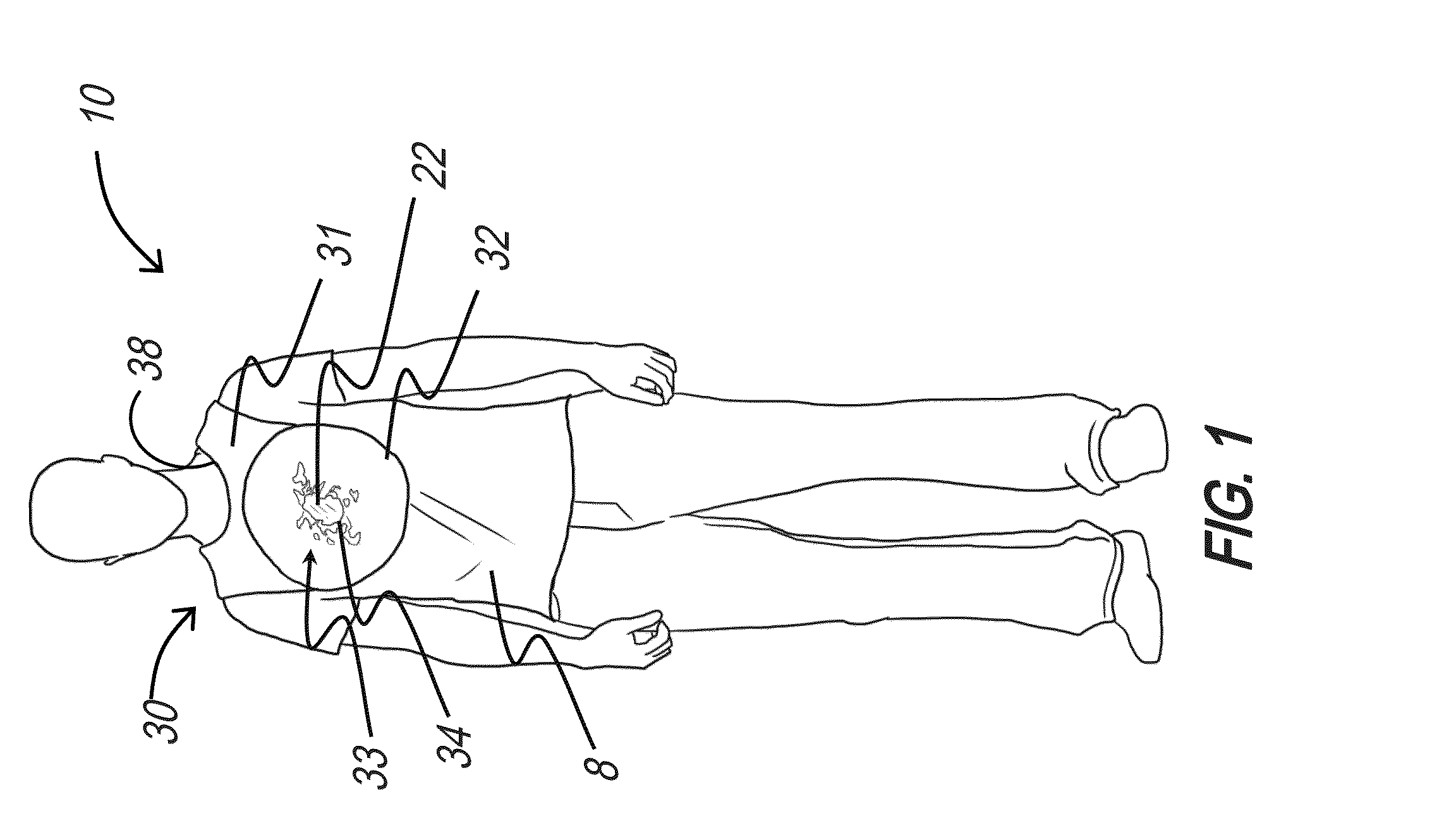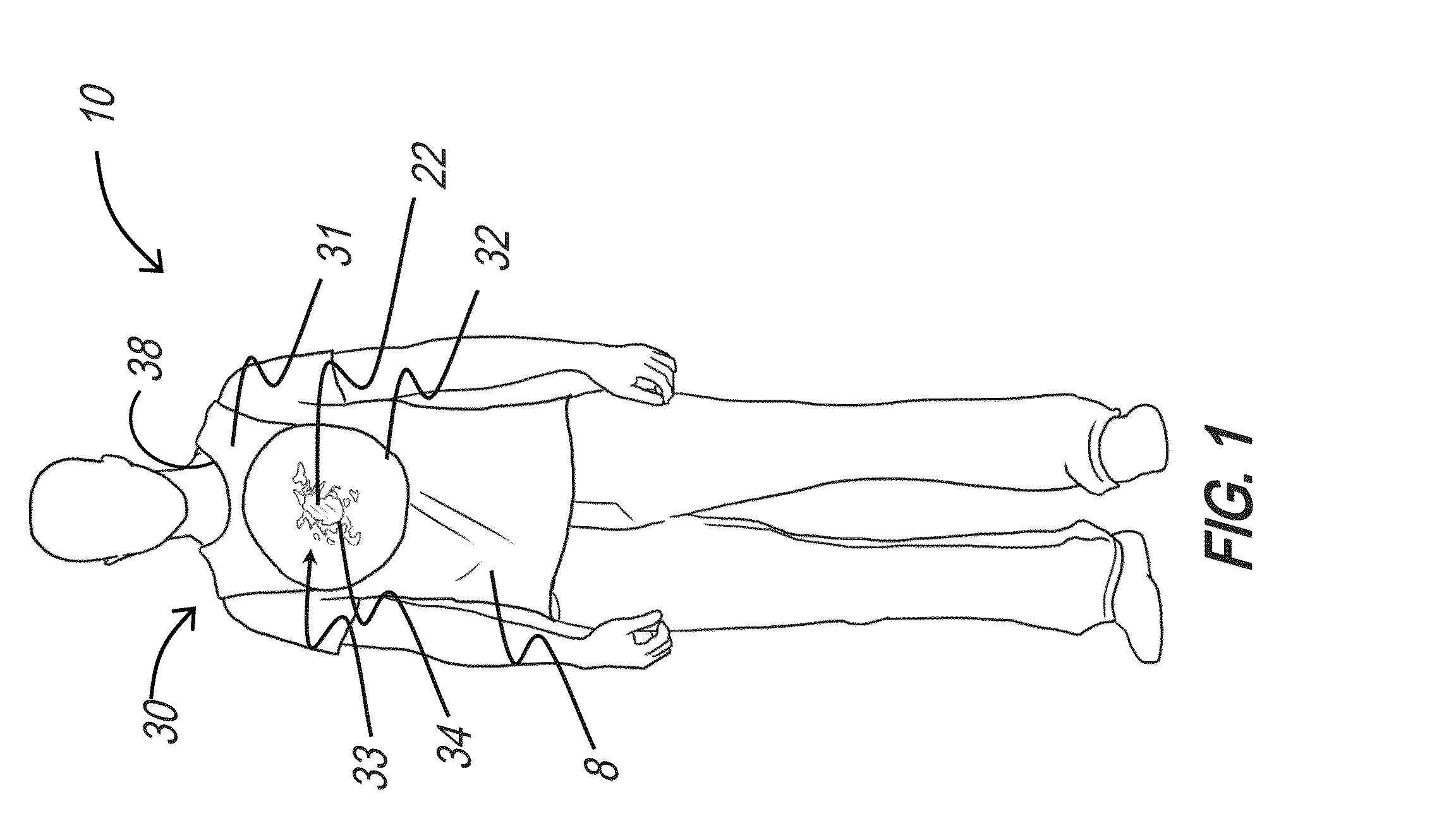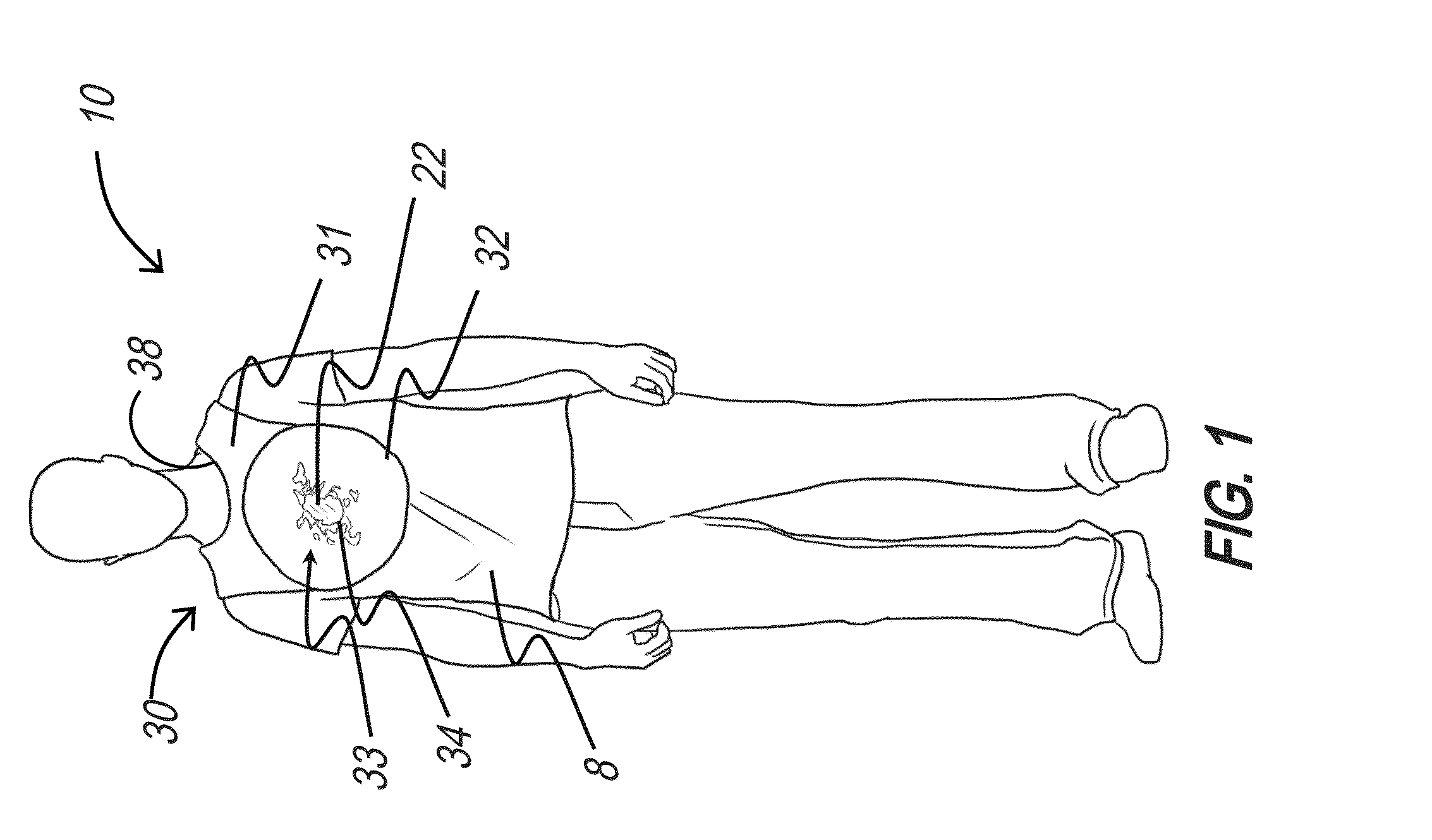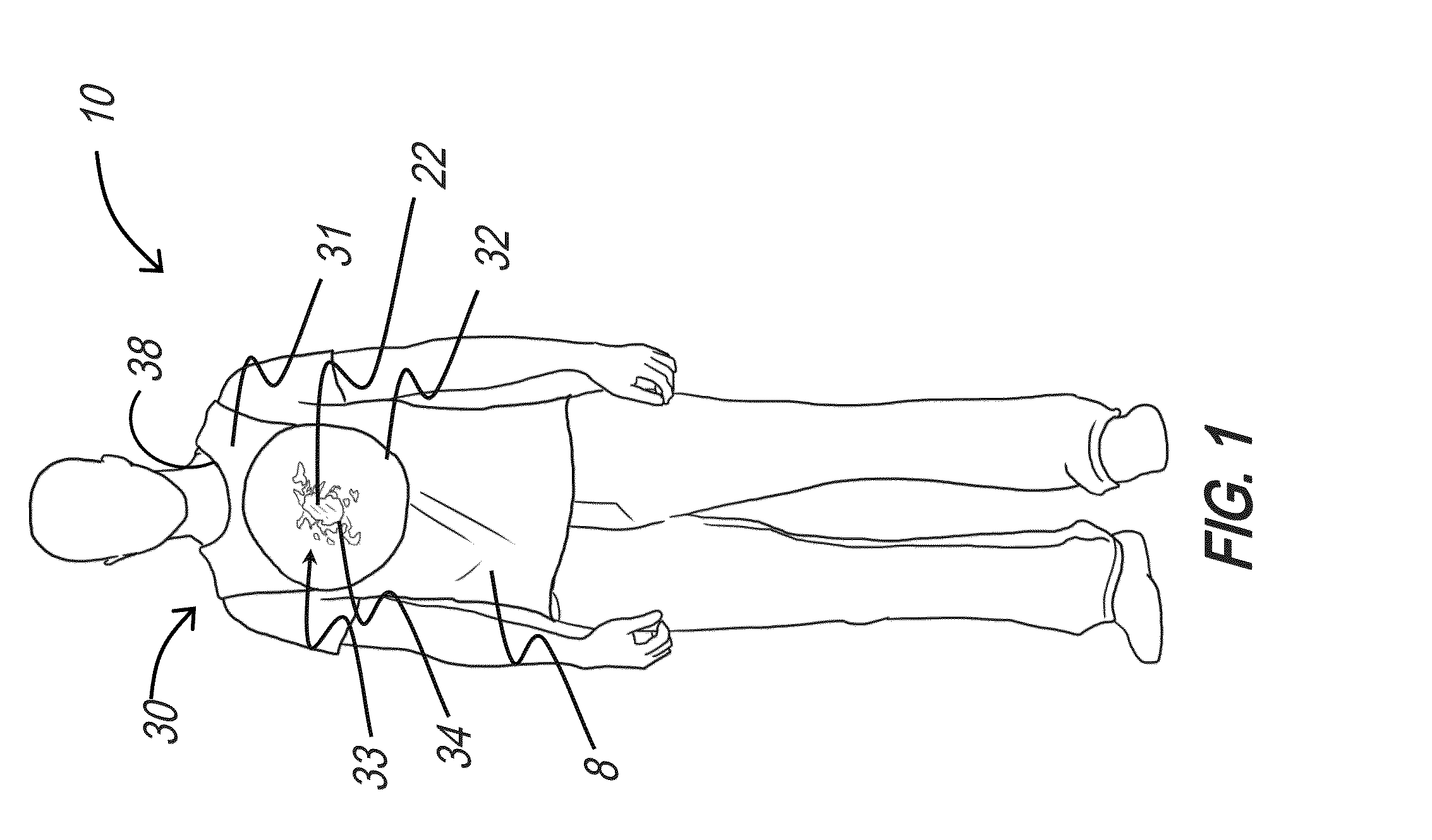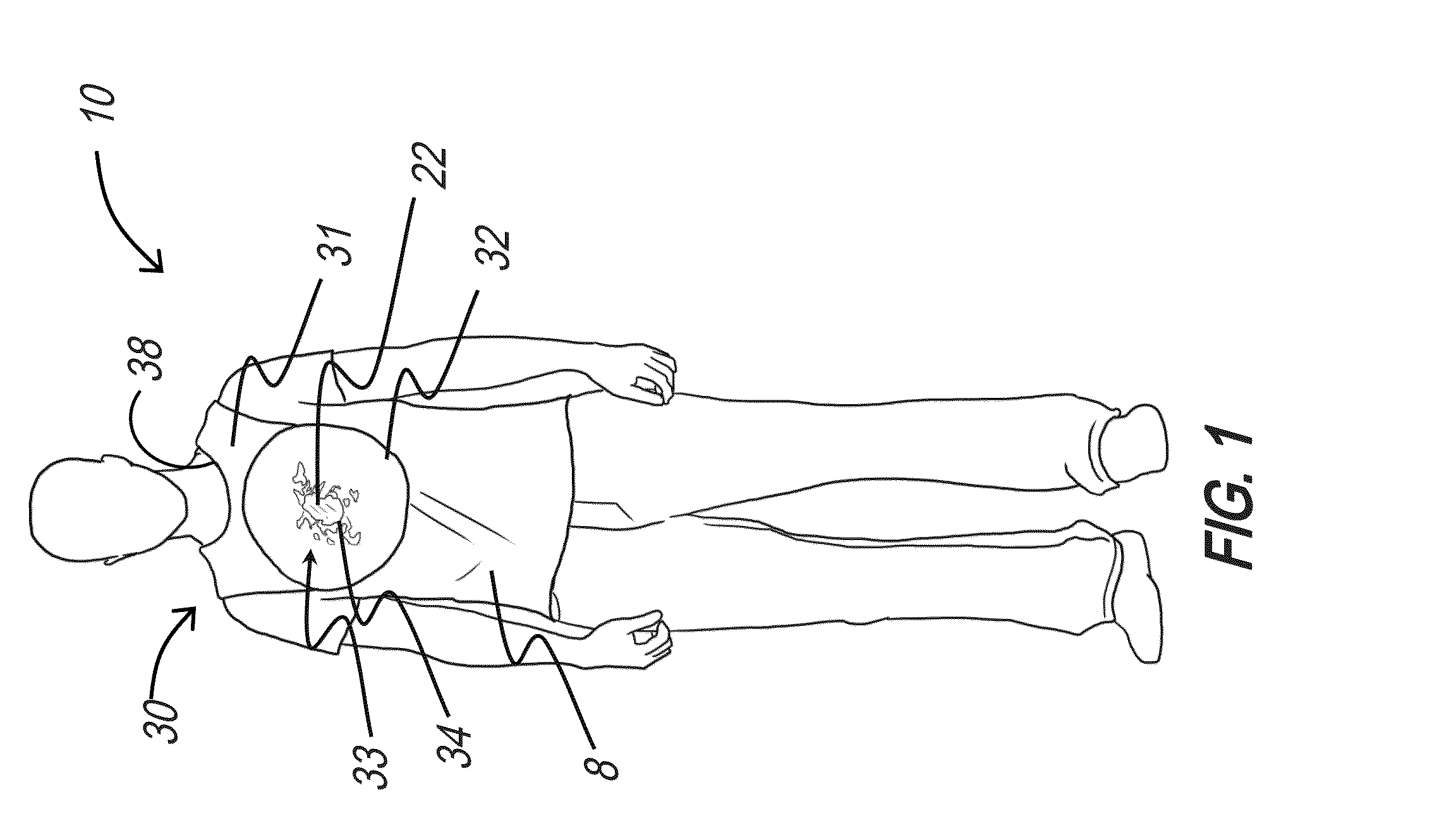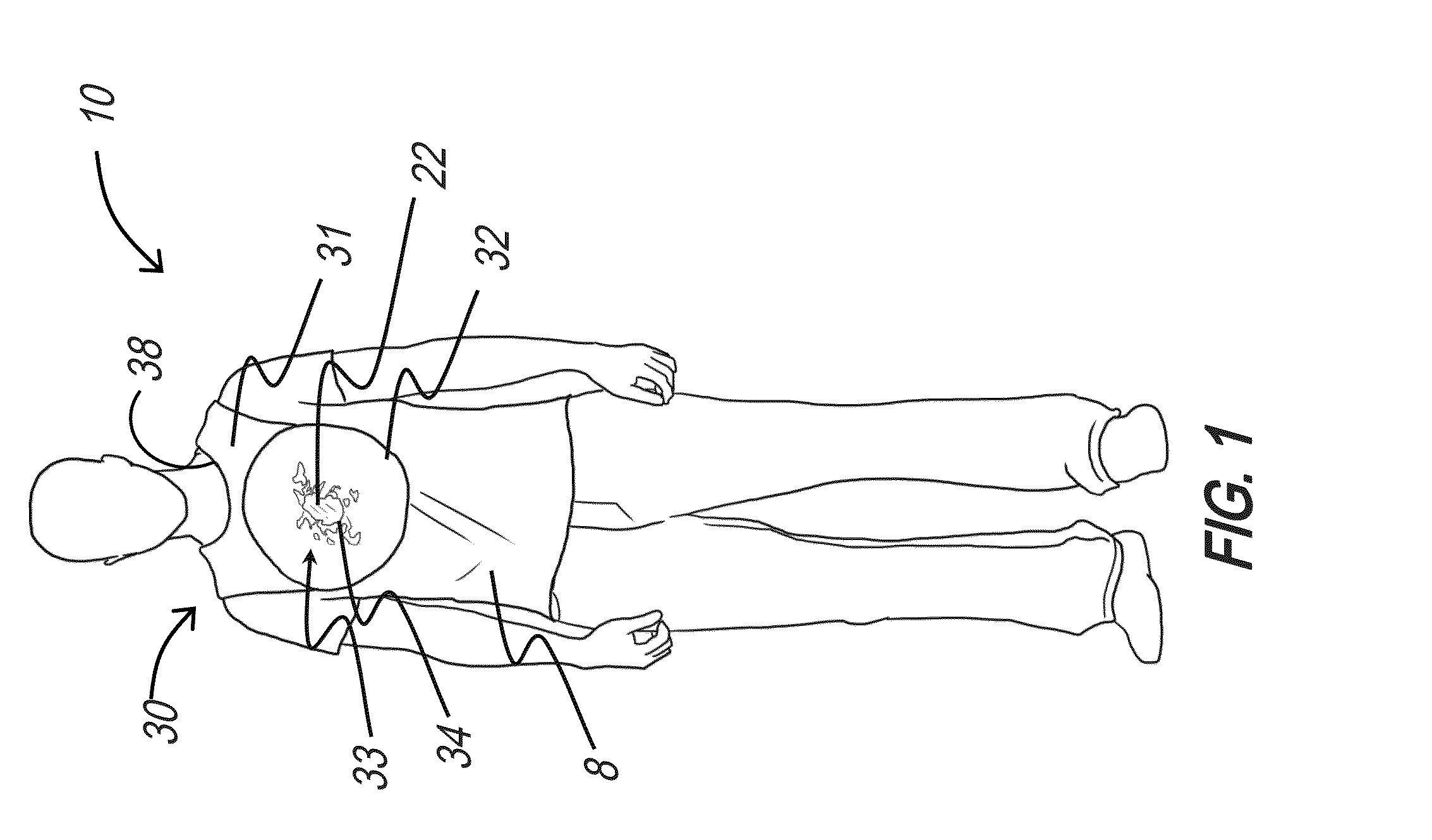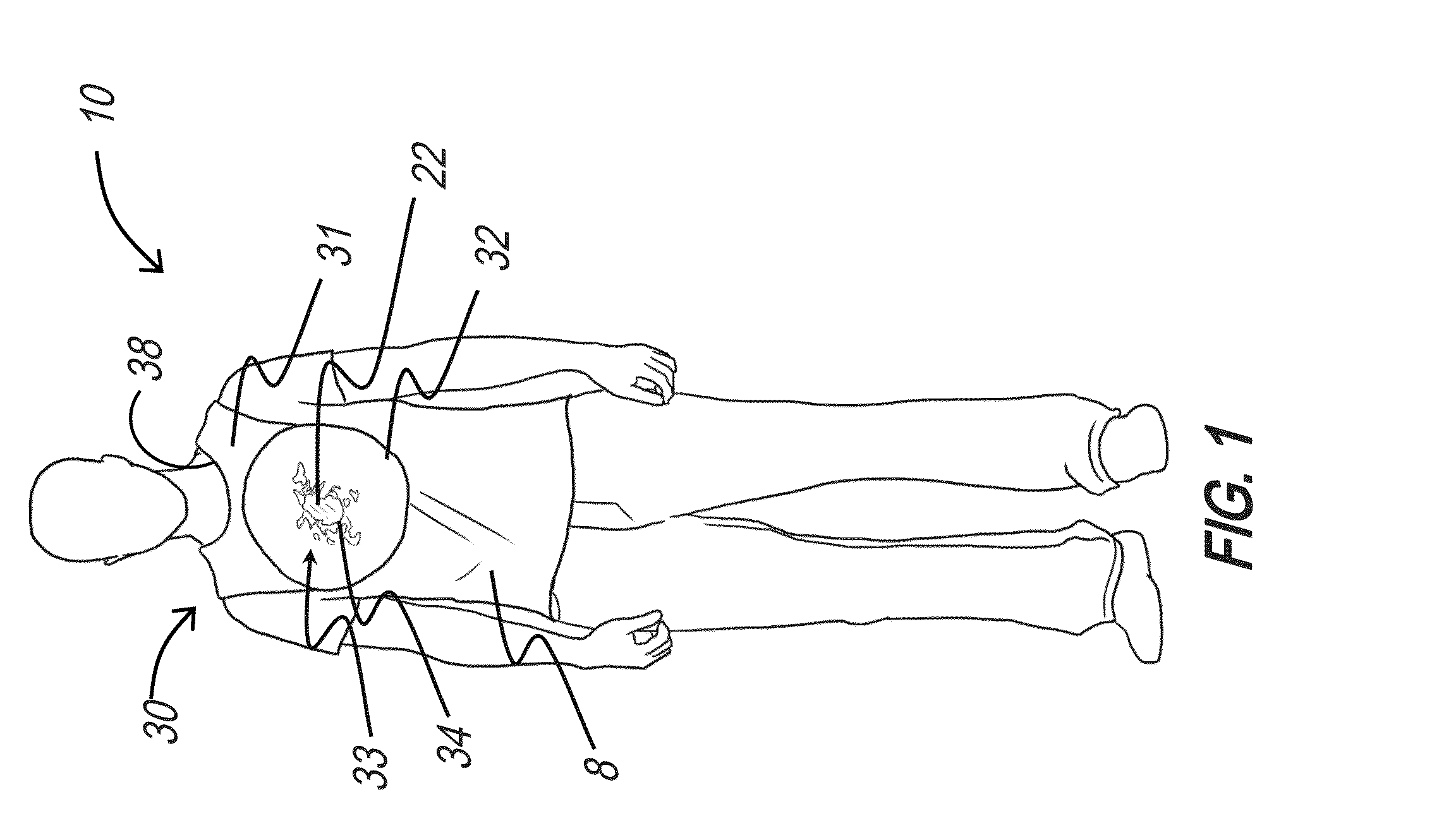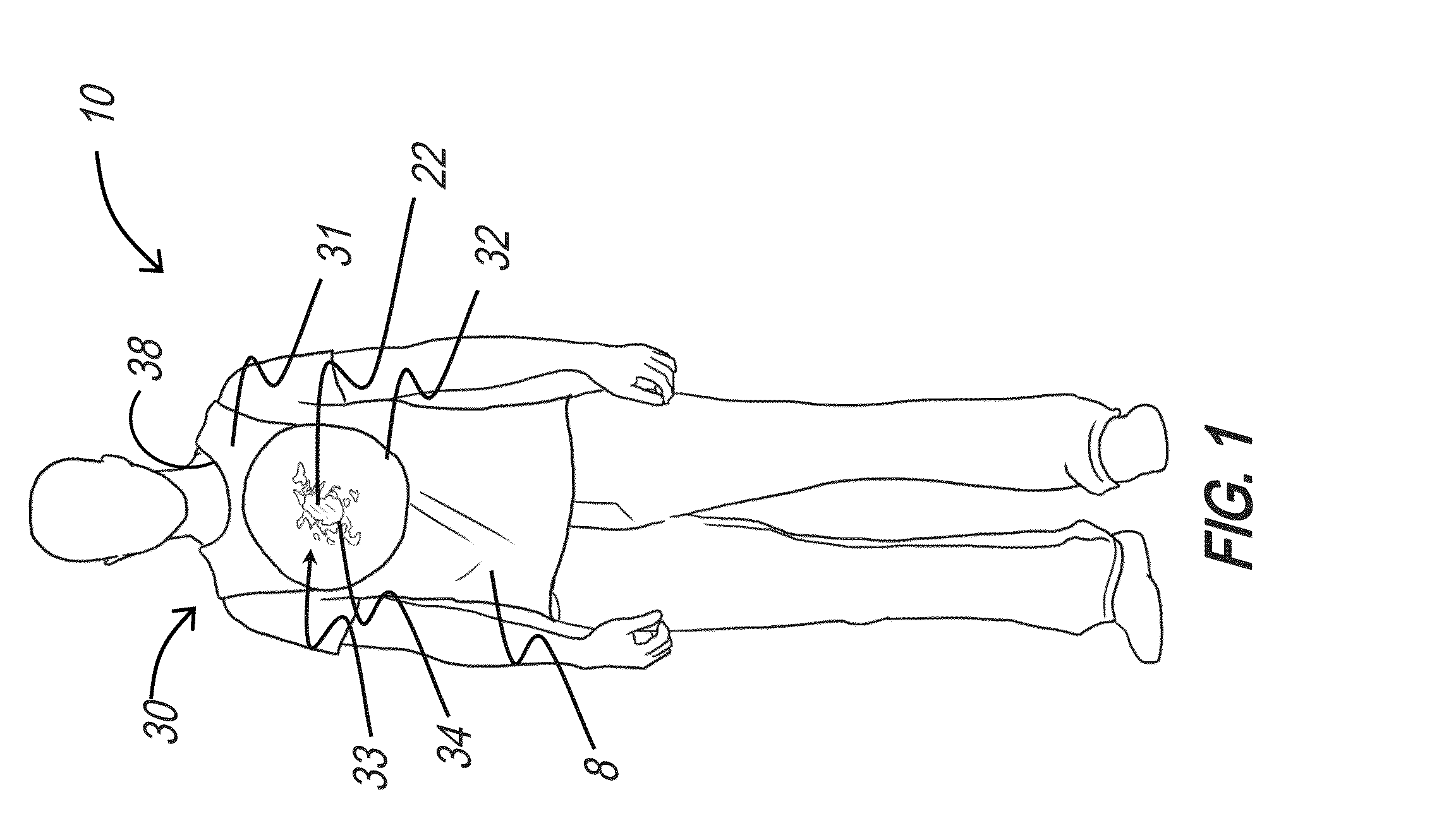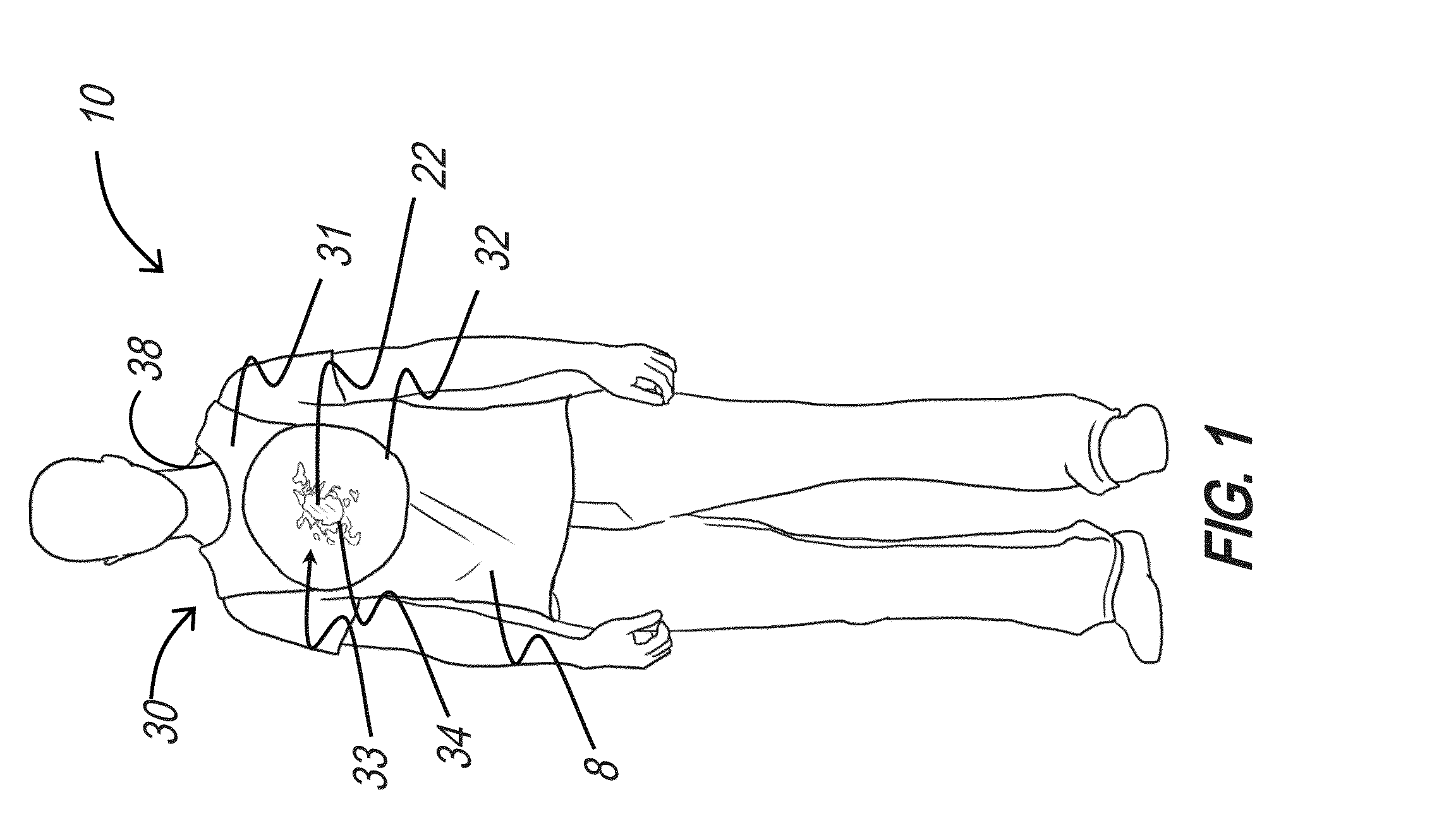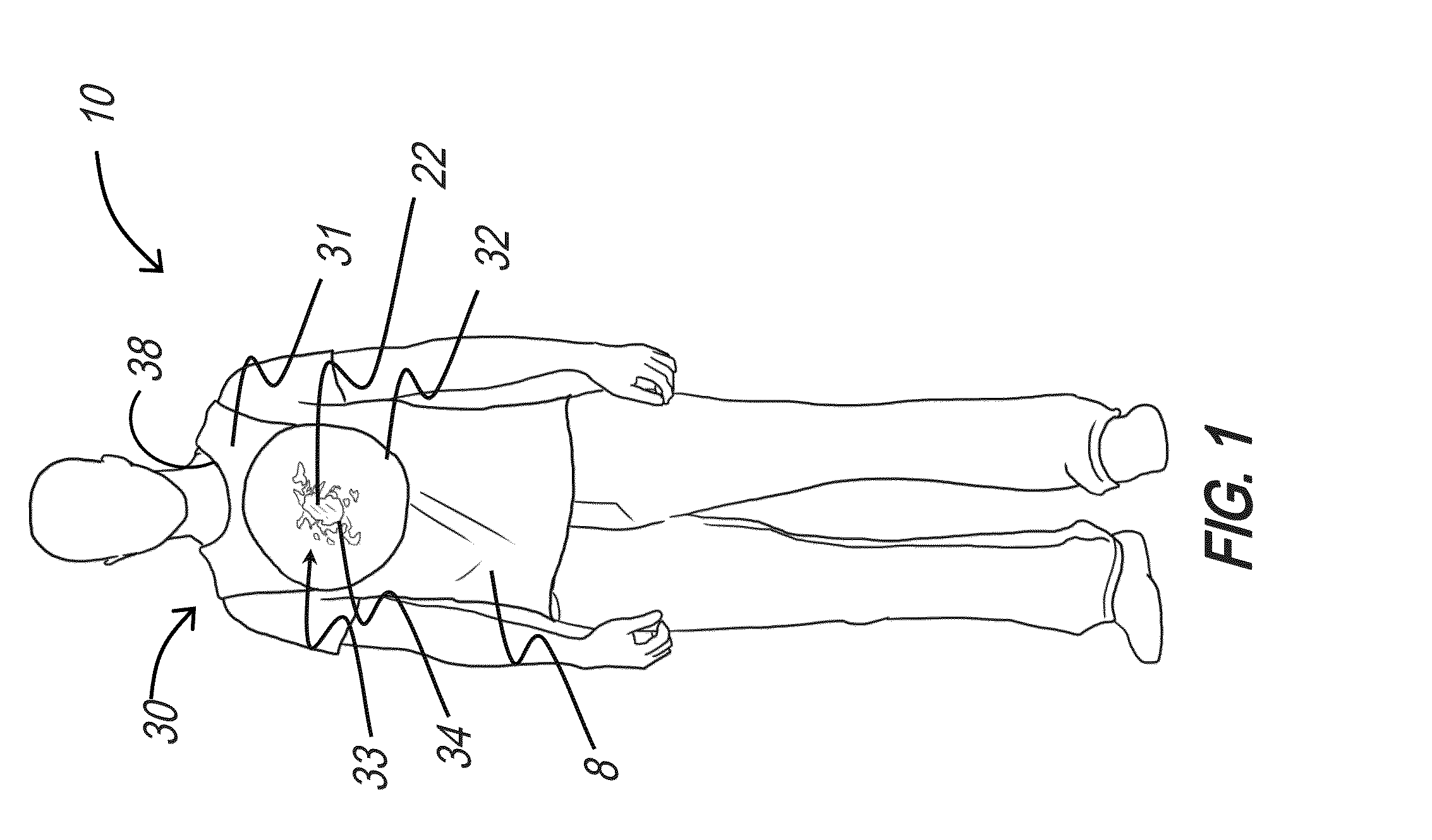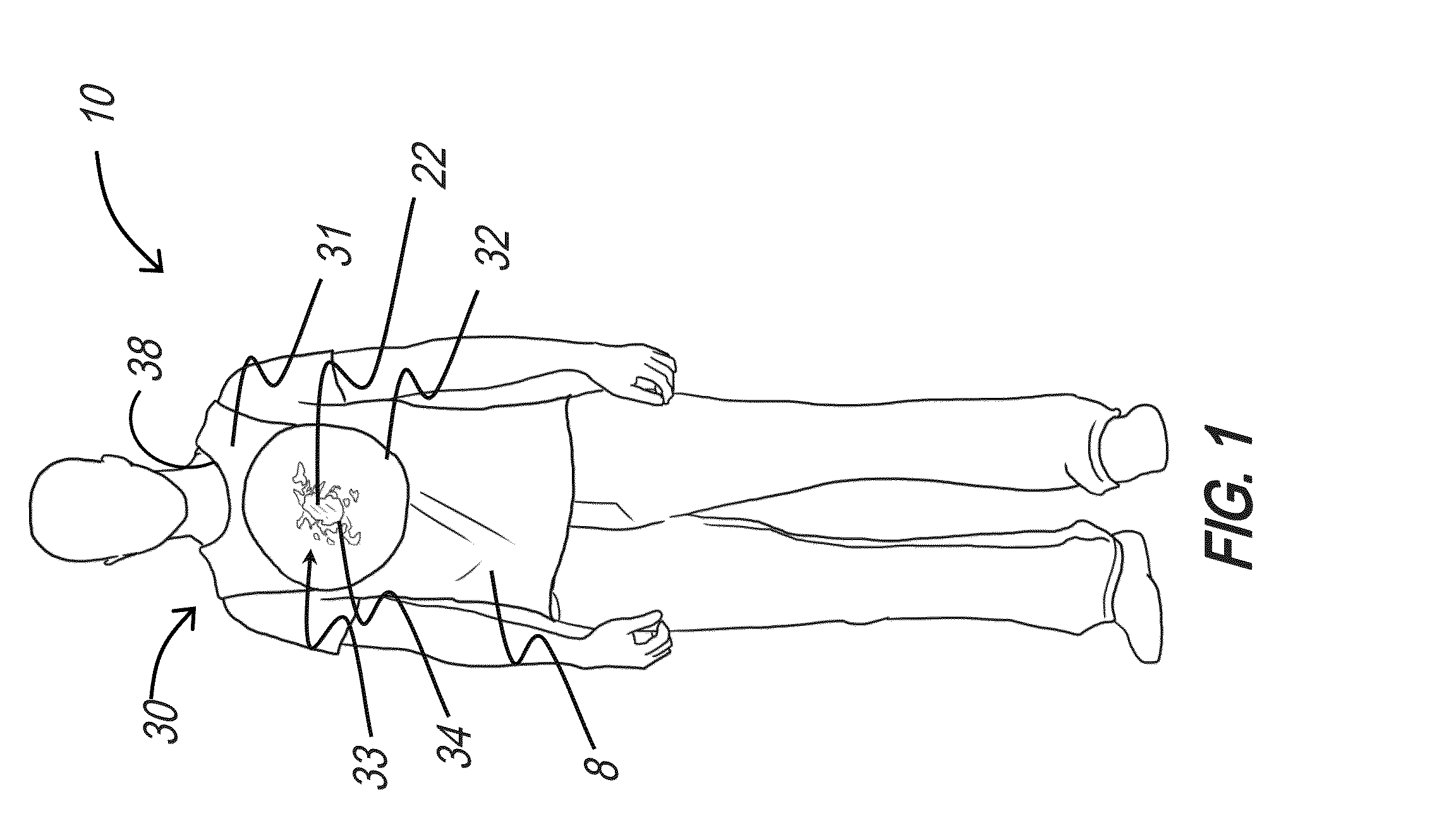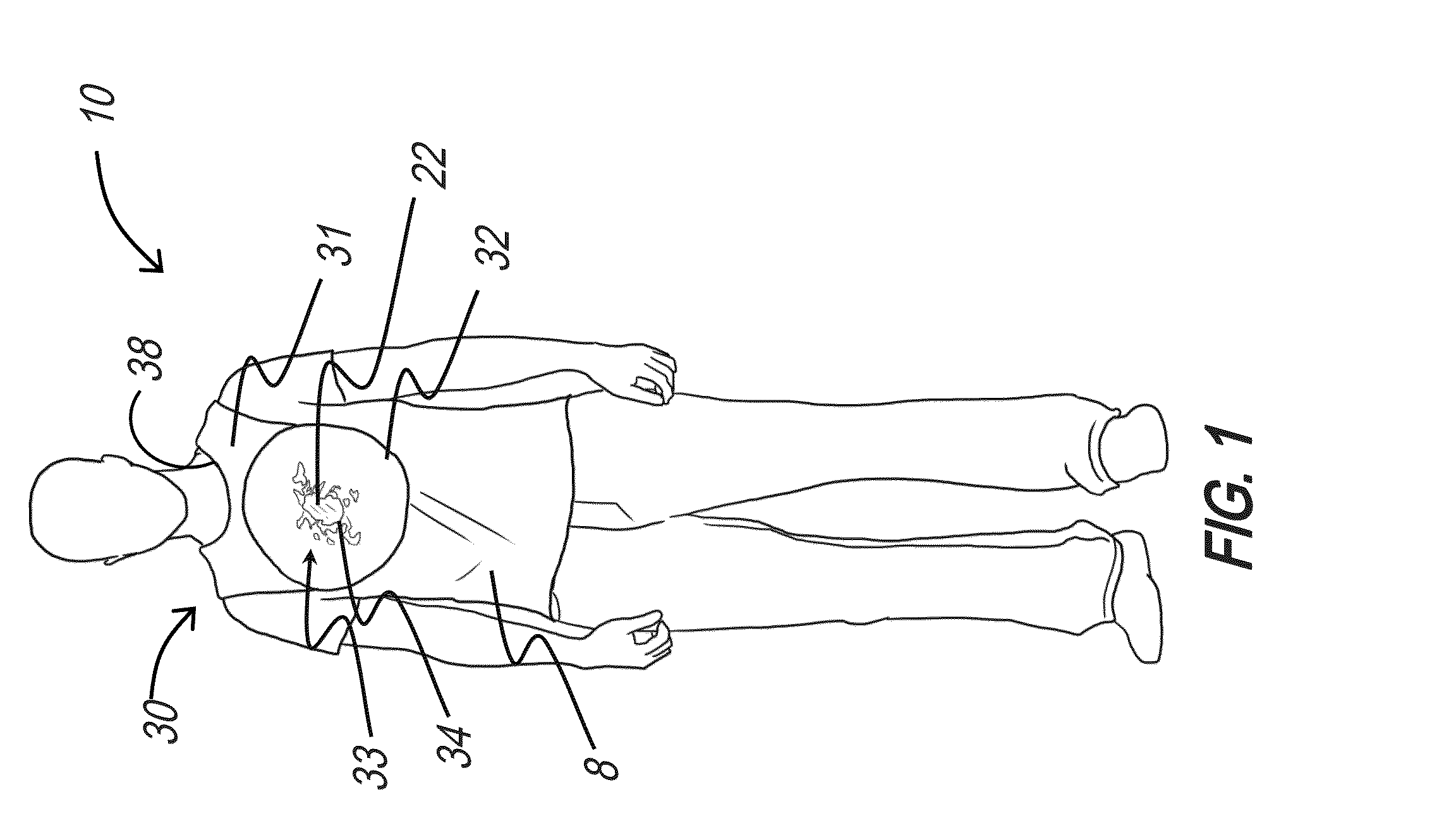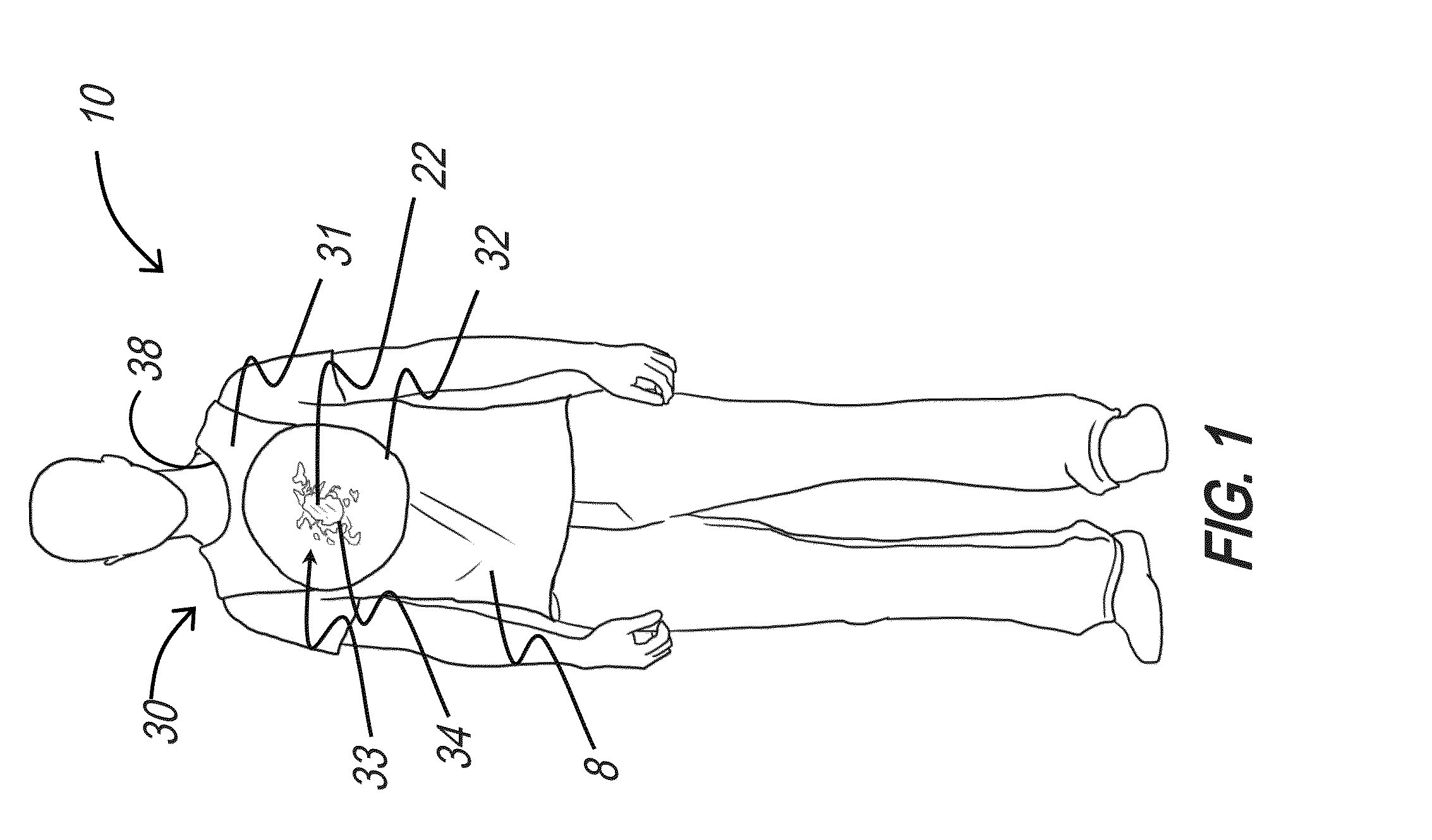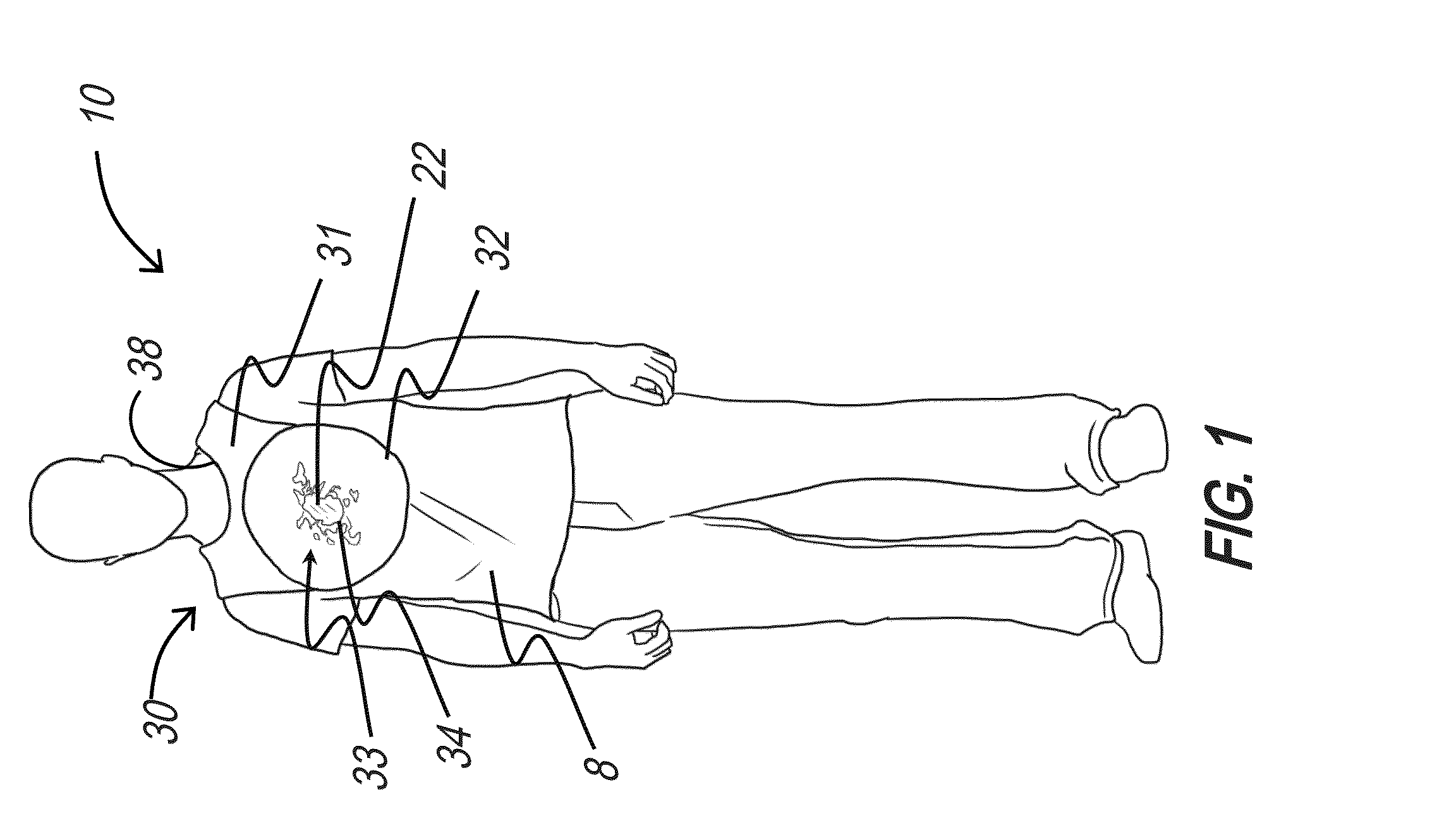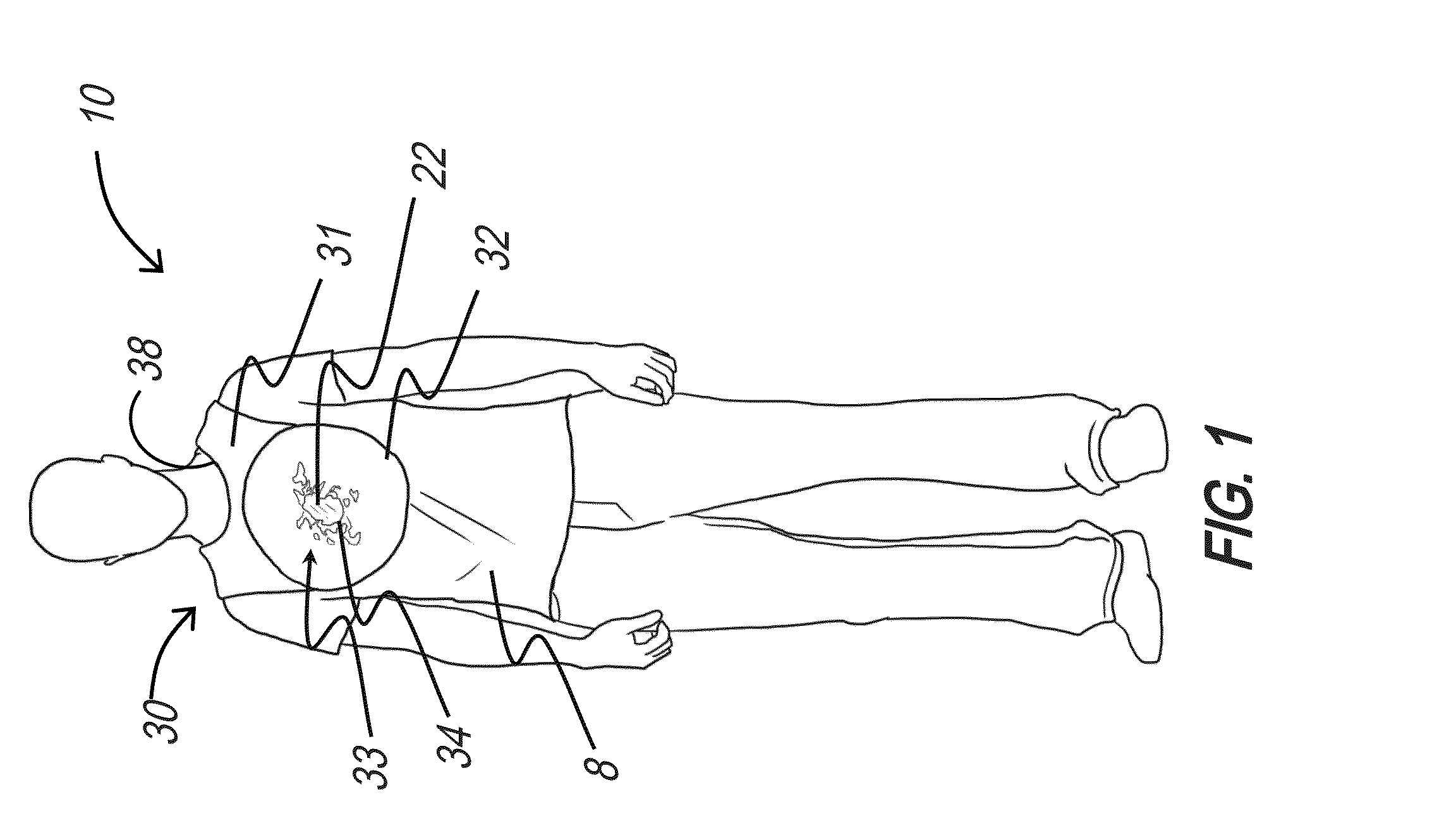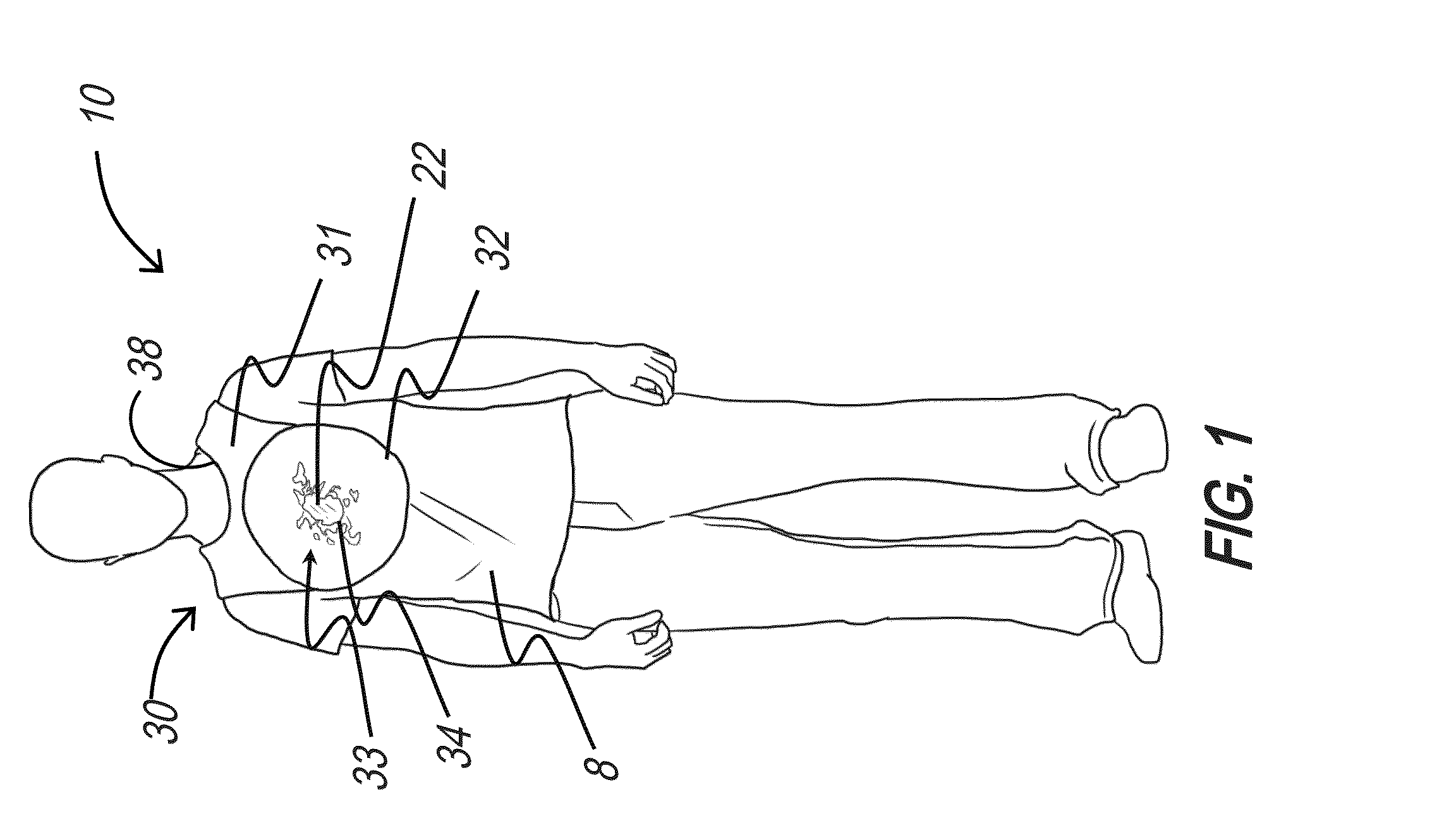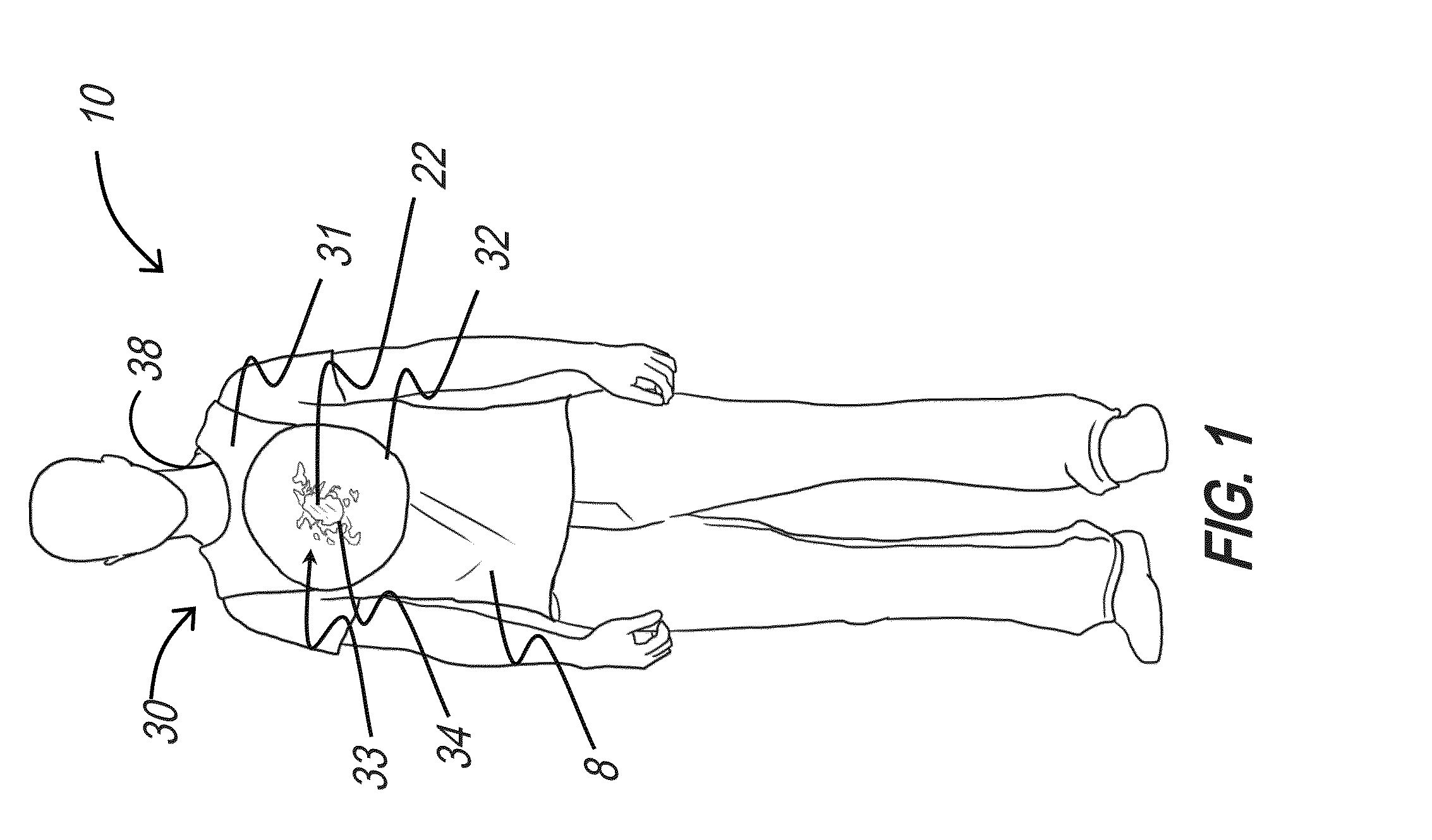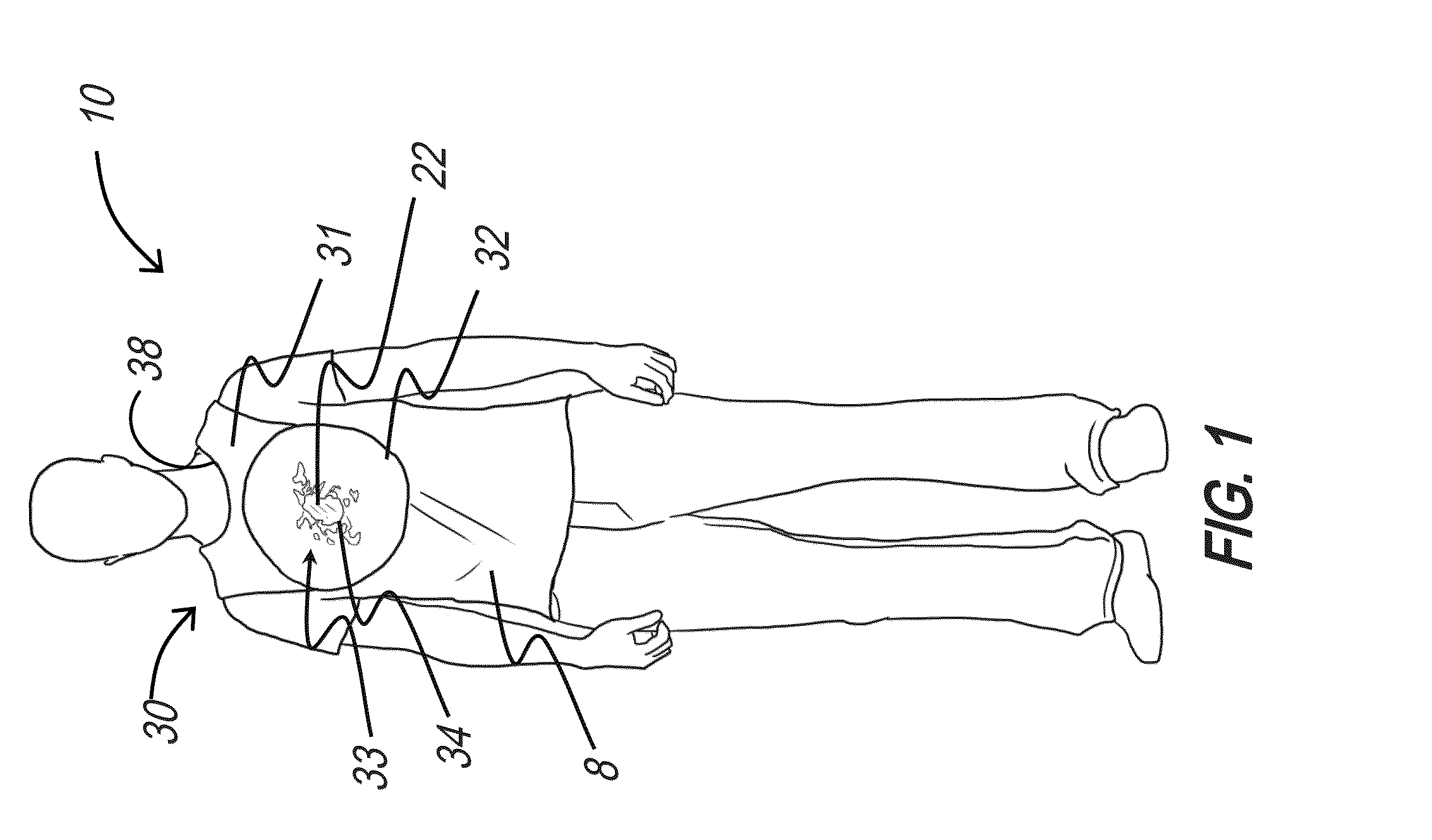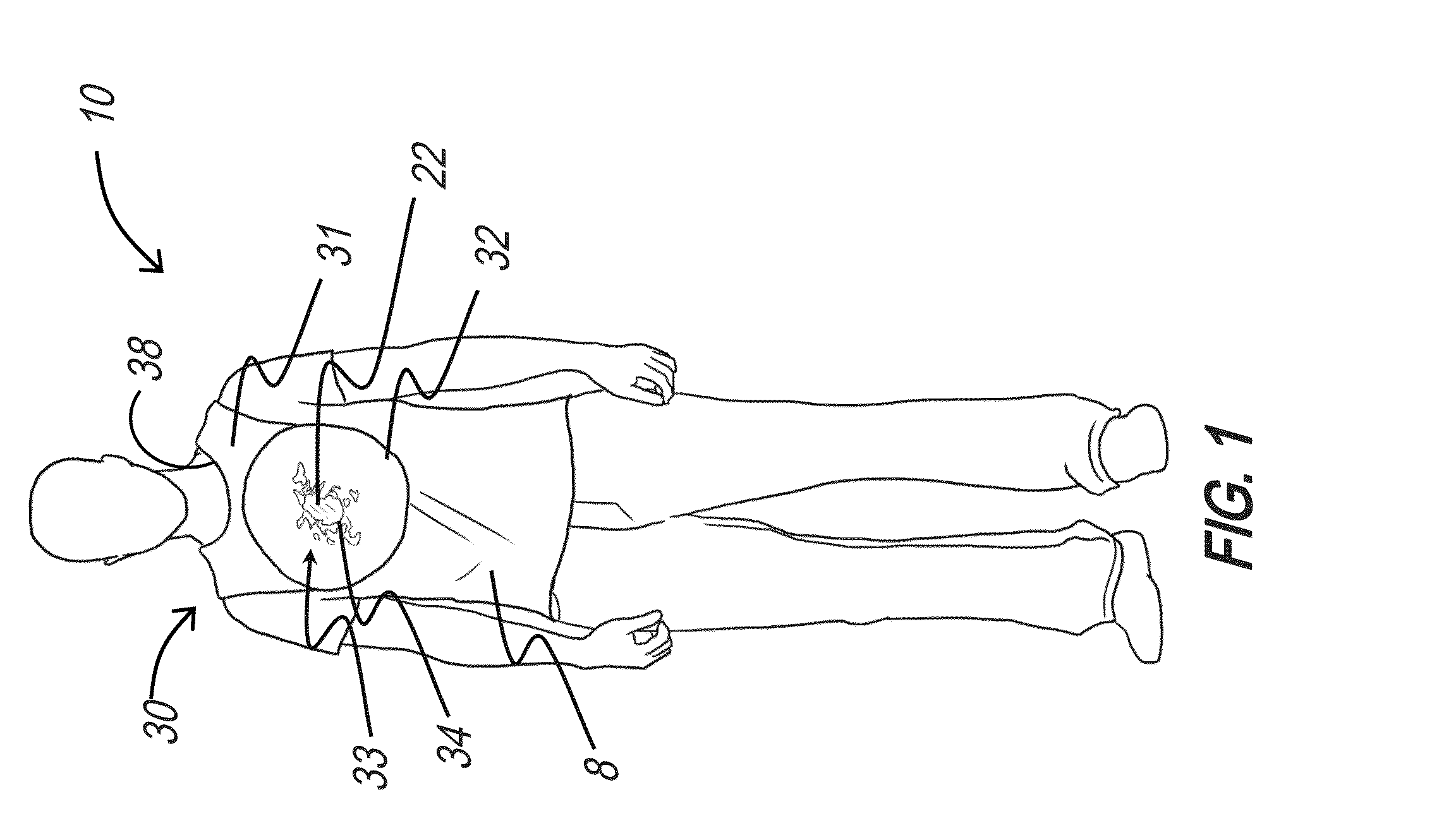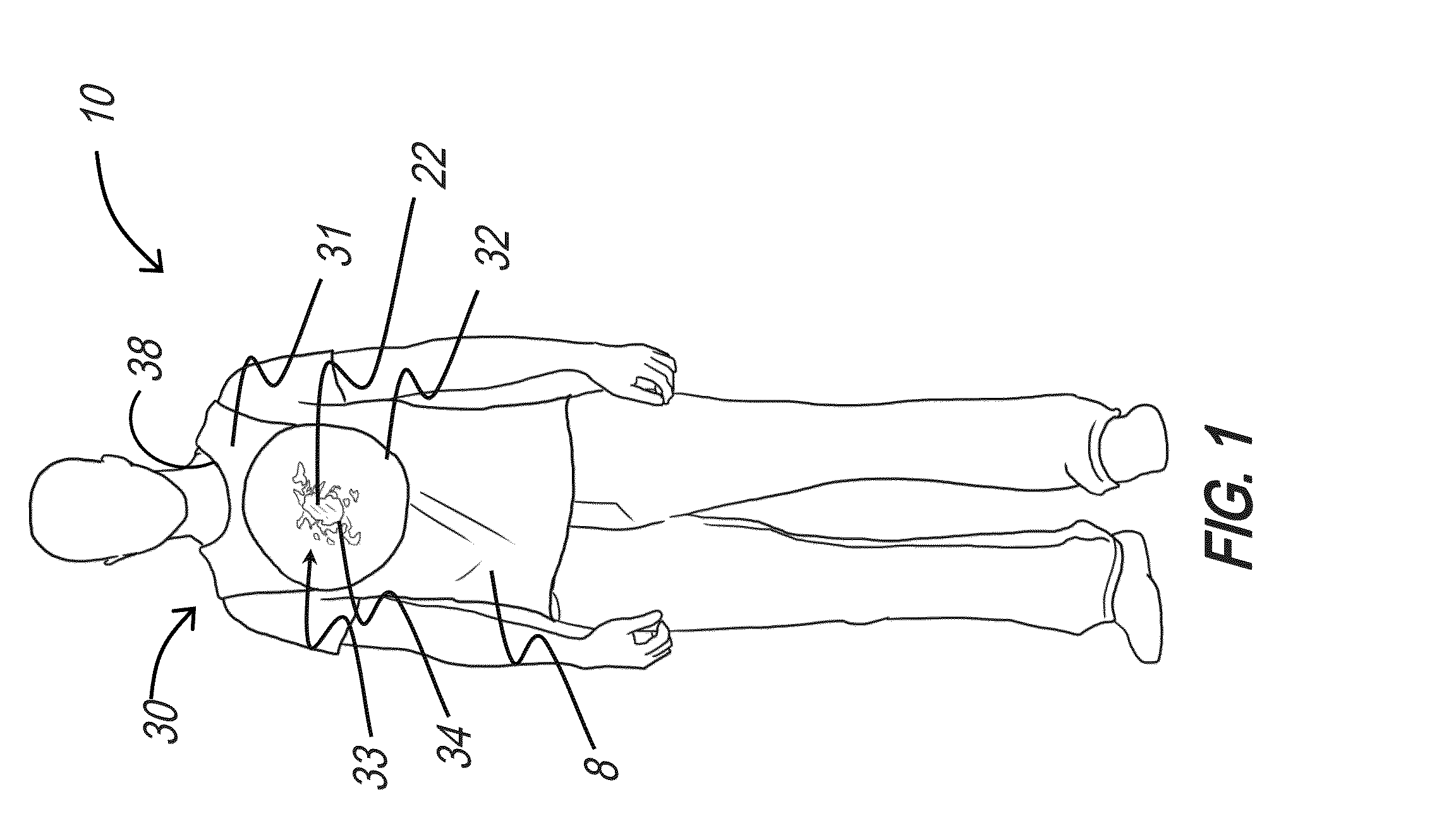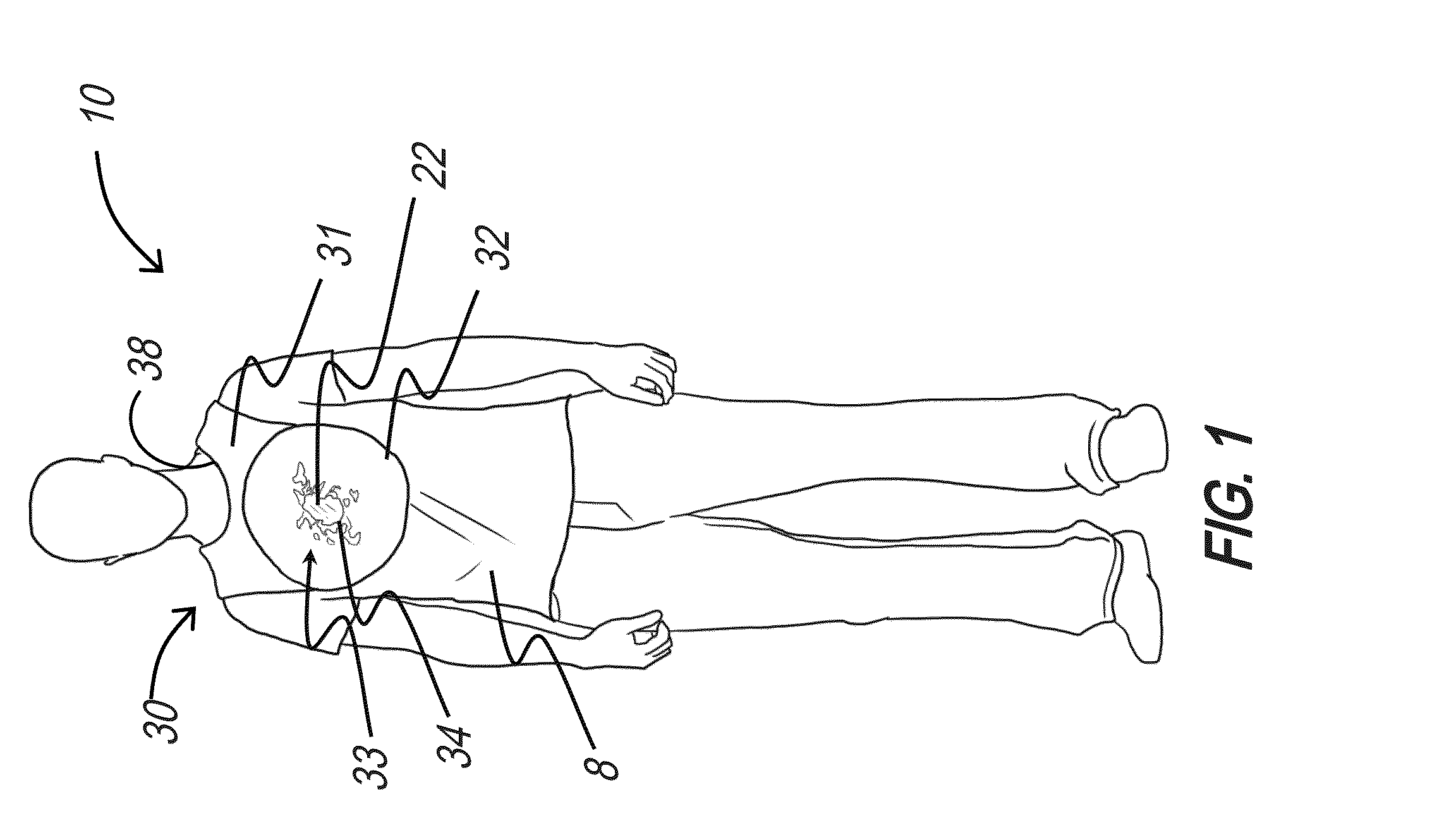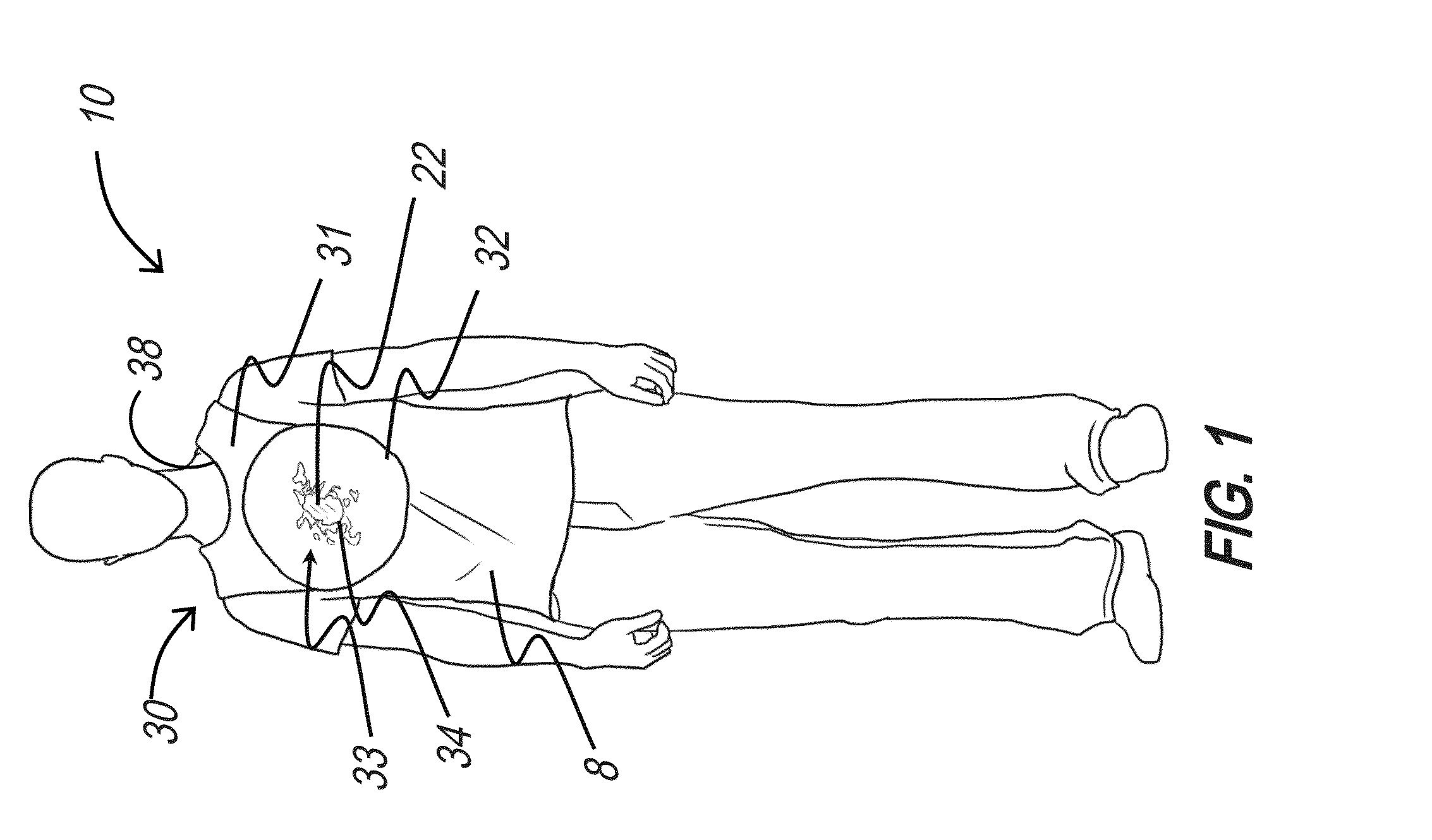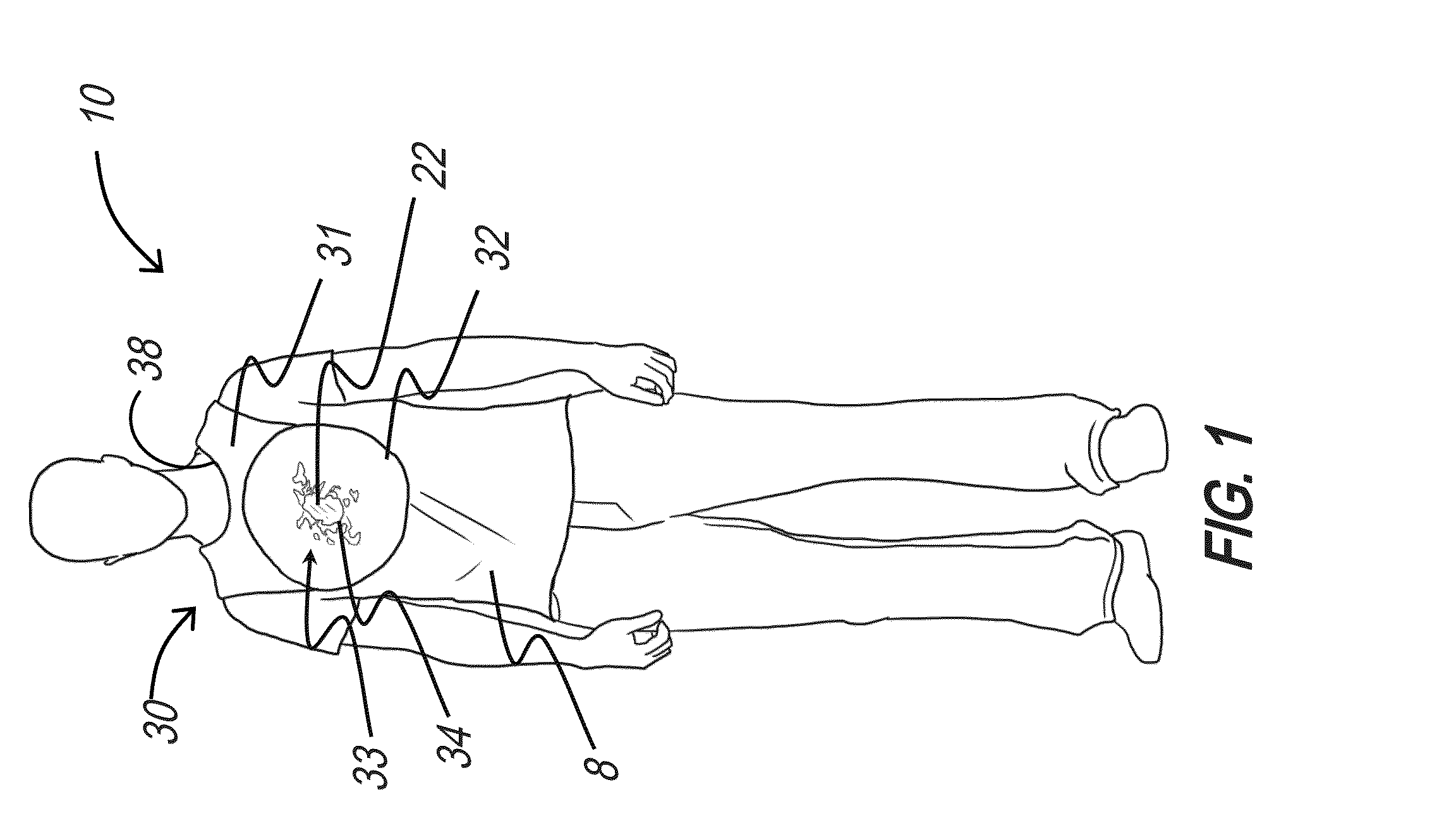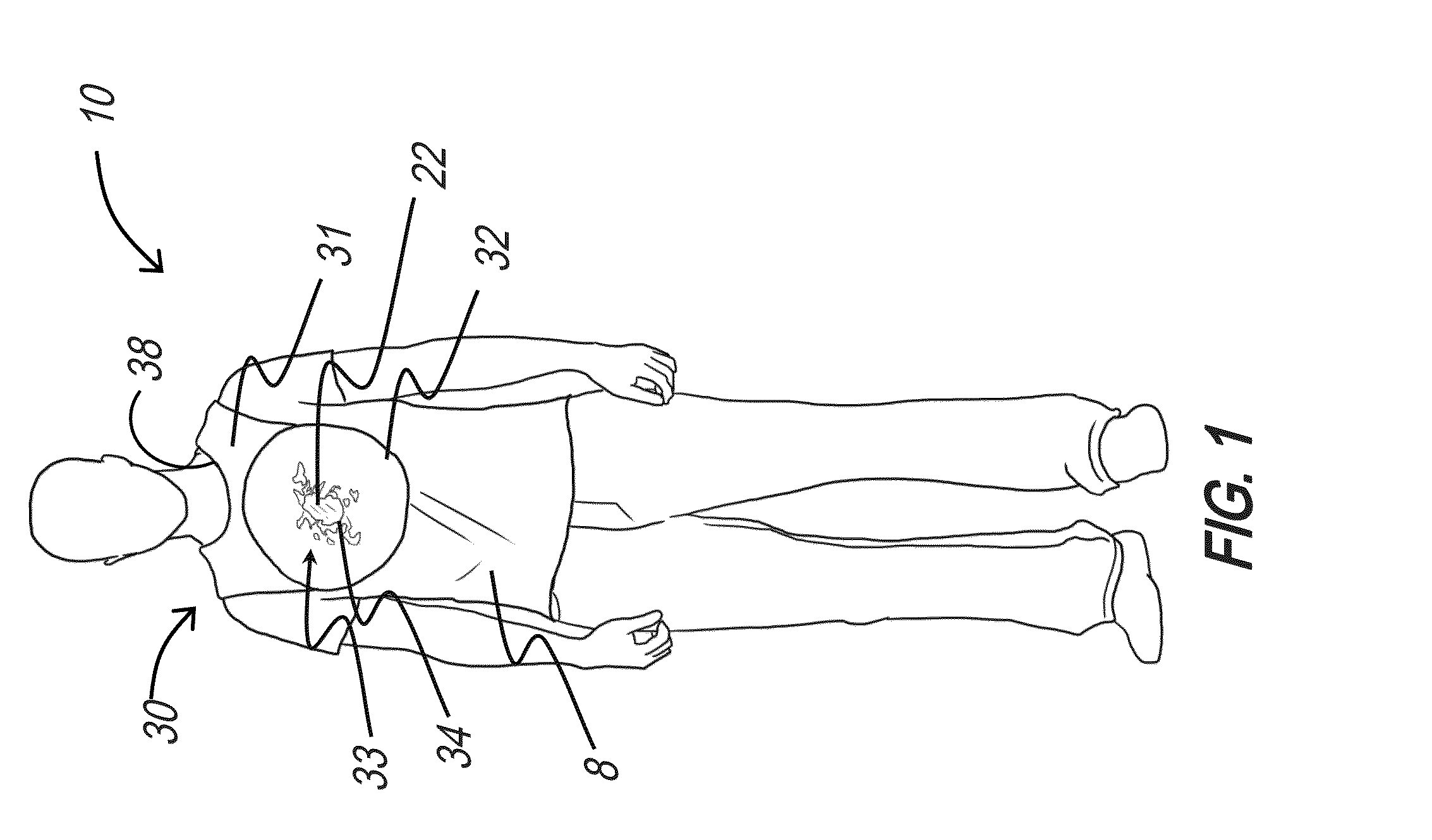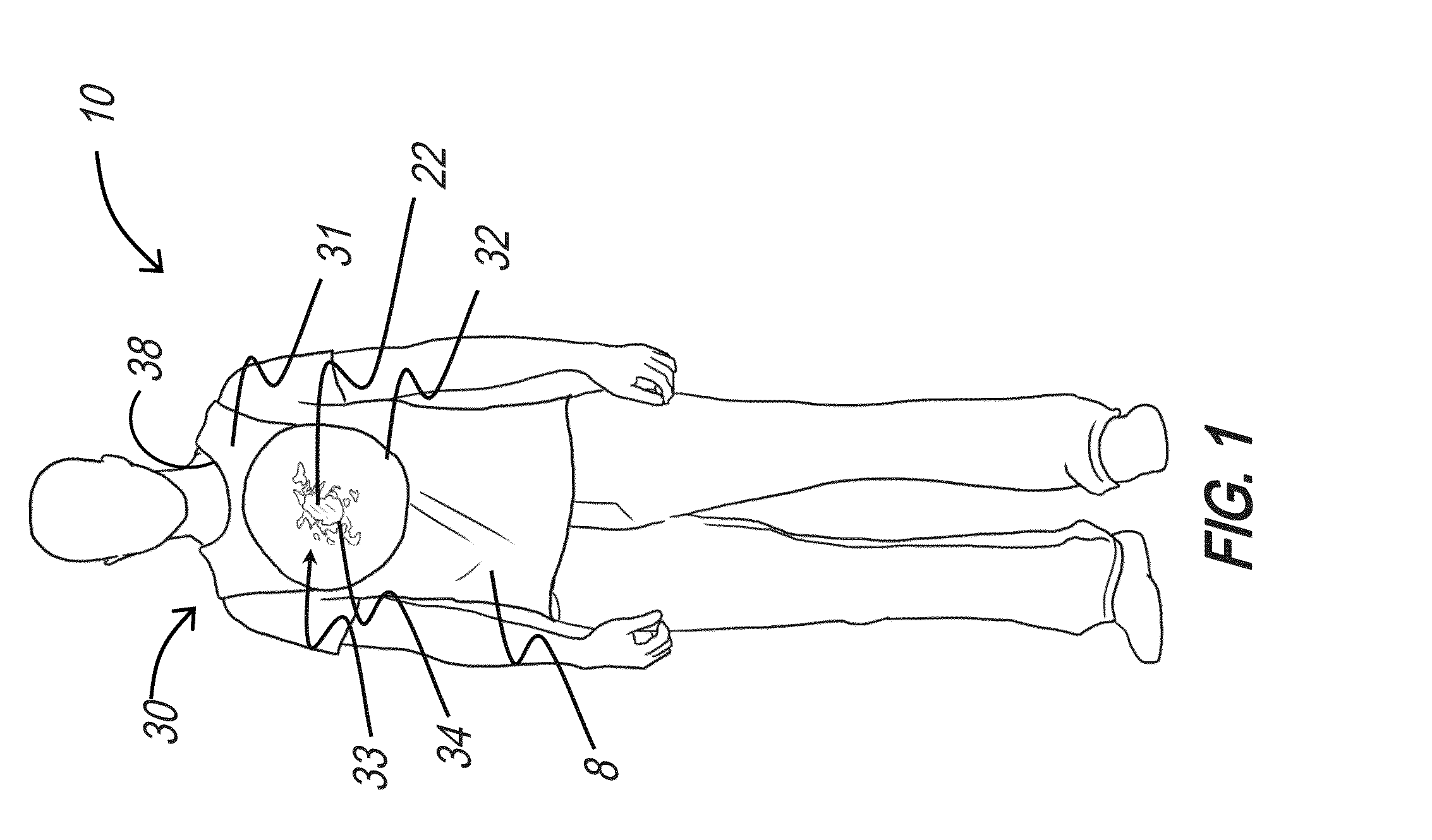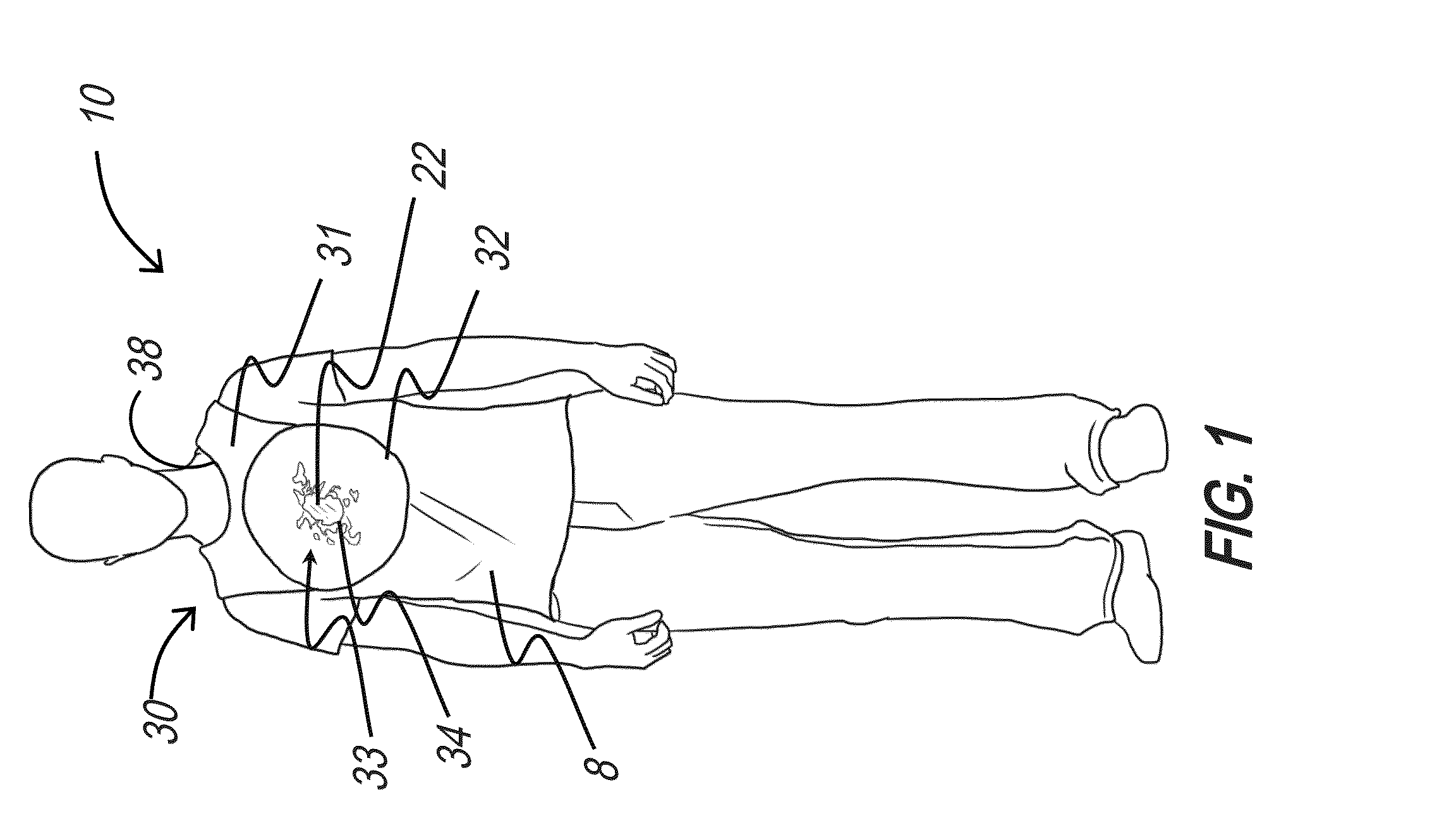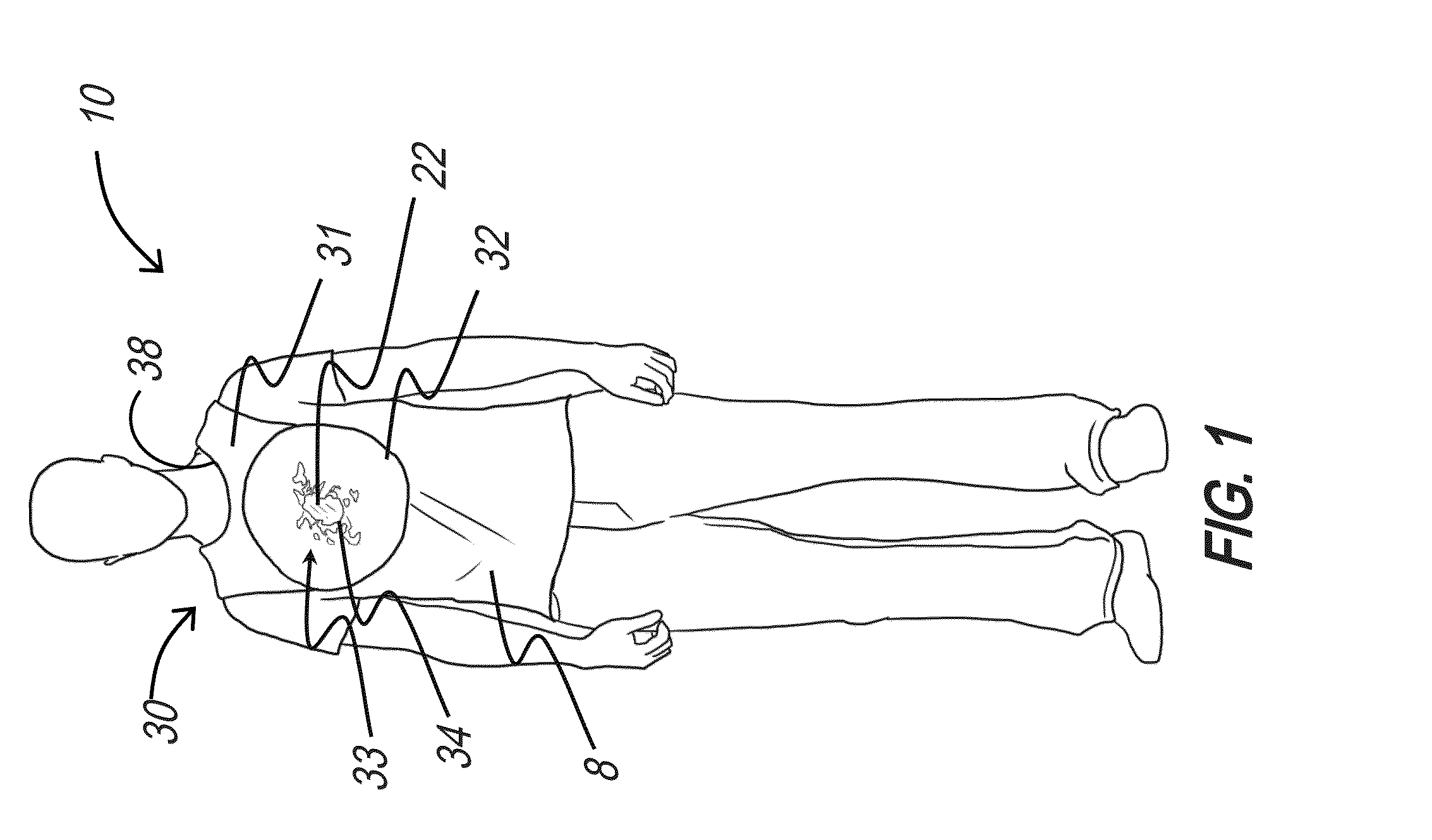Apparel Systems, Wearable Item Systems, Decor Systems, And Other Systems And Designs
This application is a continuation of pending U.S. Ser. No. 13/815,923, filed Mar. 15, 2013, which claims priority to U.S. Provisional Patent Application No. 61/706,004, filed Sep. 26, 2012, both of which are incorporated by reference in their entireties. This disclosure includes apparel (such as costumes), wearable items (such as backpacks and satchels) and decor items and systems configured to support a handheld device configured to generate a display on a screen (such as a computer-generated image or animation) that relates to the apparel, decor item, or other apparatus. For example, this disclosure includes apparel and other systems that are configured to support a handheld device configured to generate a display that is synergistic with a garment or apparatus that is part of the system. Apparel systems, wearable item systems, decor systems, and other systems configured to support a handheld device are presented. In addition, methods for using such systems are presented. Some embodiments of the present apparel systems (some of which are costume systems) comprise: a device support member comprising a body having an aperture, which is an opening (the body may have a front side and a back side); a prop coupled to or integral with the body (such as coupled to or integral with the front side); and a pocket coupled to or integral with the body (such as coupled to or integral with the back side). The device support member is configured to support a handheld device having a screen such that at least a portion of the screen is visible through the aperture, meaning at least a portion of the screen would be visible if the handheld device were supported by the device support member. Any one or more of the following features, configurations, characterizations, and/or components can be present, alone or in any combination, in more specific embodiments of such apparel systems: The body has multiple apertures. The apertures have different sizes and/or shapes. The apparel system further comprises a bag, such as a backpack, which can be worn, or a satchel, which may have a strap that can be worn. The shape of the aperture is related to the prop (e.g., to the shape, content, and/or appearance of the prop). For example, the aperture may be large enough that a display that is visible through it will be understood to be related to the prop (e.g., a display of a beating heart is related to a wound near a wearer's chest). The body is configured such that the aperture has a normally-open configuration. The apparel system further comprises a package containing the device support member. The apparel system further comprises a package containing the device support member, the package including indicia that identifies a source for one or more applications that can be executed on a handheld device that has a screen and that is sized to be supported by the device support member. The apparel system further comprises a package containing the device support member, the package including an insert that includes indicia that identifies a source for one or more applications that can be executed on a handheld device that has a screen and is sized to be supported by the device support member. The device support member further comprises a bib coupled to or integral with the body, the bib configured to be coupled to a wearer's neck. The device support member is configured to be adhered to a wearer's body. The prop may be integral with the body. The prop comprises a wound or a zipper. The apparel system further comprises a handheld device configured to run an application displaying a heart, such as a beating heart, and the handheld device is sized to be supported by the device support member. The apparel system further comprises a garment configured to be worn by a wearer over the device support member. The garment is configured such that, when the device support member is worn by a wearer and the garment is worn by the wearer over the device support member, at least a portion of the prop is visible and at least a portion of the body of the device support member is concealed. The garment is configured such that, when the device support member is worn by a wearer and the garment is worn by the wearer over the device support member, at least a portion of the prop can be made visible under wearer control and at least a portion of the body of the device support member can be concealed under wearer control. The body of the device support member is configured to be coupled directly to the garment. The device support member is couplable to the garment with hook and loop fasteners. The device support member is sewn, fused, or adhered to the garment. The device support member and/or the pocket comprises latex or latex elastomer, latex compound, silicone, PVA, elastomeric urethane, rigid urethane, rubber, ABS plastic, hot melt adhesive, or hot melt vinyl. The apparel system further comprises a handheld device configured to run an application and sized to be supported by the device support member. The application, when run, can generate a display related to the prop (such as a display that interacts with the prop), such as a beating heart and a sound effect of a beating heart, which are related to a prop that comprises a wound. The display may cause the apparel system to appear coherent. The display may have a three-dimensional appearance. Some embodiments of the present apparel systems comprise a bag having at least one aperture; and a device support member configured to be coupled to the bag. The device support member has a pocket and is configured to support a handheld device such that at least a portion of a screen of the handheld device is visible through the at least one aperture. The bag may be a backpack, which can be worn, or a satchel, which may have a strapped that can be carried or worn. Some embodiments of the present wearable item systems comprise a wearable item that includes a container having at least one aperture and being closable; at least one wearable strap coupled to the container, the wearable strap being configured to be worn over a wearer's shoulder; and a device support member coupled to the wearable item. The device support member has a pocket and is configured to support a handheld device such that at least a portion of a screen of the handheld device is visible through the at least one aperture. Any one or more of the following features, configurations, characterizations, and/or components can be present, alone or in any combination, in more specific embodiments of such wearable item systems: The wearable item further comprises a cover configured to overlap a portion of the container, and the device support member is coupled to the cover. The wearable item includes a zipper, and the container is closable with the zipper. The container comprises a graphic. The graphic comprises water. The graphic depicts a zombie, a clown, a werewolf, a barber, a wound, a face, a jack o'lantern, a kitten, a cat, a dog, a reindeer, a disco dancer, a cartoon character, a public figure, a hearth, a winter scene, a portrait, or a picture frame. The system further comprises a handheld device configured to run an application capable of generating a display on a screen related to the graphic (such as a display that interacts with the graphic and may make the wearable item system appear coherent), at least a portion of which will be visible through the at least one aperture when the handheld device is supported by the device support member. The application is capable of generating a display on the screen of one or more of a shark fin, an eye, multiple eyes, an organ, moving maggots, turning gears, moving snakes, and one or more moving spiders. The application can generate sound to accompany the display. The display is modifiable. The display may have a three-dimensional appearance. The wearable item comprises a backpack. The wearable item comprises a satchel. Some embodiments of the present apparel systems comprise a garment comprising at least one aperture; and a device support member configured to be worn underneath the garment. The device support member has a pocket and is configured to support a handheld device such that at least a portion of a screen of the handheld device is visible through the at least one aperture. Any one or more of the following features, configurations, characterizations, and/or components can be present, alone or in any combination, in more specific embodiments of such apparel systems: The apparel system further comprises a stiffening layer coupled to an inside surface of the garment. The pocket is configured to be coupled to the stiffening layer. The apparel system further comprises a hook and loop fastener coupled to the garment, where one portion of the hook and loop fastener is coupled to the pocket and another portion of the hook and loop fastener is coupled to the stiffening layer. The pocket is sewn to the stiffening layer along at least one edge of the pocket. The apparel system further comprises stiffening piping coupled to an inside surface of the garment. The garment further comprises a graphic. The at least one aperture has at least one shape that is related to the graphic (e.g., to the shape, content, and/or appearance of the graphic). For example, the at least one aperture may comprise shapes corresponding to two eyes of a graphic that includes a face. The garment further comprises a graphic surrounding the at least one aperture. The graphic may depict, for example, a zombie, a clown, a werewolf, a barber, a wound, a face, a jack o'lantern, a kitten, a cat, a dog, a reindeer, a disco dancer, a cartoon character, a public figure, a hearth, a winter scene, a portrait, or a picture frame. The apparel system further comprises a handheld device configured to run an application capable of generating a display on a screen related to the graphic (such as a display that interacts with the graphic and may make the apparel system appear coherent), at least a portion of which will be visible through the at least one aperture when the handheld device is supported by the device support member. The apparel system further comprises a handheld device configured to run an application capable of generating a display on a screen related to the graphic, at least a portion of which will be visible through the at least one aperture when the handheld device is supported by the device support member. The application is capable of generating a display on the screen of one or more of an eye, multiple eyes, and an organ (such as a heart, and, more specifically, a beating heart). The eye, or the eyes, may be moving, and may be accompanied by a sound effect. The display is modifiable. For example, the application may be configured such that the display can be scaled and positioned to appropriately line up with the aperture. The display (which can be an animation) can be interactive and configured to play audio to further enhance the synergistic effect of the apparel system. The display may have a three-dimensional appearance. Some embodiments of the present apparel systems comprise a garment comprising at least one aperture; a pocket configured to be worn underneath the garment; and a handheld device configured to be supported, at least in part, by the pocket and comprising a screen and an application configured to generate a display on the screen. The display is configurable to be visible through the at least one aperture when the handheld digital device is supported, at least in part, by the pocket. Any one or more of the following features, configurations, characterizations, and/or components can be present, alone or in any combination, in more specific embodiments of such apparel systems: The apparel system further comprises a stiffening layer coupled to an inside surface of the garment. The pocket is configured to be coupled to the stiffening layer. The apparel system further comprises a hook and loop fastener coupled to the garment, where one portion of the hook and loop fastener is coupled to the pocket and another portion of the hook and loop fastener is coupled to the stiffening layer. The pocket is sewn to the stiffening layer along at least one edge of the pocket. The apparel system further comprises stiffening piping coupled to an inside surface of the garment. The garment further comprises a graphic. The at least one aperture has at least one shape that is related to the graphic (e.g., to the shape, content, and/or appearance of the graphic). For example, the at least one aperture may comprise shapes corresponding to two eyes of a graphic that includes a face. The garment further comprises a graphic surrounding the at least one aperture. The graphic may depict, for example, a zombie, a clown, a werewolf, a barber, a wound, a face, a jack o'lantern, a kitten, a cat, a dog, a reindeer, a disco dancer, a cartoon character, a public figure, a hearth, a winter scene, a portrait, or a picture frame. The display is modifiable. For example, the application may be configured such that the display can be scaled and positioned to appropriately line up with the aperture. The display (which can be an animation) can be interactive and configured to play audio to further enhance the synergistic effect of the apparel system. Some embodiments of the present methods of using an apparel system comprise obtaining an apparel system comprising: a garment comprising at least one aperture; a pocket configured to be worn underneath the garment; and a handheld device configured to be supported, at least in part, by the pocket and comprising a screen and an application configured to generate a display on the screen; running the application; and supporting the handheld device, at least in part, using the pocket such that the display is visible through the at least one aperture. Any one or more of the following features, configurations, characterizations, and/or steps can be present, alone or in any combination, in more specific embodiments of such methods: The method further comprises selecting, on the handheld device, an animation from the application. The method further comprises touching the screen to manipulate a feature of the display to correspond in size to the at least one aperture. The garment comprises a graphic and the display is related to the graphic (such as a display that interacts with the graphic and may make the apparel system appear coherent). The apparel system that is subject to the method further comprises a device support member comprising a prop, the pocket being a portion of the device support member, and the display is related to the prop. The shape of the at least one aperture is related to the prop (e.g., to the shape, content, and/or appearance of the prop). For example, the at least one aperture may be large enough that the display that is visible through it will be understood to be related to the prop (e.g., a display of a beating heart is related to a wound near a wearer's chest).The prop comprises a wound. The display comprises one or more of a sound effect, an eye, multiple eyes, and an organ, such as a heart, and, more specifically, a beating heart. The sound effect may be associated with what is displayed, such as a sound effect of a beating heart to accompany the displayed beating heart. The graphic may depict, for example, a zombie, a clown, a werewolf, a barber, a wound, a face, a jack o'lantern, a kitten, a cat, a dog, a reindeer, a disco dancer, a cartoon character, a public figure, a hearth, a winter scene, a portrait, or a picture frame. Some embodiments of the present decor systems comprise a front surface and back surface; at least one aperture through the front surface and at least one aperture through the back surface; and a device support member coupled to the back surface. The device support member is configured to support a handheld device comprising a screen such that a portion of the screen is visible through the at least one aperture. Any one or more of the following features, configurations, characterizations, and/or components can be present, alone or in any combination, in more specific embodiments of such decor systems: The first and second surfaces are surfaces of the same material, and the at least one aperture through the front surface and the at least one aperture through the back surface are the same at least one aperture. The front surface further comprises a graphic. The front surface further comprises a graphic surrounding the at least one aperture. The decor system further comprises a handheld device configured to generate a display related to the graphic, at least a portion of which (meaning a portion of the display) is visible through the at least one aperture when the handheld device is supported by the device support member. The decor system further comprises a handheld device configured to generate a display related to the graphic, at least a portion of which (meaning a portion of the display) is visible through the at least one aperture when the handheld device is supported by the device support member. The display is modifiable. The graphic may depict, for example, a zombie, a clown, a werewolf, a barber, a wound, a face, a jack o'lantern, a kitten, a cat, a dog, a reindeer, a disco dancer, a cartoon character, a public figure, a hearth, a winter scene, a portrait, or a picture frame. The aperture or apertures may have a shape or shapes that are related to the graphic (e.g., to the shape, content, and/or appearance of the graphic). For example, the at least one aperture may comprise shapes corresponding to two eyes of a graphic that includes a face. Some embodiments of the present systems comprise a mug comprising a volume defined, at least in part, by a curved surface coupled to a planar surface; and a device support member coupled to the planar surface and configured to support a handheld device. At least a portion of each of the curved surface and the planar surface is sufficiently transparent that, when a handheld device having a screen is supported by the device support member, a portion of the screen is visible through the curved surface and the planar surface. In any of the above embodiments involving garments or device support members, the garment or device support member may comprise, for example, one, two, three, four, five, six, seven, eight, nine, ten, or more apertures. In any of the above embodiments involving an application that, when run, generates a display, the display may be an animation, and the animation may comprise, for example, a shark fin, an eye, two eyes, a mouth, a beating heart, writhing maggots, crawling spiders, twitching muscles, a glowing light, a swirling mist, a burning flame, falling snow, a spinning barber pole, a blinking disco ball, or other animation that enhances or relates to a graphic or a prop. In any of the above embodiments, the display is adjustable and can be enlarged, reduced, rotated, or translated. All of the disclosed displays may include actual subject matter (such as an actual moving eye) or computer-generated subject matter (such as a computer-generated moving eye). The displays may have a three-dimensional appearance. Any of the present applications can be configured to accept feedback from one or more instruments on the handheld device, such as an ambient light sensor (if provided), a proximity sensor (if provided), GPS (if provided), an accelerometer (if provided), a compass (if provided), a gyroscope or gyroscopes (if provided), bluetooth (if provided), and the like, to influence and affect the display (e.g., an animation). For example, any of the present applications may be configured such that a front facing camera can be used for head and/or eye tracking of the viewer to influence the animation. As another example, any of the present applications may be configured such that a front facing camera can be used to capture video segments of the viewer interacting with the apparel system (and, in more particular embodiments, the costume), such as, for example, to generate a reaction from a viewer witnessing a startling image in the animation. Any of the present applications may be configured to modify (e.g., distort) the wearer's voice that is projected through a speaker on the handheld device. In some embodiments, any of the present applications may be configured such that two apparel systems (e.g., two costume systems) can interact with each other based on proximity. For example, any of the present applications may be configured such that a handheld device separate from the device running the application can be used to remotely control the display (e.g., the animation) that is playing on the wearer's costume. Any of the present applications may be configured such that headphones can be attached to the handheld device and the buttons on the headphones can be used to interact with the display (e.g., the animation). This disclosure also includes designs and ornamental designs for graphics, each of which may be applied as surface indicia to a garment or other article of manufacture, a system, an apparel system, a decor item, a costume system, and/or a decor system. Some of these ornamental designs are in color. In some of the present costume systems that include a garment, the garment is a tee shirt, a sweater, a sweatshirt, a jacket, a blazer, a cloak, a cape, a hood, a hat, a mask, a vest, a serape, a poncho, or a coat. In some of the present designs, including some of the present ornamental designs for graphics applied to a garment, the garment is a tee shirt, a sweater, a sweatshirt, a jacket, a blazer, a cloak, a cape, a hood, a hat, a mask, a vest, a serape, a poncho, or a coat. Some of the present designs include portions that are clear, translucent, transparent, and/or opaque, such as a portion of a device support member. The term “garment” includes any item of apparel configured to be worn by a person or an animal, and specifically includes at least shirts, tee shirts, sweaters, sweatshirts, jackets, blazers, cloaks, capes, hoods, hats, masks, vests, serapes, ponchos, and coats. The term “handheld device” includes any device capable of displaying an image (such as a digital image) and downloading and running an application, and specifically includes tablet computers (e.g., Apple iPad, Samsung Galaxy Tab, HTC Flyer), touchscreen mobile phones (e.g., Apple iPhone, Google Nexus, Samsung Galaxy, HTC Droid, HTC One), and touchscreen music players (e.g., iPod Touch). Another description that is encompassed by this definition and these examples is a “handheld digital device.” The term “decor item” includes any item intended for decorative display, and specifically includes picture frames, mirrors, and sculptures. The term “body” in the context of device support members includes structures of adequate size and shape to function as claimed. It does not necessarily possess the connotation associated with a living thing's “body,” though some structures that can serve as a “body” consistent with the present embodiments may have a shape that in some way resembles a body of a living thing. The term “coupled” is defined as connected, although not necessarily directly, and not necessarily mechanically. Two items are “couplable” if they can be coupled to each other, and, when coupled, may still be characterized as “couplable.” Unless the context explicitly requires otherwise, items that are couplable are also decouplable, and vice-versa. One non-limiting way in which a first structure is couplable to a second structure is for the first structure to be configured to be coupled (or configured to be couplable) to the second structure. The terms “a” and “an” are defined as one or more unless this disclosure explicitly requires otherwise. The term “substantially” and its variations (e.g., “approximately” and “about”) are defined as being largely but not necessarily wholly what is specified (and include wholly what is specified) as understood by one of ordinary skill in the art. In any disclosed embodiment, the terms “substantially,” “approximately,” and “about” may be substituted with “within [a percentage] of” what is specified, where the percentage includes 0.1, 1, 5, and 10 percent. The terms “comprise” (and any form of comprise, such as “comprises” and “comprising”), “have” (and any form of have, such as “has” and “having”), “include” (and any form of include, such as “includes” and “including”) and “contain” (and any form of contain, such as “contains” and “containing”) are open-ended linking verbs. As a result, a method or system that “comprises,” “has,” “includes” or “contains” one or more steps or elements possesses those one or more steps or elements, but is not limited to possessing only those one or more elements. Likewise, a step of a method or an element or component of a system that “comprises,” “has,” “includes” or “contains” one or more features possesses those one or more features, but is not limited to possessing only those one or more features. For example, a costume that comprises a pocket has one pocket, but may have more than one pocket. Additionally, terms such as “first” and “second” are used only to differentiate structures or features, and not to limit the different structures or features to a particular order. Furthermore, a device or structure that is configured in a certain way is configured in at least that way, but may also be configured in ways that are not listed. The feature or features of one embodiment may be applied to other embodiments, even though not described or illustrated, unless expressly prohibited by this disclosure or the nature of the embodiments. Any embodiment of any of the disclosed systems and methods can consist of or consist essentially of—rather than comprise/include/contain/have—any of the described elements and/or features and/or steps. Thus, in any of the claims, the term “consisting of” or “consisting essentially of” can be substituted for any of the open-ended linking verbs recited above, in order to change the scope of a given claim from what it would otherwise be using the open-ended linking verb. Other features and associated advantages will become apparent with reference to the following detailed description of specific embodiments in connection with the accompanying drawings. The patent or application file contains at least one drawing executed in color. Copies of this patent or patent application publication with color drawing(s) will be provided by the U.S. Patent and Trademark Office upon request and payment of the necessary fee. Specifically, A portion of the disclosure of this patent document, specifically including The following drawings illustrate by way of example and not limitation. For the sake of brevity and clarity, every feature of a given structure may not be labeled in every figure in which that structure appears. Identical reference numbers do not necessarily indicate an identical structure. Rather, the same reference number may be used to indicate a similar feature or a feature with similar functionality, as may non-identical reference numbers. Unless otherwise noted, the figures are drawn to scale, meaning that the sizes of the depicted items are accurate relative to each other for at least the embodiments depicted in the figures. Various features and advantageous details are explained more fully with reference to the non-limiting embodiments that are illustrated in the accompanying drawings and detailed in the following description. It should be understood, however, that the detailed description and the specific examples, while indicating embodiments of the invention, are given by way of illustration only, and not by way of limitation. Various substitutions, modifications, additions, and/or rearrangements will become apparent to those of ordinary skill in the art from this disclosure. In the following description, numerous specific details are provided to provide a thorough understanding of the disclosed embodiments. One of ordinary skill in the relevant art will recognize, however, that the invention may be practiced without one or more of the specific details, or with other methods, components, materials, and so forth. In other instances, well-known structures, materials, or operations are not shown or described in detail to avoid obscuring aspects of the invention. The following are examples of apparel systems (at least some of which are costume systems), decor items, and other apparatuses configured to retain a handheld device that is configured to generate a display (such as an animation) that enhances the apparel system, decor item, or other apparatus. For example, the apparel system may comprise a garment, such as a shirt, with an aperture displaying a synthetic wound. The synthetic wound is configured to support (e.g., hold or secure) and cover a handheld device, and the shirt is configured to cover the synthetic wound, such that only a portion of the screen of the handheld device is visible through the synthetic wound and the shirt. The handheld digital device can be configured (such as with a software application) to generate a display, such as an animation simulating a beating heart, blood pumping through veins, flexing muscles, writhing maggots, or another effect that is related (e.g., synergistically) to the synthetic wound. When worn by a wearer, the apparel system makes it appear as though the wearer has an open wound through which, for example, the wearer's heart, veins, or muscles, or writhing maggots can be seen. In another example, the apparel system may comprise a garment, such as a shirt, with a graphic and at least one aperture in the graphic. A handheld digital device may be supported directly by the shirt or coupled (e.g., secured) to the body of the wearer and be configured (such as with a software application) to generate a display (e.g., of an animation) visible through the aperture in the graphic that is related (e.g., synergistically) to the graphic. For example, the graphic may be of a cartoon portrait, and the at least one aperture may be cut-outs where the eyes would ordinarily be. The handheld digital device can be configured (such as with a software application) to generate a display of an animation of, for example, darting or blinking eyes, such that the cartoon portrait appears to have moving eyes. The application, like all the present applications, may also generate sound to accompany the display. As shown in detail with reference to In some embodiments, device support member 30 may be coupled directly to garment 12 and is not separately wearable by a wearer. In such embodiments, device support member 30 may, for example, be sewn, fused, or adhered to garment 12. In other embodiments, device support member 30 may be removably coupled to garment 12 with hook and loop fasteners. Bib 31 may comprise, for example, one or more of cloth, fabric, hook and loop fasteners, spandex, nylon, elastic, rubber, or polyester. Aperture 34 of body 32 of device support member 30 is configured such that, when body support member 30 is supporting a handheld device 20 (see Body 32 comprises a front side 37 and prop 33. In the embodiment shown, prop 33 is integral with body 32 and simulates a wound. In other embodiments, prop 33 may be coupled to body 32 using, for example, one or more of the attachment mechanisms and/or materials described above. In an alternate embodiment illustrated in As shown in In the illustrated embodiment, pocket 40 is configured such that it has three edges and is formed from the same material as body 32. In other embodiments, pocket 40 may have only one edge. In embodiments in which pocket 40 is coupled to body 32, device support member 30 may include one or more of the attachment mechanisms and/or materials described above, which may couple pocket 40 to body 32 and, more particularly, to back side 39. In such embodiments, pocket 40 may comprise the same material as body 32 or a different material than what body 32 comprises. Body 32 of device support member 30 may comprise latex, latex elastomer, latex compound, silicone, PVA, elastomeric urethane, rigid urethane, rubber, ABS plastic, hot melt adhesive, or hot melt vinyl. Pocket 40 and cap 42 may comprise latex, latex elastomer, latex compound, silicone, PVA, elastomeric urethane, rigid urethane, rubber, ABS plastic, hot melt adhesive, or hot melt vinyl in some embodiments; in other embodiments, pocket 40 and cap 42 may comprise cloth, fabric, hook and loop fasteners, spandex, nylon, elastic, rubber, or polyester. The handheld digital device can be configured (such as with a software application, also known as an “app”) to generate a display, such as of an animation simulating a beating heart, blood pumping through veins, flexing muscles, writhing maggots, or another effect that is related (e.g., synergistically) to the synthetic wound, or some combination of any of these that cycles periodically (or at a wearer-programmable rate) through the components of the combination. When worn by a wearer, the apparel system makes it appear as though the wearer has an open wound through which the wearer's heart, veins, or muscles, or writhing maggots can be seen. Handheld digital device 20 is configured (such as with a software application) to generate a display 22 related to prop 33 of device support member 30. For example, where prop 33 is a simulation of a wound (as depicted), display 22 may comprise a beating heart that enhances the appearance of the wound. Together, these parts—the fake wound and the animated heart—create a synergistic effect that is greater than the effect of the parts individually. Other displays 22 related (e.g., synergistically) to a wound may include, for example, twitching muscles, pulsing veins, moving tendons, and/or moving bones, or some combination of any of these that cycles periodically (or at a wearer-programmable rate) through the components of the combination. One way to use the embodiments disclosed in Apparel system 110, another embodiment of the present apparel systems, is shown in In the illustrated embodiment, graphic 150 comprises a depiction of a face with safety-pinned eyelids (e.g., the graphic as shown in In the embodiment shown in In the illustrated embodiment, device support member 130 comprises a first fastening portion 146 coupled to (e.g., with adhesive) or integral with stiffening layer 162 and a second fastening portion 147 coupled to (e.g., with adhesive) or integral with pocket 144. In the embodiment shown, each fastening portion is a mating part of a hook and loop fastener (such as Velcro brand hook and loop fasteners). In the specific embodiment shown, first fastening portion 146 comprises the hooks of a hook and loop fastener and second fastening portion 147 comprises the loops of a hook and loop fastener; however, in another embodiment, first fastening portion 146 can comprise the loops and second fastening portion 147 can comprise the hooks. As shown in As shown in Wearable items 161 and 171 are examples of bags. Containers 162 and 172 are examples of closable containers, where container 162 can be closed using cover 163 and container 172 can be closed using zipper 173. Other embodiments of wearable item systems include any of the present graphics and displays. In any of the disclosed embodiments, the application is configured to generate a display that is adjustable by a user, which includes being scalable (that is, able to be made larger or smaller on the screen), translatable (that is, able to be moved around the screen), and rotatable (that is, able to be rotated on the screen of the handheld device) such that the animation may be properly aligned with the respective aperture(s) of the garment and/or the device support member. In some embodiments, a user may adjust the animation by placing two fingers on the screen and moving them away from each other (to zoom in), moving them towards each other (to zoom out), moving a finger (or fingers together) across the screen (to translate or pan the animation), and rotating one finger relative to the other (to rotate the animation). The application may generate a display that includes actual subject matter (such as an actual moving eye) or computer-generated subject matter (such as a computer-generated moving eye). The application can be configured to accept feedback from one or more instruments on the handheld device, such as an ambient light sensor (if provided), a proximity sensor (if provided), GPS (if provided), an accelerometer (if provided), a compass (if provided), a gyro or gyros (if provided), bluetooth (if provided), and the like, to influence and affect the display (e.g., an animation). For example, the application may be configured such that a front facing camera can be used for head and/or eye tracking of the viewer to influence the display. As another example, the application may be configured such that a front facing camera can be used to capture video segments of the viewer interacting with the apparel system (and, in more particular embodiments, the costume), such as, for example, to generate a reaction from a viewer witnessing a startling image in the display. The application may be configured to modify (e.g., distort) the wearer's voice that is projected through a speaker on the handheld device. The application may be configured such that two apparel systems (e.g., two costume systems) can interact with each other based on proximity. For example, the application may be configured such that a handheld device separate from the handheld device running the application can be used to remotely control the display (e.g., the animation) that is playing on the wearer's costume. The application may be configured such that headphones can be attached to the handheld device and the buttons on the headphones can be used to interact with the display (e.g., the animation). In certain embodiments, one or more animations may reside in a software application that is configured to run on the handheld device. In some embodiments, the application may suggest one or more animations that are configured to be displayed with a given costume. For example, in certain embodiments, a user may select a costume in the application, after which the application generates a display of one or more animations (or a list of one or more animations) related to (or otherwise appropriate for) that apparel system (e.g., costume). In other embodiments, the apparel system (or a garment thereof) may include a code (such as an alphanumeric code, a barcode, or a QR code) or a link configured to be received by the application; once the application receives the code or link, the application generates a display of one or more animations (or a list of one or more animations) related to (or otherwise appropriate for) that costume. In some embodiments, a user may be able to search the application for a desired animation. For example, a user may be able to search for “heart,” and the application will return one or more animations (or a list of one or more animations) of a heart. In some embodiments, a user may upload his or her own still image, animation, or message to the application. In other embodiments, the application may be configured to display images, animations, and/or messages generated and uploaded by another user or by someone in a group (e.g., a community) of users. In certain embodiments, the display (e.g., the animation) generated by the application may be configured to change based on the receipt of an input signal. For example, an animation of an eye may be configured to move based on a tap on the screen of the digital handheld device. Or, the animation of the eye may be configured to move based on a signal from a button press (such as a volume up button, a volume down button, or mute button, where the button is physical or digital). Or, the animation of the eye may be configured to move based on a change in position of the handheld device by receiving position data from a position sensor (e.g., gyroscope) within the handheld device. As another example, an animation of a heart may be configured to beat faster as a another person approaches the wearer by receiving image data from a camera within the handheld device. As yet another example, an image of a mouth may be configured to smile upon receiving a voice command through a microphone coupled to the handheld device. As still another example, an image of a reindeer nose may be configured to blink red on December 24 upon receiving date data through a calendar reference within the handheld device. In still other embodiments, the application may be configured to emit a sound related to the selected animation. For example, where the animation is of a beating heart, the application may emit a sound of a heart beating. In certain embodiments, the application may allow a user to select and purchase a garment. While the images discussed above and in the specific examples below depict a human wearer, one of ordinary skill in the art would understand that any of the apparel systems disclosed here could be configured to be worn by an animal, such as a dog or cat. Specific embodiments of garments comprising graphics and the corresponding animations are discussed below. In various embodiments, the animation comprises one or more of a beating heart, writhing maggots, slithering snakes, moving gears, a crawling spider (such as a tarantula), any of which may be accompanied by a sound effect related to the animation. In various embodiments, the animated eyes are configured to do one or more of blink, move, and change colors. In various embodiments, the animated eye is configured to do one or more of blink, move, and change colors. In various embodiments, the animated eyes are configured to do one or more of glow, move, and change colors. In various embodiments, the animated eye is configured to do one or more of move, change colors, and blink. In various embodiments, glowing flame is configured to do one or more of change size, change color, flicker, and turn off and on. In various embodiments, glowing flame is configured to do one or more of change size, change color, flicker, and turn off and on. In various embodiments, the animated eyes are configured to do one or more of glow, blink, move, and change colors. In various embodiments, the animated eyes are configured to blink, move, glimmer, and change colors. In various embodiments, the animated eyes are configured to do one or more of blink, move, glow, and change colors, and the mouth is configured to do one or more of grin, open, and close. In various embodiments, the animated swirl is configured to do one or more of move and change colors. In other embodiments, the swirl may contain an image, such as a photo uploaded by a user. In various embodiments, the animated swirl is configured to do one or more of move and change colors. In other embodiments, the swirl may contain an image, such as a photo uploaded by a user. In various embodiments, the animated eyes may be configured to do one or more of move, blink, and change colors. In various embodiments, the animated pole may be configured to spin at different rates. In various embodiments, the animated nose may be configured to do one or more of blink and change colors. In various embodiments, the fire may be configured to do one or more of flare, crackle, and die. In various embodiments, a user may select a photo to be placed in the frame, and the snow may be configured to do one or more of start, stop, and change the rate at which it falls. In various embodiments, animation 3723 may be configured to include falling snow that does one or more of start, stop, and change the rate at which it falls. In various embodiments, the animated eyes may be configured to do one or more of move, blink, and change colors. In various embodiments, the animated eyes are configured to do one or more of move, blink, change expression, and change color. In various embodiments, the animated disco ball is configured to do one or more of blinking, shining, spinning, and changing color. In various embodiments, the animated disco ball and dance floor is configured to do one or more of blinking, shining, spinning, flashing, changing pattern. and changing color. As shown in In some embodiments, system 4310 may comprise wire 4399, which may be coupled to frame 4390 or some other suitably sturdy portion of system 4310 such that system 4310 may be hung on a wall. As will be understood from In another embodiment shown in Mug 4490 also comprises a device support member 4430 that is coupled to or integral with back wall 4354 and/or bottom 4353 and that comprises a slot configured to receive a handheld device 4420 configured to display an animation 4422. At least a portion of the material(s) of at least front and back walls 4352 and 4354, respectively, that define the chamber for holding liquid comprise a transparent and/or translucent material such that animation 4422 is visible through the chamber (and, thus, the front and back walls that, at least in part, define it) when a handheld device is supported (e.g., held or secured) by device support member 4330. In the embodiment shown in In other embodiments, the walls defining the chamber for holding liquid may be shaped such that the chamber is more or less than half a cylinder. In certain embodiments, two semi-cylindrical chambers, which may or may not be in fluid communication with each other, are coupled to each other and/or to device support member 4430 such that mug 4490 appears to be cylindrical and such that the device support member is positioned between them. In still other embodiments, the device support member may be configured to support two handheld devices (e.g., directly back to back, or back to back but separated by a divider) and the mug may comprise to chambers for holding liquid, such that animations (of, e.g., fish swimming) may be visible through both liquid-holding chambers when the mug is supporting two handheld devices running swimming fish applications. The following module is one example of software (and is code written in Objective-C) that may be used to create an application that can be stored in memory (e.g., non-transitory, non-volatile memory) on a handheld device for use with embodiments of the present apparel systems and decor systems. As those of ordinary skill in the art will understand, the module below may be used to produce an animation, and may be combined with other modules to create an application that allows a user to select one animation from among multiple animations to run on a handheld device on which the application is stored. The following module can be used to create an animation showing a beating heart, maggots, snakes, gears, or a spider, and is suitable for use with any body shown in The above specification and examples provide a complete description of the structure and use of exemplary embodiments. Although certain embodiments have been described above with a certain degree of particularity, or with reference to one or more individual embodiments, those skilled in the art could make numerous alterations to the disclosed embodiments without departing from the scope of this invention. As such, the illustrative embodiment of the present devices is not intended to be limited to the particular forms disclosed. Rather, they include all modifications and alternatives falling within the scope of the claims, and embodiments other than the one shown may include some or all of the features of the depicted embodiment. For example, components may be combined as a unitary structure and/or connections may be substituted. As another example, apparel system 110 may be configured such that stiffening layer 162 and stiffening piping 164 (which may take the form of two strips) are coupled to other components of device support member 130 before they are coupled to the inside of garment 112. As another example, one of ordinary skill in the art would understand that, in alternate embodiments, garment 12 may be sized and configured to fit an dog rather than a human. Further, where appropriate, aspects of any of the examples described above may be combined with aspects of any of the other examples described to form further examples having comparable or different properties and addressing the same or different problems. Similarly, it will be understood that the benefits and advantages described above may relate to one embodiment or may relate to several embodiments. The claims are not to be interpreted as including means-plus- or step-plus-function limitations, unless such a limitation is explicitly recited in a given claim using the phrase(s) “means for” or “step for,” respectively. Systems and methods for apparel, wearable items, decor items, and other apparatuses configured to support a handheld device configured to generate a display are presented. Some garments are presented that have a wearable pocket for at least partially supporting a handheld device configured to generate a display that is at least partially visible through one or more apertures in the garment. Some apparel systems are presented that are configured to display an animation through a wearable prop. Ornamental designs for surface indicia, including color surface indicia, are also presented. 1. An apparel system configured to be worn by a wearer, comprising:
a device support member comprising:
a body having an aperture; a prop coupled to or integral with the body; a pocket coupled to or integral with the body; where the device support member is configured to support a handheld device having a screen such that at least a portion of the screen is visible through the aperture. 2. The apparel system of a bib coupled to or integral with the body, the bib configured to be coupled to a wearer's neck. 3. The apparel system of 4. The apparel system of 5. The apparel system of 6. The apparel system of 7. The apparel system of 8. The apparel system of 9. A wearable item system comprising:
a wearable item comprising:
a container having at least one aperture, the container being closable; at least one wearable strap coupled to the container, the wearable strap being configured to be worn over a wearer's shoulder; and a device support member coupled to the wearable item, the device support member having a pocket and being configured to support a handheld device such that at least a portion of a screen of the handheld device is visible through the at least one aperture. 10. The wearable item system of 11. The wearable item system of 12. The wearable item system of 13. (canceled) 14. (canceled) 15. (canceled) 16. (canceled) 17. (canceled) 18. (canceled) 19. (canceled) 20. (canceled) 21. A method of using an apparel system, comprising:
obtaining an apparel system comprising:
a garment comprising at least one aperture; a pocket configured to be worn underneath the garment; and a handheld device configured to be supported, at least in part, by the pocket and comprising a screen and an application configured to generate a display on the screen; running the application; and supporting the handheld device, at least in part, using the pocket such that the display is visible through the at least one aperture. 22. The method of 23. The method of 24. The method of 25. An apparel system configured to be worn by a wearer, comprising:
a garment comprising at least one aperture; and a device support member configured to be worn underneath the garment, the device support member having a pocket and being configured to support a handheld device such that at least a portion of a screen of the handheld device is visible through the at least one aperture. 26. The apparel system of a stiffening layer coupled to an inside surface of the garment, where the pocket is configured to be coupled to stiffening layer; and a hook and loop fastener coupled to the garment, where one portion of the hook and loop fastener is coupled to the pocket and another portion of the hook and loop fastener is coupled to the stiffening layer. 27. The apparel system of 28. The apparel system of 29. The apparel system of 30. The apparel system of 31. The apparel system of 32. The apparel system of CROSS-REFERENCE TO RELATED APPLICATIONS
FIELD
SUMMARY
BRIEF DESCRIPTION OF THE DRAWINGS
DETAILED DESCRIPTION
@interface HeartViewController : ItemViewController { int currentClip; BOOL dummyBool; } @property (nonatomic, strong) NSArray *clips; @end @implementation HeartViewController @synthesize clips; - (id)initWithNibName:(NSString *)nibNameOrNil bundle:(NSBundle *)nibBundleOrNil { self = [super initWithNibName:nibNameOrNil bundle:nibBundleOrNil]; if (self) { // Custom initialization } return self; } - (void)didReceiveMemoryWarning { [super didReceiveMemoryWarning]; } #pragma mark - View lifecycle - (void)viewDidLoad { [super viewDidLoad]; self.clips = [[NSArray alloc] initWithObjects:@“HeartBeating”, @“Maggots”, @“Snakes”, @“Gears”, @“Spider”, nil]; currentClip = 0; if (IS_WIDESCREEN) { //NSLog(@“is widescreen”); self.container.frame = CGRectMake(−29, 0, 379, 568); } self.moviePlayer = [[MPMoviePlayerController alloc] initWithContentURL:[self getBundleClip:[self.clips objectAtIndex:currentClip]]]; self.moviePlayer.controlStyle = MPMovieControlStyleNone; self.moviePlayer.shouldAutoplay = YES; [self.moviePlayer prepareToPlay]; self.moviePlayer.repeatMode = MPMovieRepeatModeOne; self.moviePlayer.view.frame = self.container.frame; self.moviePlayer.view.userInteractionEnabled = NO; [self.container addSubview:self.moviePlayer.view]; /*[[NSNotificationCenter defaultCenter] addObserver:self selector:@selector(moviePlayerNotification:) name:MPMoviePlayerPlaybackStateDidChangeNotification object:self.moviePlayer]; dummyBool = NO; */ [[NSNotificationCenter defaultCenter] addObserver: self selector: @selector(moviePlayBackDidFinish:) name: MPMoviePlayerPlaybackStateDidChangeNotification object: self.moviePlayer]; /*UITapGestureRecognizer * tap = [[UITapGestureRecognizer alloc] initWithTarget:self action:@selector(handleTap:)]; tap.numberOfTapsRequired = 2; [self.view addGestureRecognizer:tap]; */ /* [[NSNotificationCenter defaultCenter] addObserver:self selector:@selector(movieEventFullscreenHandler:) name:MPMoviePlayerWillEnterFullscreenNotification object:nil]; [[NSNotificationCenter defaultCenter] addObserver:self selector:@selector(movieEventFullscreenHandler:) name:MPMoviePlayerDidEnterFullscreenNotification object:nil]; */ } - (void)viewDidAppear:(BOOL)animated { [super viewDidAppear:animated]; } - (void)moviePlayerNotification:(NSDictionary *)userInfo { // Do anything here, for example re-assign the listeningToMoviePlayerNotification-BOOL dummyBool = YES; } /* - (void)movieEventFullscreenHandler:(NSNotification*)notification { [self.moviePlayer setFullscreen:NO animated:NO]; //[self.moviePlayer setControlStyle:MPMovieControlStyleEmbedded]; }*/ - (void)doubleTap:(UITapGestureRecognizer *)recognizer { if (bonusVideosMode) { currentClip+=1; if (currentClip >= self.clips.count) { currentClip = 0; } [self.moviePlayer setContentURL:[self getBundleClip:[self.clips objectAtIndex:currentClip]]]; [self.moviePlayer play]; } } /*- (void) moviePlayBackDidFinish:(NSNotification*)notification { NSLog( @“myMovieFinishedCallback: %@”, notification ); MPMoviePlayerController *movieController = notification.object; NSLog( @“player.playbackState = %d”, movieController.playbackState ); }*/ - (void)moviePlayBackDidFinish:(NSNotification *)note { if (note.object == self.moviePlayer) { NSInteger reason = [[note.userInfo objectForKey:MPMoviePlayerPlaybackDidFinishReasonUserInfoKey] integerValue]; if (reason == MPMovieFinishReasonPlaybackEnded) { [self.moviePlayer play]; } } } - (void) remoteControlReceivedWithEvent: (UIEvent *) receivedEvent if (receivedEvent.type == UIEventTypeRemoteControl) { switch (receivedEvent.subtype) { case UIEventSubtypeRemoteControlTogglePlayPause: { if (bonusVideosMode) { currentClip+=1; if (currentClip >= self clips.count) { currentClip = 0; } [self.moviePlayer setContentURL:[self getBundleClip:[self.clips objectAtIndex:currentClip]]]; [self.moviePlayer play]; } break; } /* case UIEventSubtypeRemoteControlPreviousTrack: { currentClip−=1; //NSLog(@“currentCLip: %d”, currentClip); if (currentClip < 0) { currentClip = self.clips.count−1; //NSLog(@“currentCLipRest: %d”, currentClip); } [self.moviePlayer setContentURL:[self getBundleClip:[self.clips objectAtIndex:currentClip]]]; [self.moviePlayer play]; } case UIEventSubtypeRemoteControlNextTrack: { currentClip+=1; if (currentClip >= self.clips.count) { currentClip = 0; } [self.moviePlayer setContentURL:[self getBundleClip:[self.clips objectAtIndex:currentClip]]]; [self.moviePlayer play]; break; } */ default: break; } } } - (void) viewWillDisappear:(BOOL)animated { [self.moviePlayer stop]; [self.moviePlayer.view removeFromSuperview]; self.moviePlayer = nil; [super viewWillDisappear:animated]; } - (void)viewDidUnload { [super viewDidUnload]; // Release any retained subviews of the main view. // e.g. self.myOutlet = nil; self.clips = nil; } - (BOOL)shouldAutorotateToInterfaceOrientation:(UIInterfaceOrientation)interfaceOrientation { // Return YES for supported orientations //return (interfaceOrientation == UIInterfaceOrientationPortrait); return interfaceOrientation == UIInterfaceOrientationLandscapeLeft || interfaceOrientation == UIInterfaceOrientationLandscapeRight; } - (IBAction)handleRotate:(UIRotationGestureRecognizer *)recognizer { } @end























































